SOUTHAMPTON TOWN’S 375th ANNIVERSARY
———————————————–
POST-CIVIL WAR PROSPERITY & IMMIGRATION
1866 to 1915
_______________________________________________________
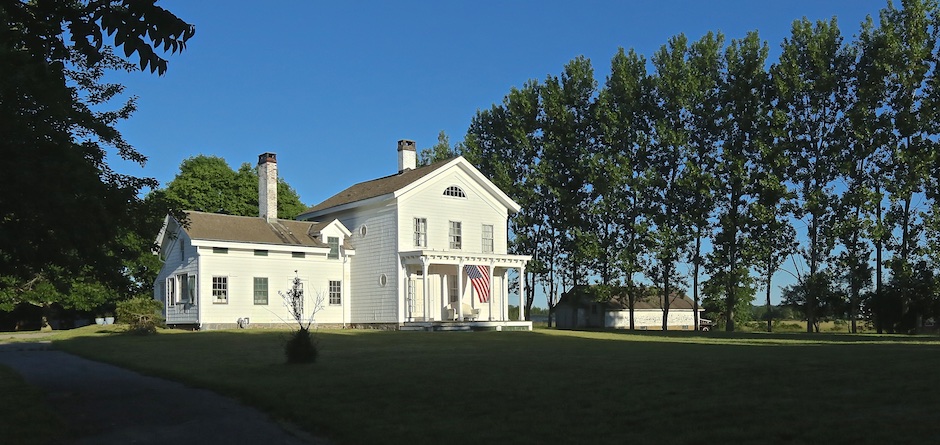
Hendrickson / Hillview Farm, 1866, Bridgehampton
This front-gable clapboard-clad farmhouse was built in 1866. The farmhouse, in excellent condition, has a half-round gable window and an Italianate-style porch. It retains associated barns (including a three-bay English threshing barn) and other agricultural buildings, including several poultry houses. The property was used as a farm until recently. — Town of Southampton.
______________________________________________
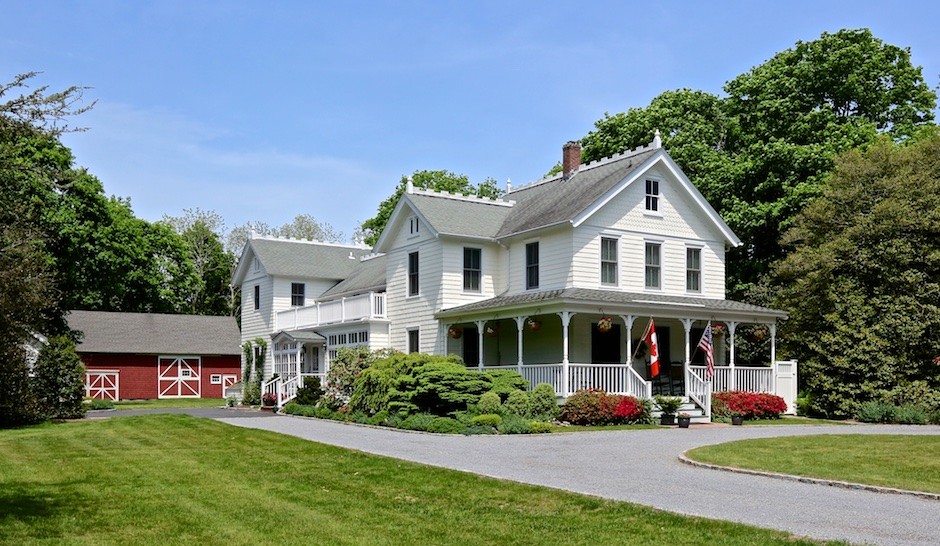
Capt. Jeremiah Rogers House, 1860s, Remsenburg
A large cross-gable wood-frame house clad in patterned wood shingles. A brick chimney rises from the center of the roof ridge; a decorative ridge board ornaments the roof. A wrap-around porch provides access to the front doorway. This house was built in the 1860s for Capt. Jeremiah Rogers, who picked up summer visitors at train station and brought them to the neighboring Ocean House Hotel. — Town of Southampton.
______________________________________________
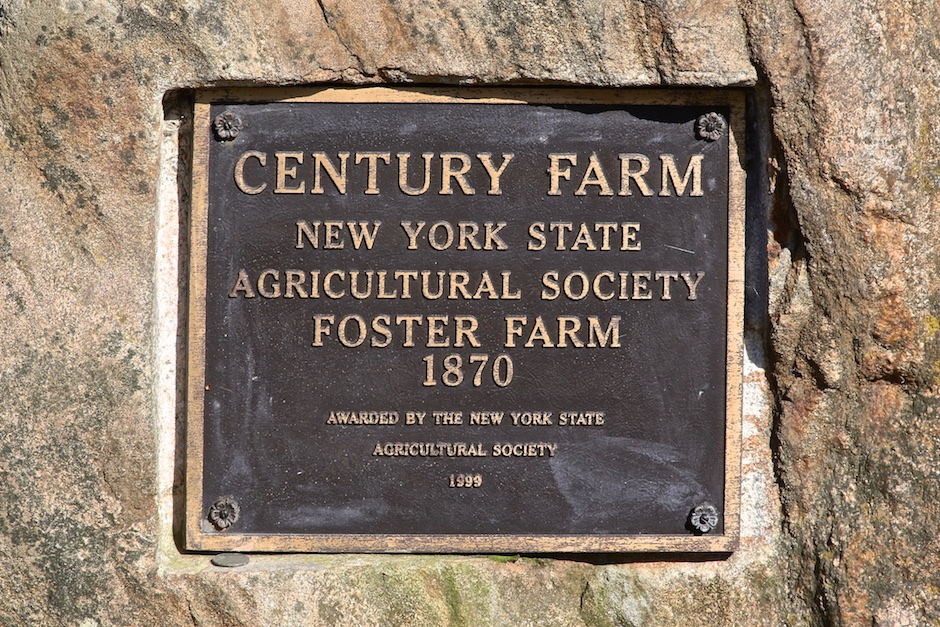
Foster Farm, Sagaponack. Awarded by the New York State Agricultural Society, 1999.
______________________________________________
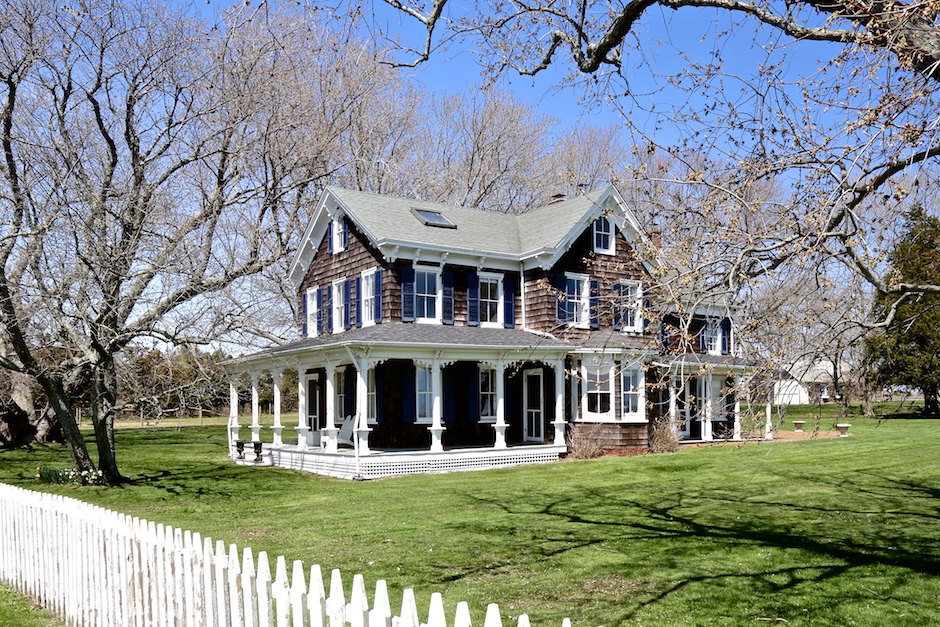
F.L. Marran House, ca. 1870, Water Mill
This 1870 cross-gable farmhouse is in an excellent state of preservation. The two-story shingle-clad structure features canted arch gable windows, a wrap-around porch with decorative brackets, and a projecting bay window. The windows throughout the house contain two-over-two-light double-hung sash. — Town of Southampton.
______________________________________________
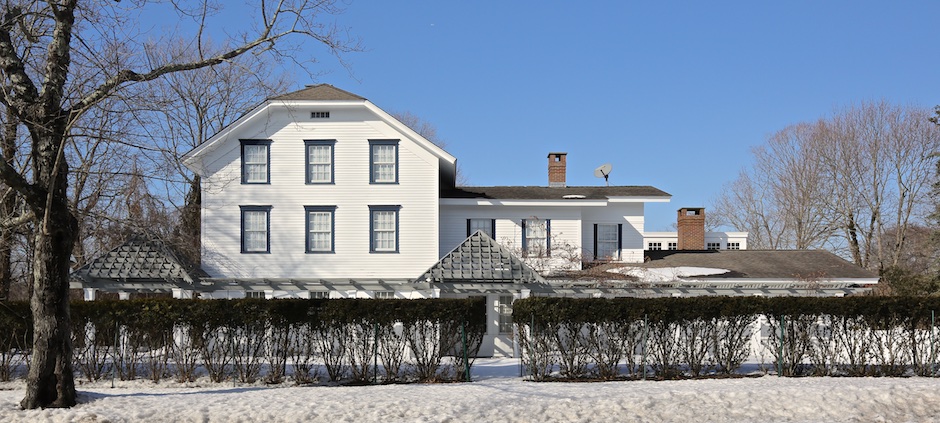
The Ocean House, 1871, Remsenburg
A large two-and-a-half-story three-bay frame structure clad in wood clapboard, this former hotel features a jerkinhead gable, and windows containing six-over-six-light double-hung sash. A two-story addition with a porch is appended on one side. Known as The Ocean House, and built 1871, this hotel was owned and operated by John W. Tuthill. It advertised luxury accommodations for summer visitors from New York City. — Town of Southampton.
______________________________________________
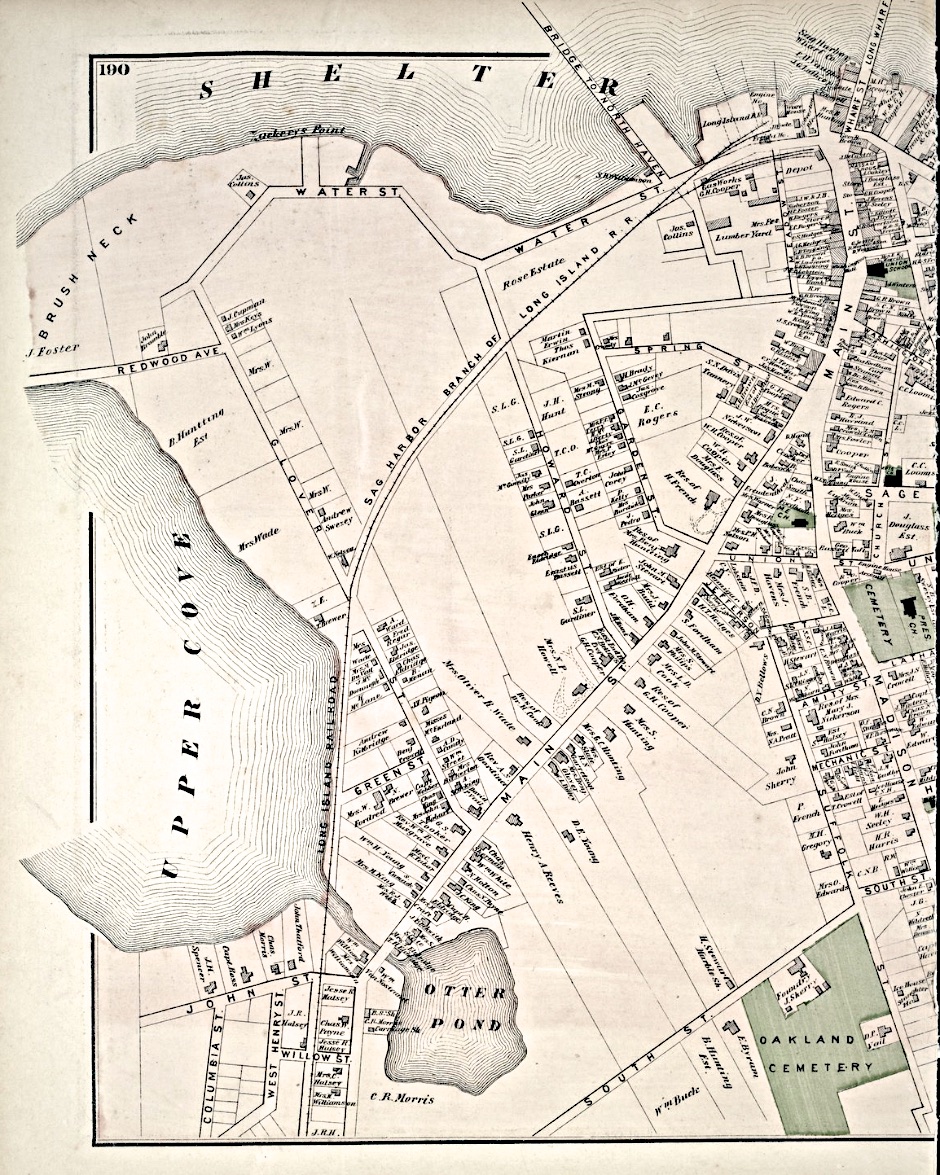
Style: “851985”

Style: “851985”
Sag Harbor, 1873. Archival map courtesy of the New York Public Library Digital Collection. Frederick W. Beers, cartographer. Beers, Comstock & Cline, publishers.
______________________________________________
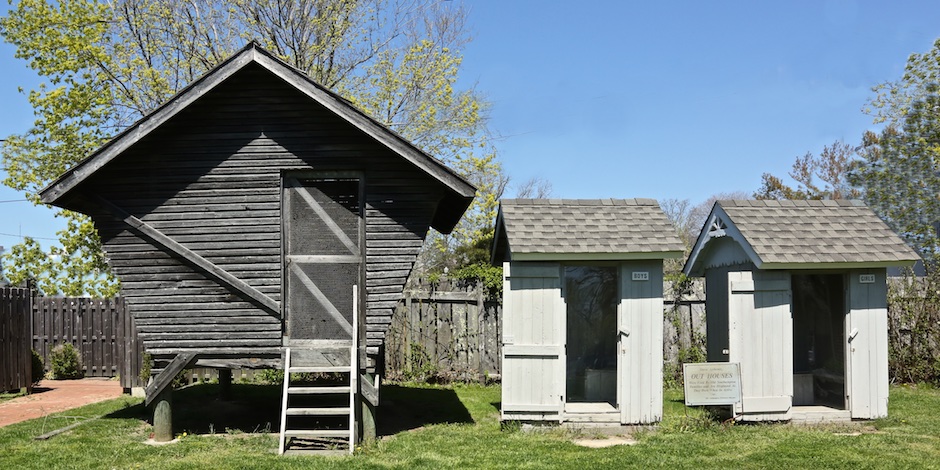
Corn Crib & Outhouses, Southampton Historical Museum
The late 19th century corn crib came from the Rose de Rose Estate on Hill Street. The building was used to store dried corn for animals. The elevated foundation, open slat siding and beveled frame encourage air circulation. The retractable stairs kept our pests. The gable roofed outhouse (left) for “Boys” was built in the late 19th century and owned by the White family on Long Springs Road. The gable roofed “Girls” outhouse, built in the late 19th century, came from the Baird family of West Neck. Oral history says that its fanciful trim reveals its use for ladies. — Southampton Historical Museum.
www.southamptonhistoricalmuseum.org
AAQ / Landmarks / Rogers Mansion Museum
______________________________________________
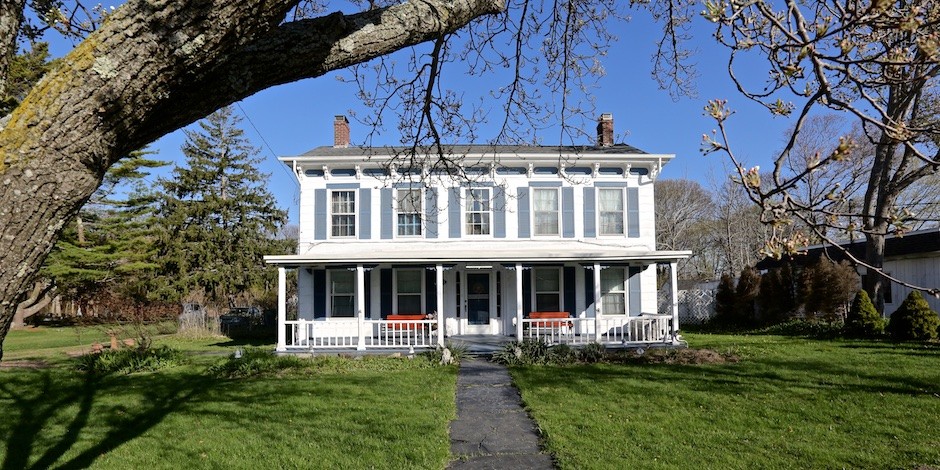
Downs Manor, 1876, East Quogue
This ornate two-story Italianate-style residence has a side-gable roof and a five-bay front façade. The central entry is flanked by narrow sidelights and pilasters. An ornate wood paneled door consistent with the Italianate style occupies the entry. A front porch is supported by chamfered posts with decorative brackets. The house is also distinguished by a bracketed cornice, triangular vents at attic level on the side elevations, and windows contain six-over-six-light double-hung sash. A brick chimney rises from each end of the roof ridge. A sign above the doorway of this house identifies it as Downs Manor, the home of Captain James E. Downs and wife, Ida Squires Downs, built 1876. — Town of Southampton.
______________________________________________
The Dunes, Southampton, 1877. Demolished by c. 1931.

Dr. T. Gaillard Thomas is credited by many as the founder of the Southampton summer colony. A prominent New York City physician, he was enraptured by Southampton’s leafy village streets, farm fields and pristine beaches when he first visited the area. He built the first summer cottage (The Dunes), known as The Birdcage locally, on the beach in 1877, and he remained a community leader until his death in 1903. — Southampton Historical Museum.
www.southamptonhistoricalmuseum.org
Described as “square, ugly, but very comfortable” in an 1888 Seaside Times article, it was given its distinct Second Empire style character later that year by the builder Richard W. Enoch. Most popular between 1855 and 1885, the Second Empire style was considered very forward thinking for its time….Other than its period-typical mansard roof, the three-and-a-half-story cottage was topped with a widow’s walk and deep overhanging eaves with paired brackets. Three hipped-roof dormers embellished each side of the roof, all with a double-hung shuttered window, while below, two stories of wraparound porches with turned posts, decorative railings, brackets and fretwork would prompt locals to nickname it “The Birdcage.” — Sally Spanburgh: The Southampton Cottages of Gin Lane / The History Press.
AAQ / Resource / Education, Books — Click Here
______________________________________________
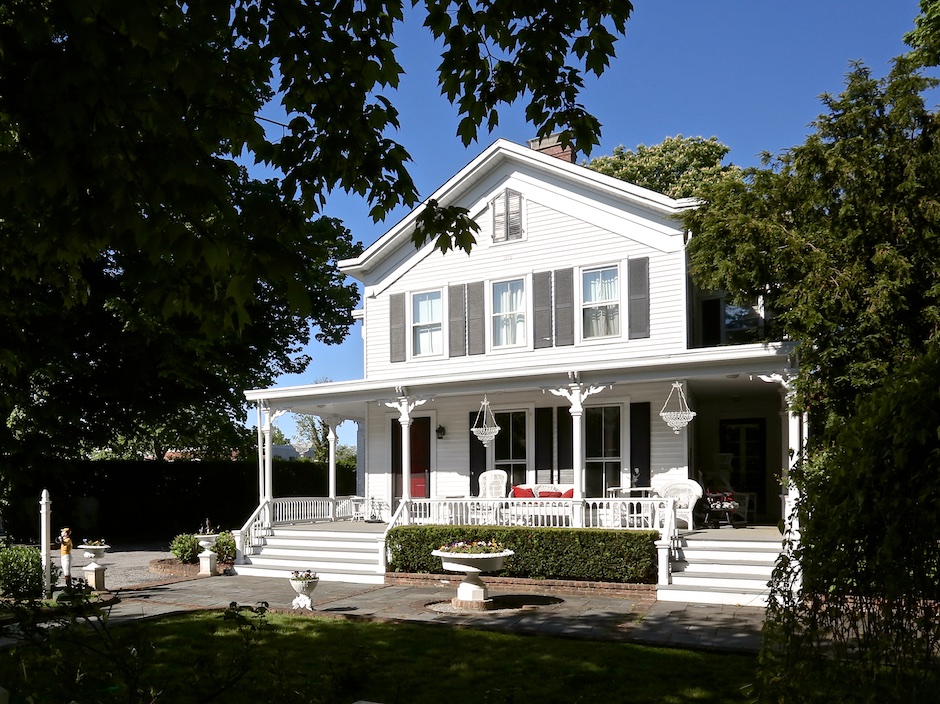
Dr. Edgar B. Mulford House, ca. 1878, Bridgehampton
Dr. Edgar B. Mulford, proud descendant of an East Hampton Town settler, trained at Bellevue Medical College in New York and built his Victorian period farmhouse to accommodate his practice, with a closet filled with colorful pills and tonics. A barn in the rear housed his horses and buggy, and later his Stanley Steamers. During the 1918 influenza pandemic that killed 650,000 Americans, civilian and military, Mulford lost only one patient, a success attributed to his advisories to residents not to travel….The Mulford House is a front-gable dwelling combining elements of the Gothic Revival and Italianate styles. The structure has pointed-arch gable windows and a bracketed entry porch. It is clad in wood clapboard and has two brick chimneys….A chestnut tree in the yard is said to exceed 250 years in age. — Town of Southampton.
______________________________________________

The Meadow Club, originated 1879, Southampton. Archival postcard courtesy of Eric Woodward.
The Meadow Club originated in the summer of 1879 with outdoor tea parties held by Mrs. Frederic H. Betts and her friend Mrs. Albert H. Buck in the meadow between their two houses. In 1887, the present site was bought and the club organized. By 1908, the club boasted thirty lawn tennis and two squash courts and remained open all winter so that off-season visitors, whose own homes were unheated, would have a warm place to stay. — Mary Cummings: Southampton, Images of America / Arcadia Publishing.
AAQ / Resource / Education, Books — Click Here.
______________________________________________
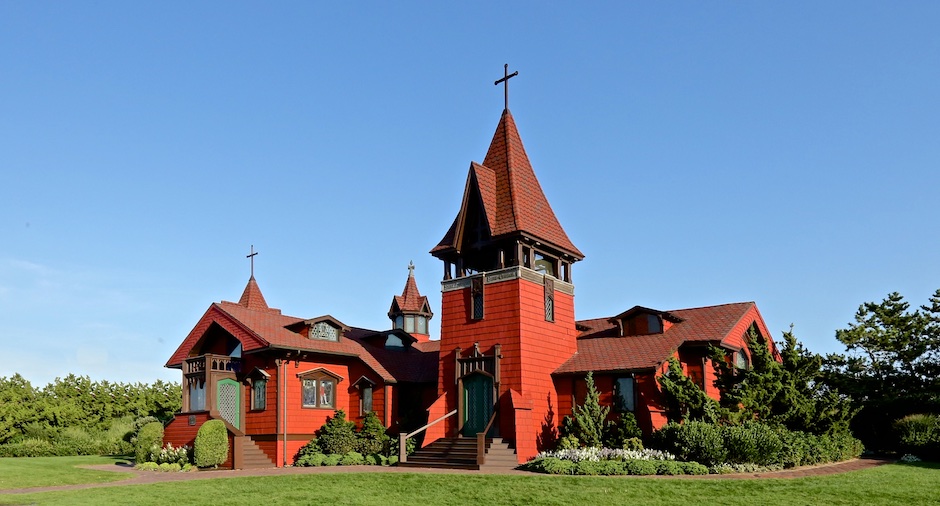
St. Andrews Dune Church, 1879, Southampton
Organized as St. Andrews-by-the-Sea, the building was donated by early Southampton summer resident Dr. T. Gaillard Thomas and moved to its present location in 1879. The structure had previously served as a life saving station on the ocean beach, but was decommissioned and adaptively reused as a summer chapel. Land for the church was donated by another notable summer resident, C. Wyllys Betts. While the building has been enlarged, it preserves the eclectic architecture associated with its original transformation as well as numerous stained glass windows designed by Tiffany Studios. — Historic Division, Southampton Town Clerk.
Historic Division, Southampton Town Clerk
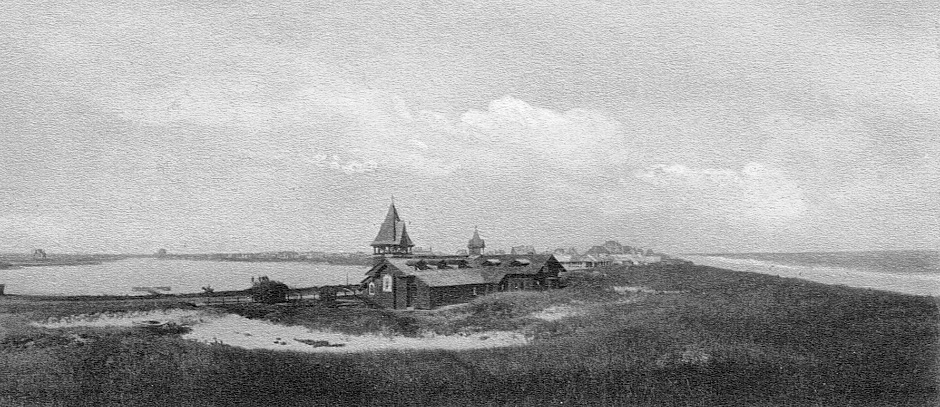
Archival Postcard courtesy of the Southampton Historical Museum.
______________________________________________
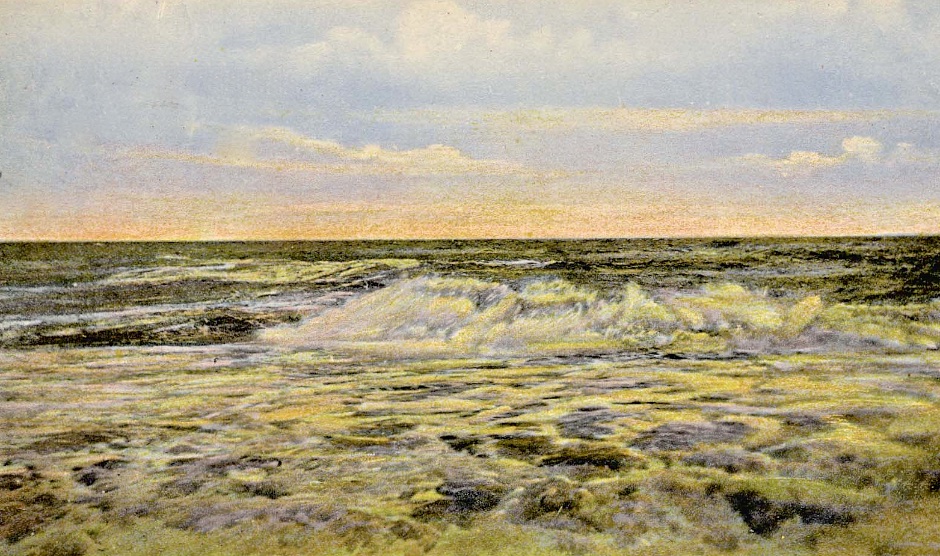
The Surf, Southampton. Archival postcard courtesy of the Southampton Historical Museum.
______________________________________________
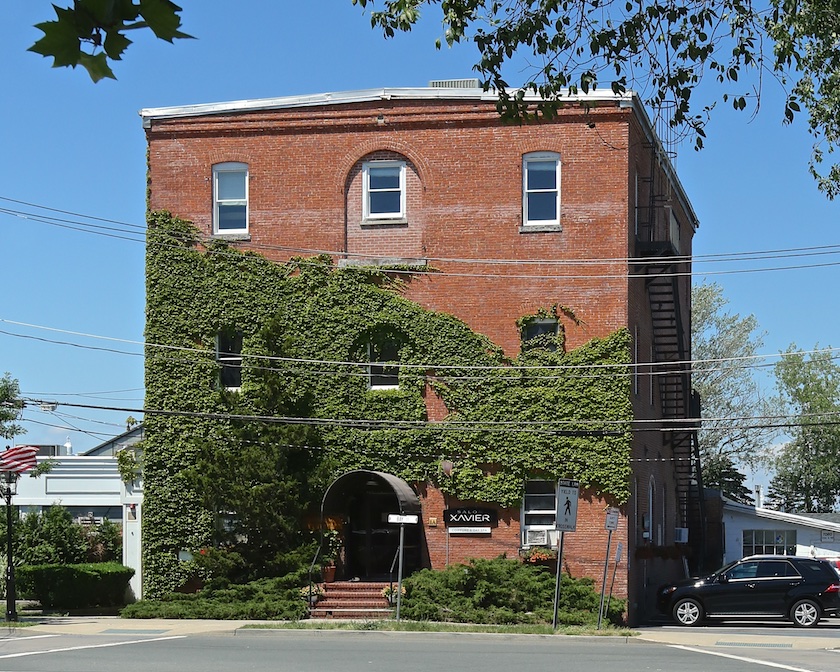
Sag Harbor Grain Company, 1879
This brick building on Bay Street was built in 1879 when it housed the Hampton Flour Mill, successor to the Maidstone Flour Mills, destroyed in the great fire of 1877. Later, the E.W. Bliss Co. administered torpedo testing at Long Beach and Gardiner’s Bay from this building before and during World War I, and Agawam and Grumman aircraft companies occupied the building, producing parts for the Apollo Lunar Module which landed on the moon in 1969. — Historic Division, Southampton Town Clerk.
Historic Division, Southampton Town Clerk
______________________________________________
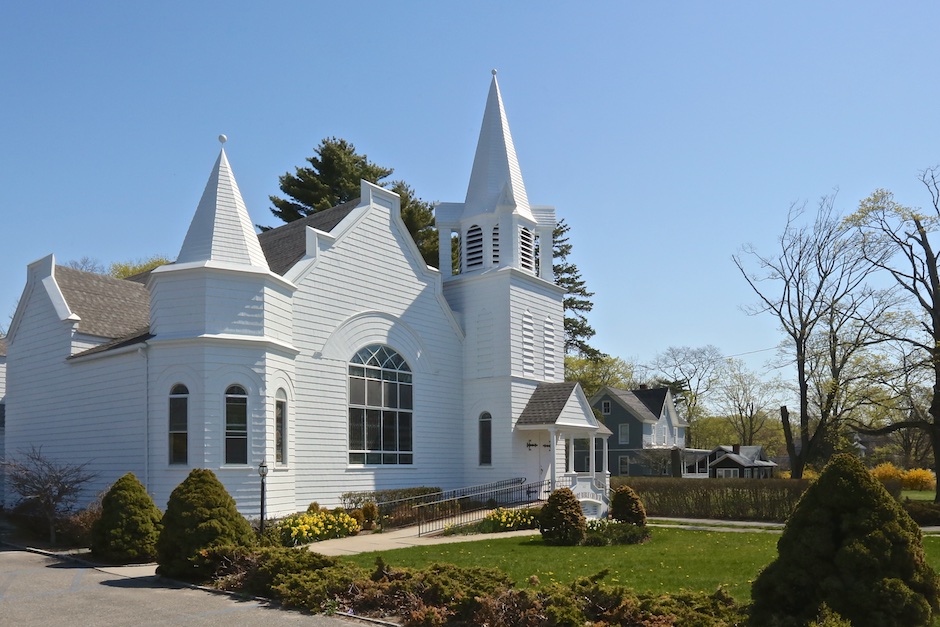
Eastport Bible Church, early 1880s.
The Eastport Bible Church is an eclectic structure exhibiting elements of the Gothic, Romanesque, and Neoclassical styles. The wood-frame structure is clad in shingles and features both pointed-arch and round-arch windows, some containing stained glass. — Town of Southampton.
______________________________________________
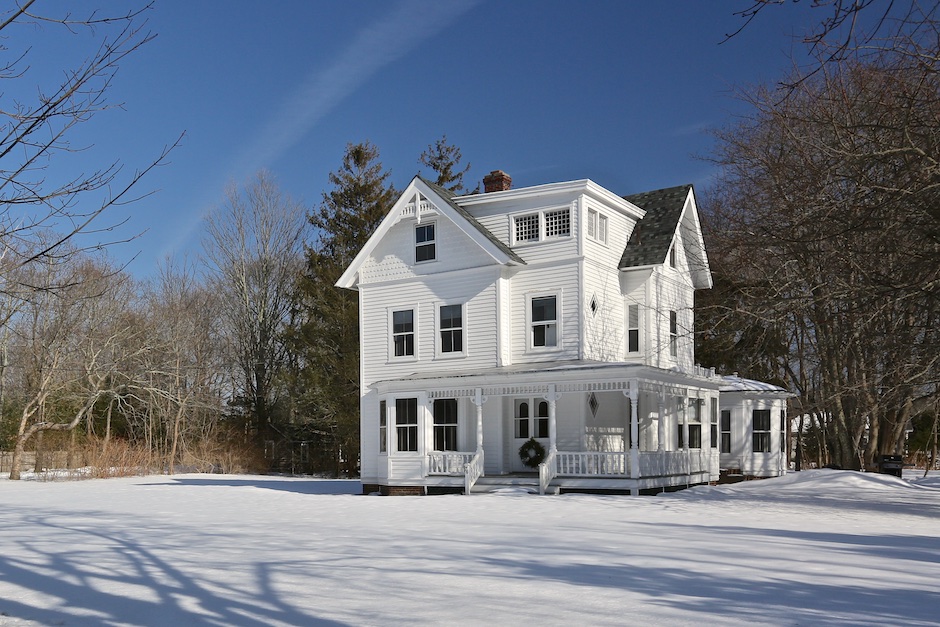
F.C. Raynor House, 1880s, Remsenburg
This late 19th century cross-gable house is an example of the Queen Ann style. It has both scalloped shingle and clapboard siding, gable ornamentation, projecting bay windows, and a wrap-around porch with turned spindles and decorative brackets. Its windows contain two-over-two-light double-hung sash. A somewhat unusual feature is a shed-roofed tower occupying the reentrant angle. The front doorway, which contains double doors with round-arched windows is located on this feature. Multi-light Queen Anne-style windows are featured on the upper stories of the tower. According to the Remsenburg-Speonk Hamlet study, this is the F. C. Raynor House built in the 1880s for Fred Raynor. The house “came pre-cut to the Speonk railroad freight station, was picked up by wagon and transported to the site and assembled on top of a small brick cellar.” — Town of Southampton.
______________________________________________

“Pen Craig,” S. Davies Craig Residence, 1880, Quogue
Named “Pen Craig” meaning “Home of the Craig’s” in Welsh, the house was built in
1880 by Samuel Davies Craig, one of Quogue’s earliest summer residents. Craig purchased the land for his estate from the Stevens farm. The house originally contained a ballroom which was later moved east on Quogue Street in 1900 to become the main part of a new house built in that year, “La Concha.” Samuel D. Craig (1842-1904) and his wife Ellen McDonald Baylis (1843-1916) are buried behind the Church of the Atonement beneath two granite tablets enclosed by a tall iron fence. — Historic Division, Southampton Town Clerk.
Historic Division, Southampton Town Clerk
______________________________________________
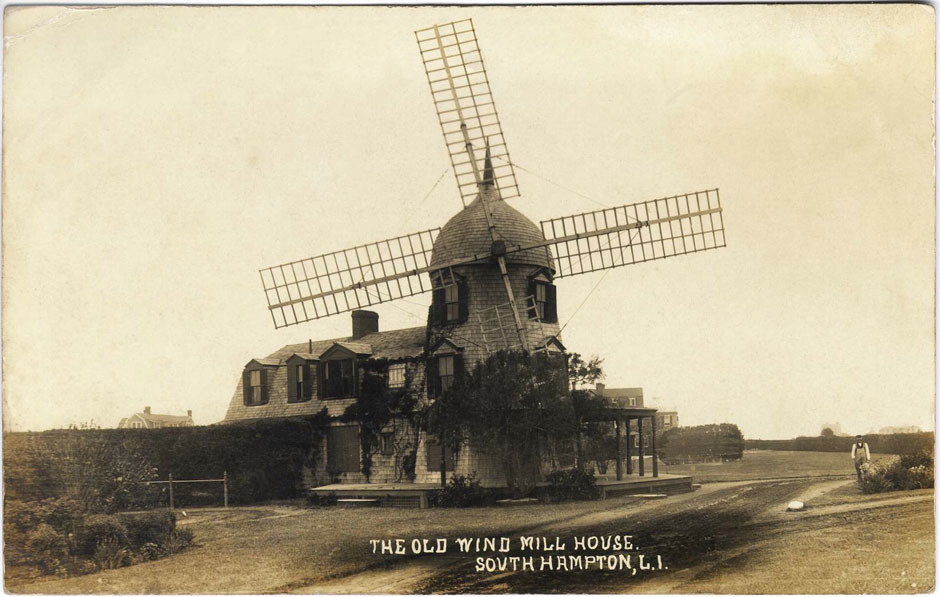
Wind Mill House, 1880, Southampton. Archival postcard, circa 1907. Photographer: Hess. Courtesy of Eric Woodward.
Before 1880 C. Wyllys Betts had a small two-story structure…oriented to take best advantage of prevailing ocean breezes and sun angles by being slightly askew from the road rather than parallel to it. In 1880 he purchased the operational Good Ground (now Hampton Bays) windmill and relocated it to his property, attaching it to his house, removing its interior mechanisms, and adding windows with gabled, pedimented tops and a wraparound porch to complete the renovation….The three-story Good Ground windmill was built in 1807 on Shelter Island for Sylvester Dering and is unique because of its ogee-shaped cap topped with a tall, pointed spire. — Sally Spanburgh: The Southampton Cottages of Gin Lane / The History Press.
AAQ / Resource / Education, Books — Click Here.
______________________________________________
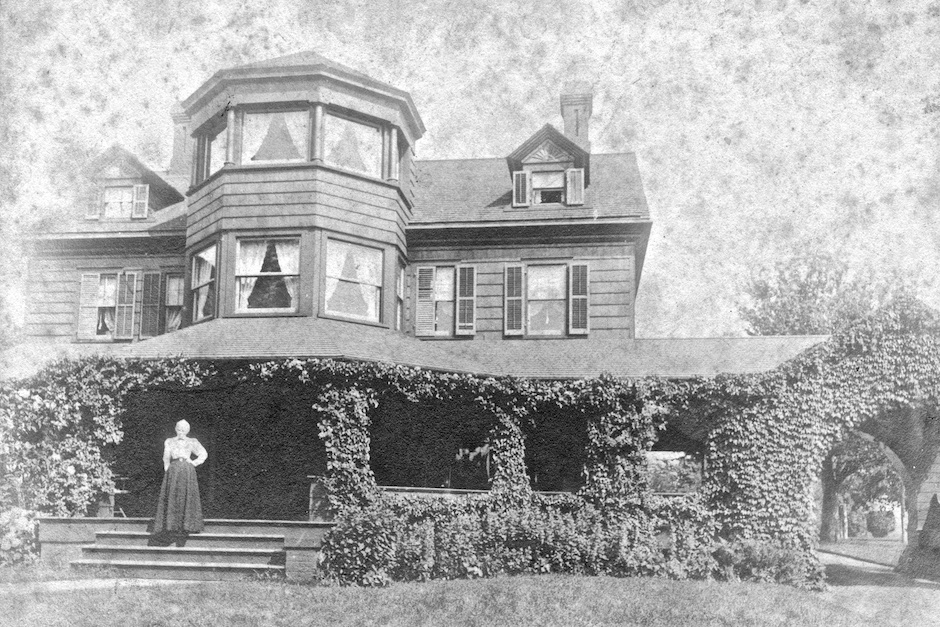
Ludlow Grange, 1880, Bridgehampton. Archival photograph courtesy of the Bridgehampton Historical Museum.
This house was built by Captain Isaac Ludlow (1807–1871), who first went to sea at the age of fifteen and made twenty voyages on whaling ships (eight of them as commander of his vessel) before he retired in about 1857. Rewarded with a fortune that enabled him to build this imposing residence, he also earned the gratitude of the British Admiralty for having rescued 105 of the passengers and crew of a British bark that was wrecked in the Indian Ocean in 1835. — Mary Cummings: Southampton, Images of America / Arcadia Publishing.
AAQ / Resource / Education, Books — Click Here.
______________________________________________
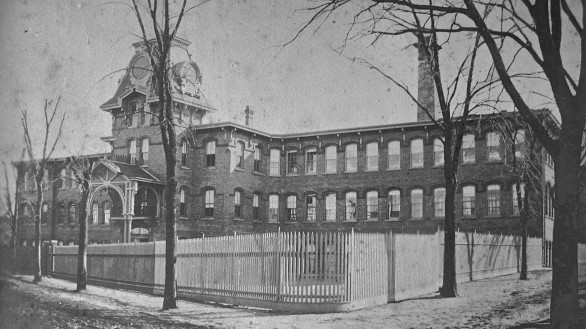
Fahys Watchcase Factory, Sag Harbor, 1881 (photo taken 1889)
Bulova Watchcase Factory
Built in the early 1880s, Joseph Fahys’ watchcase factory was established in Sag Harbor at the invitation of the Business Aid Committee which persuaded the New Jersey entrepreneur to relocate his enterprise here as a way of revitalizing the local economy. Over 400 people were put to work, thus filling a devastating employment gap precipitated by the decline of the whaling industry in the 1860s. After closing in 1931, the factory was reopened and operated by the Bulova Watch Company between 1937 and 1980. Abandoned and vacant for many years, the factory structure has now undergone major renovations and conversion into high-end condominiums. — Historic Division, Southampton Town Clerk.

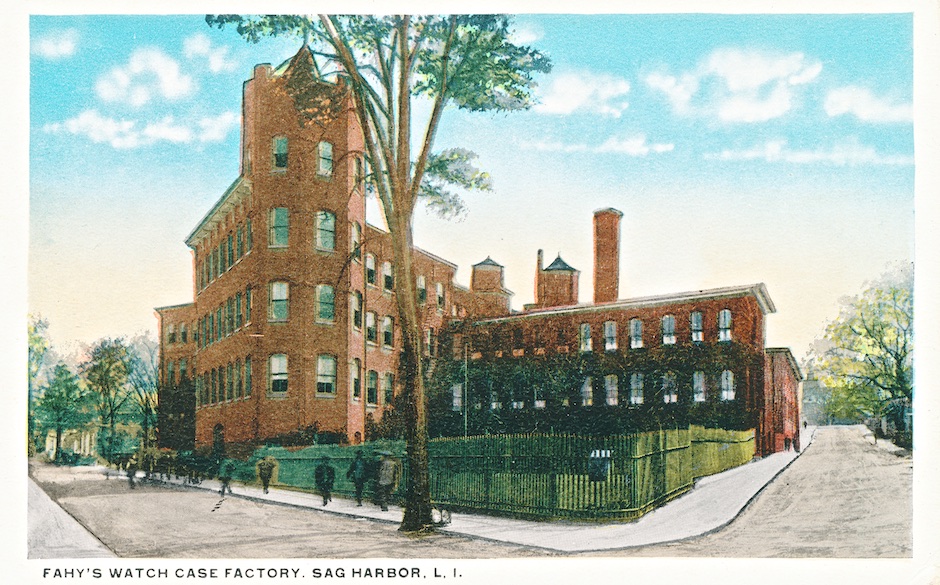 Archival Postcard courtesy of Southampton Historical Museum.
Archival Postcard courtesy of Southampton Historical Museum.
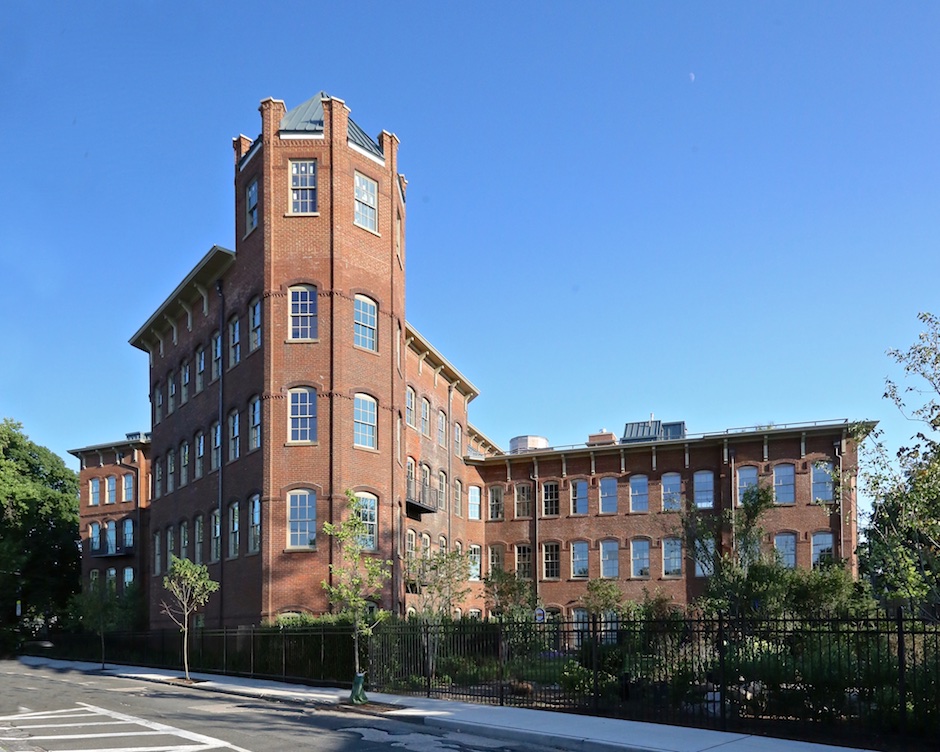
Watchcase, Sag Harbor, 2015
———————-
Visit: Watchcase, Sag Harbor — Restoration
Town of Southampton: Modern Era, 1916 / 2016
______________________________________________
Tremedden, 1882. Demolished in the 1930s.

Tremedden, 1882, Bridgehampton
The era of the elaborate summer “cottage” began early in Bridgehampton, where fountain pen magnate Richard Easterbrook built “Tremedden” on the corner of Sagaponack Road and Ocean Road over a five-year period from 1877 to 1882. In 1916 Charles Evans Hughes, who was running for president at that time, went to bed in this house on election night believing he had been elected only to find the next morning that late returns from California gave the vote to Woodrow Wilson. “Tremedden,” which is Welsh for “trees in the meadow,” was torn down during the Great Depression when money for the upkeep of such a lavish estate was hard to come by. — Mary Cummings, Southampton, Images of America / Arcadia Publishing.
AAQ / Resource / Education, Books — Click Here.
=====================================================
FAIR LEA, 1882 – 1893, SOUTHAMPTON VILLAGE
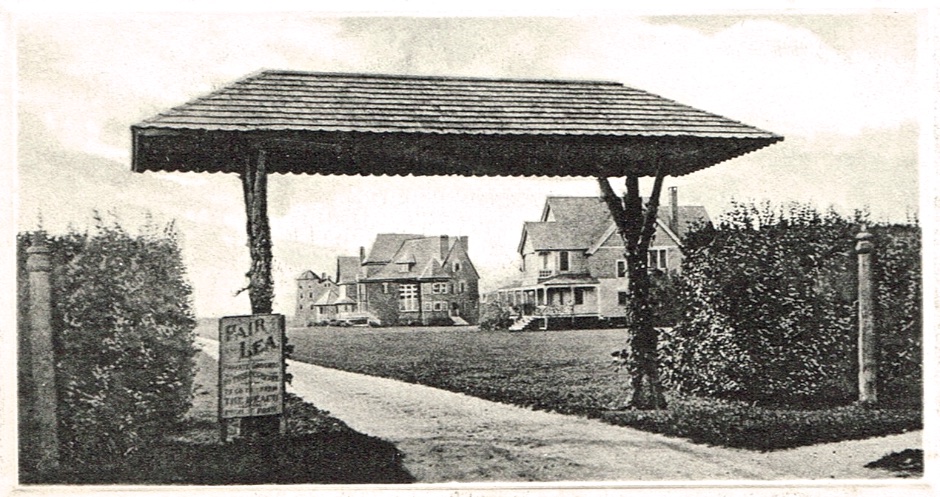
Fair Lea, 1882 / 1893, Southampton. Archival postcard courtesy of the Southampton Historical Museum.
In June 1874, Alfred Nelson bought eight acres of undeveloped land at the foot of South Main Street from John Allen of Southampton. During the several years following his purchase, he added two more acres and improved the property with the necessary infrastructure to enable the creation of a park-like compound of six cottages — one for him and his wife and the others to let. Five cottages were ultimately realized, and the entire enclave became known as Fair Lea, a twist on Alfred’s wife’s middle name, Fairlee. — Sally Spanburgh, The Southampton Cottages of Gin Lane / The History Press.
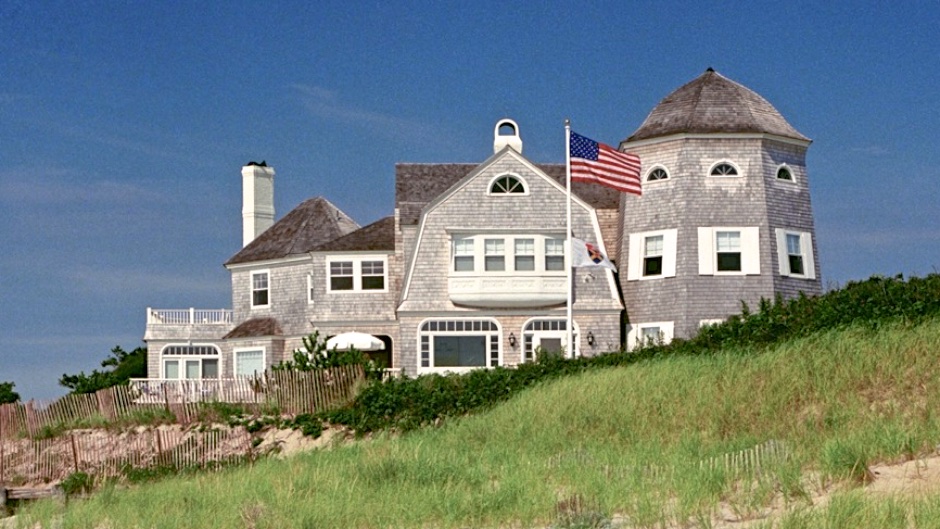
Over Look, 1889, Fair Lea, Southampton
The fourth of the Fair Lea cottages to be built, Over Look…captures the individuality of Southampton’s original cottage colony like none of the other residences. It commands a breathtaking position on top of the dunes overlooking the great Atlantic Ocean.
Over Look is a three-story Shingle-style cottage with a four-story tower evocative of the eighteenth-century windmills that decorate Long Island, anchoring its position and making the house a visual landmark along Southampton’s shoreline. The house’s principal volume is topped with a gambrel roof and embellished with half-round windows and trim work, transoms and sidelights with curved corners, decorative eave brackets and railings, and an oriel bay window that captures the morning light. — Sally Spanburgh, The Southampton Cottages of Gin Lane / The History Press.
AAQ / Resource / Education, Books — Click Here.
=====================================================
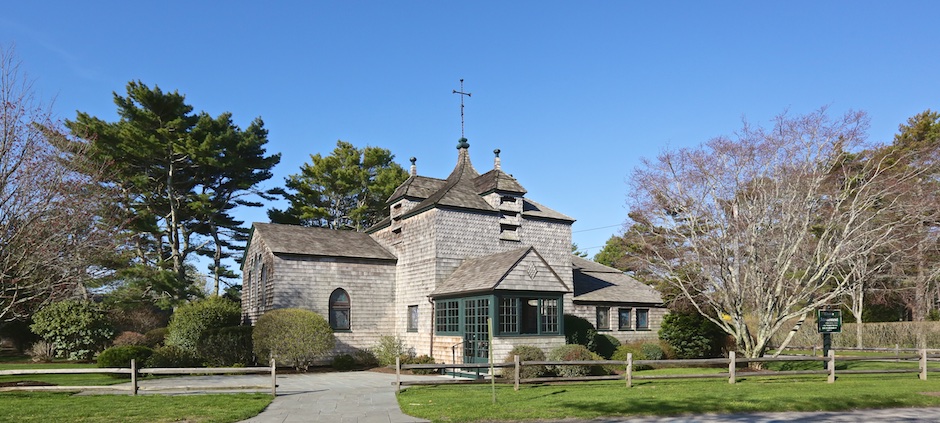
Church of the Atonement, Quogue, 1884. Sydney V. Stratton, architect, of McKim, Mead & White.
Constructed between 1883 and 1884, land for the whimsical Shingle Style “Church of
the Atonement” was given by Samuel Davies Craig. The architect was Sydney V. Stratton, an employee of McKim, Mead & White; windows were commissioned by Mrs. Craig and came from Cox, Son and Buckley of London and Tiffany studios. The first service was held by Abram Littlejohn, first Bishop of the Episcopal Diocese of Long Island, on July 13, 1884. The church has served the village for summer worship ever since, as originally intended. In 1966 a rectory was built, financed by public subscription of the congregation and other village residents. — Historic Division, Southampton Town Clerk.
Historic Division, Southampton Town Clerk.
______________________________________________
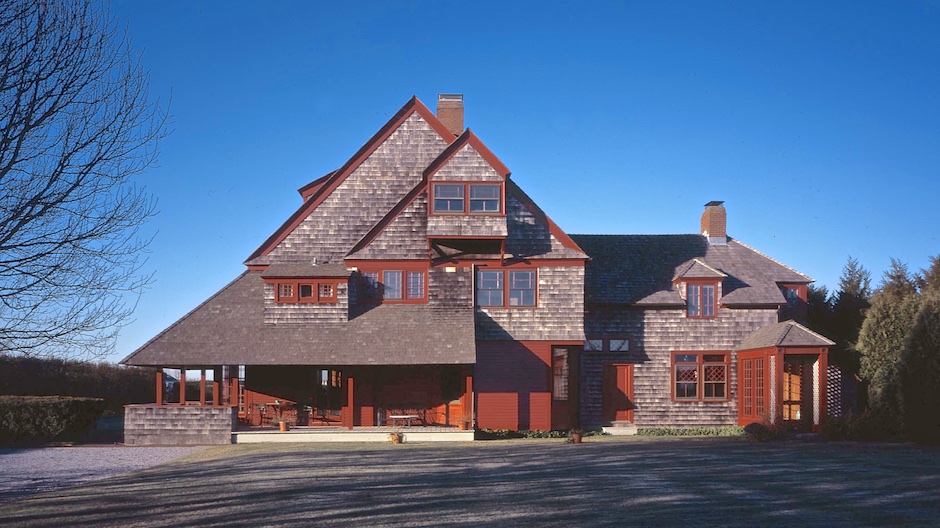
Rosemary Lodge, 1884, Water Mill. Frederick W. Stickney, architect.
Rosemary Lodge was constructed in 1884; additions in keeping with the character of the house were added later. The Shingle-style structure was designed by Frederick W. Stickney. —– Town of Southampton.
With the building of Rosemary Lodge in 1884, the Reverend Henry Turnbell Rose began an odyssey that combined personal history with design and craftsmanship. Over a thirty-seven year period, Rose took a simple Shingle-style cottage in Water Mill and transformed it into a creation all his own, infused with charm, wit and warmth. — Anne Surchin, Houses of the Hamptons / Acanthus Press, co-authored with Gary Lawrance.
New York State & National Registers of Historic Places
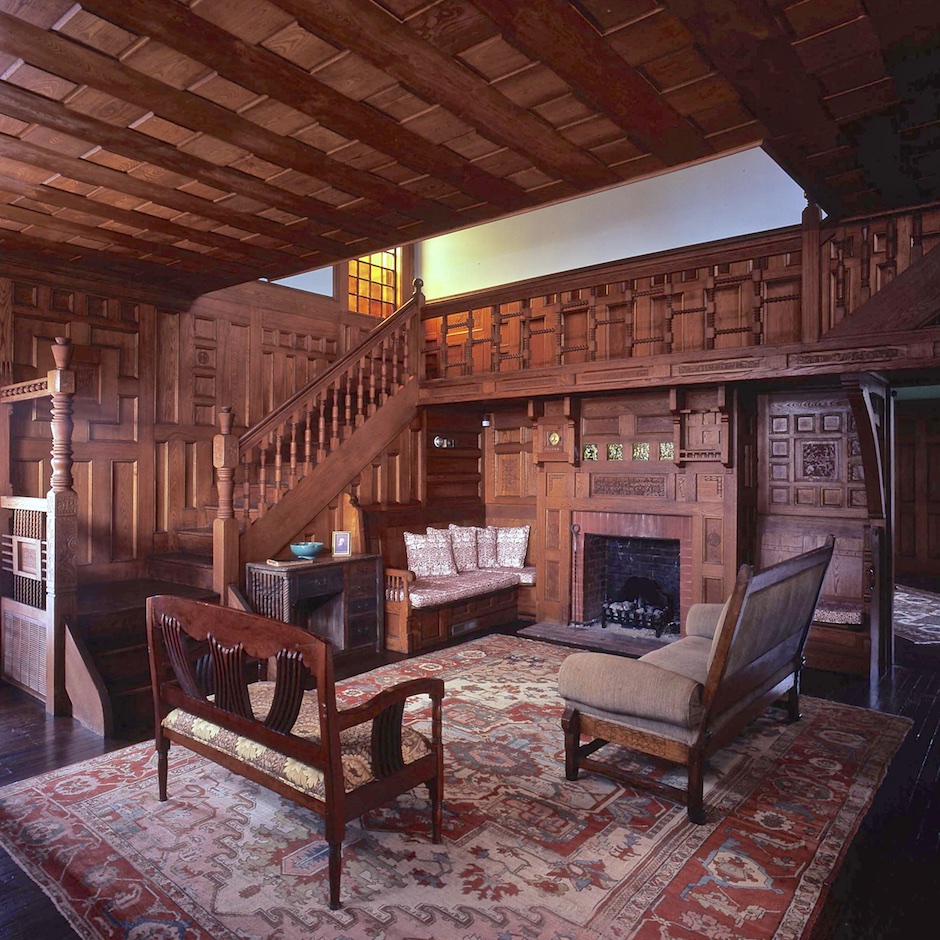
Living Hall and Stair, Rosemary Lodge
A sizable fireplace, decorated with green ceramic tiles above the surround, is the dominant element in the living hall. Centered below a balcony supported by curving wood brackets, this fireplace is flanked by inset paneling containing numerous hidden cupboards. The woodwork contains carved floral motifs, ships, butterflies, the family cat Sarah, birds and inscriptions, such as Shakespeare’s “Hold fast all I give thee,” which is found in the church cupboard. — Anne Surchin: Houses of the Hamptons / Acanthus Press, co-authored with Gary Lawrance.
AAQ / Resource / Education, Books — Click Here.
______________________________________________

The Dolphins, 1885, Southampton. McKim, Mead & White, Architects.
One of the few remaining, authentic houses by the architectural firm of McKim, Mead & White, was built in 1885 for the James Hampden Robb family on the west shore of Lake Agawam. It was among the earliest summer cottages in Southampton and helped inspire the trend toward sprawling seaside villas, rambling Shingle-style houses and 50-room cottages of every conceivable style. — Anne Surchin, Houses of the Hamptons / Acanthus Press, co-authored with Gary Lawrance.
AAQ / Resource / Education, Books — Click Here
______________________________________________
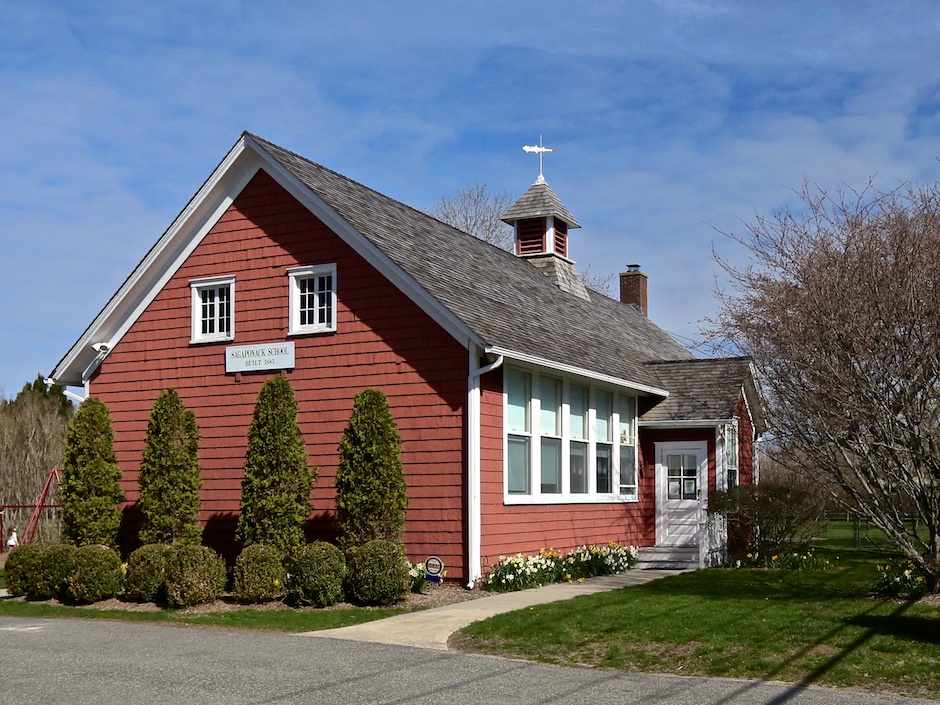
Sagaponack School, 1885
Still in active use today, the Sagaponack School was built in 1885. It was the only
public building in the village until Sagaponack’s incorporation in 2005, necessitating construction of a new Village Hall. The schoolhouse is one-and-one-half story high on a brick foundation, with a cupola and decorative wall shingles. East and west entries retain porticoes. — Historic Division, Southampton Town Clerk.
Historic Division, Southampton Town Clerk.
______________________________________________
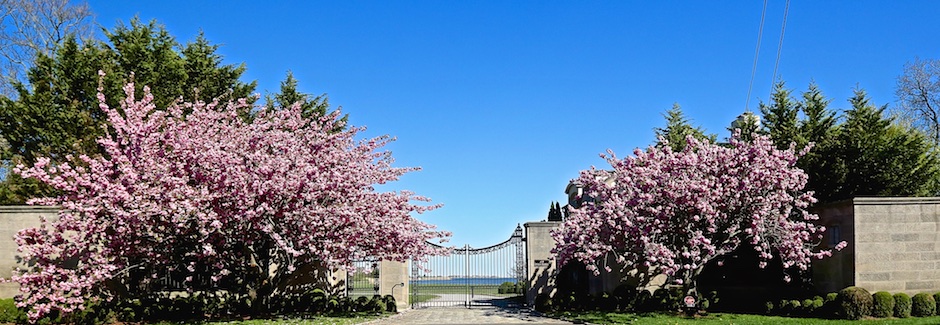
Lombard & Ayres, 1887 / Keyes, 1895 / Morse 1909, Order of the Sisters of Saint Dominic (Villa Maria) 1931, Water Mill
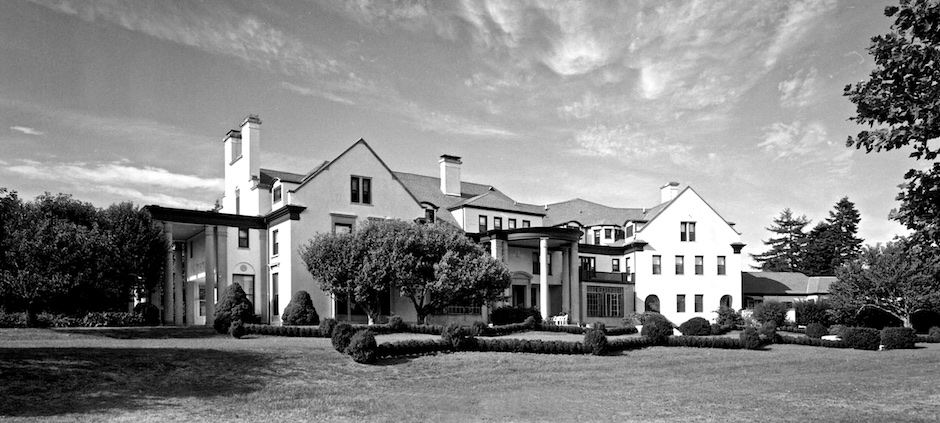
In 1887 Josiah Lombard and Marshall Ayres erected a sprawling Queen Anne-Shingle-style house known as Red Gables, for its red roof….A decade later, Brooklyn shipbuilder Edward Phinley Morse commissioned well-known Brooklyn architect Frank Freeman to completely recast Red Gables into an estate house. Cited in 1890 by architecture critic Montgomery Schuyler for having produced “the most artistic examples of the Richardson Romanesque in our domestic architecture,” Frank Freeman also worked in the Queen Anne and Shingle styles in a manner consistent with the 1887 Red Gables. Consequently, there has been continuous speculation that he was also the original architect for the house. Regardless, Freeman’s 1919 alteration of Red Gables was a complete transmogrification. By stripping the exterior of its shingles and eccentric features, adding extensions to substantially enlarge the building, and covering the whole with a coat of stucco, he transformed the bumptious late Victorian cottage into a stately Italian villa by the sea. A grand ballroom, added to the west, boasts a massive portico with limestone columns and Egyptian capitals. Centered in the rear facade, a second, semi-circular, classical portico serves as an open-air extension of the entrance foyer….
Sold for $ 250,000 in 1931 to the Sisters of the Order of St. Dominic of Amityville, it became the Villa Maria High School, a boarding institution for young women preparing for life in the sisterhood…. — Anne Surchin, Houses of the Hamptons / Acanthus Press, co-authored with Gary Lawrance.
In 1992, the complex was renamed the Siena Spirituality Center and a new structure was added to the property for use as an arts and crafts center. The Sisters of Saint Dominic sold the property in 2005, and it is now a private residence. — Town of Southampton.


Central Stairway, Villa Maria
Inside Villa Maria, the dominant feature is a spectacular spiraling three-story stairwell with oak balustrades and limestone walls. Halls adjoin the landings on each floor level, providing a comfortable transition between the nine master bedrooms with eight baths and the public spaces below. Featuring an unusual amount of natural light for a building of this era, the principal rooms, except for a cozy wood-paneled library off the stairwell foyer, are oriented to the water view. — Anne Surchin, Houses of the Hamptons / Acanthus Press, co-authored with Gary Lawrence.
AAQ Resource / Education / Books … Click here.
______________________________________________
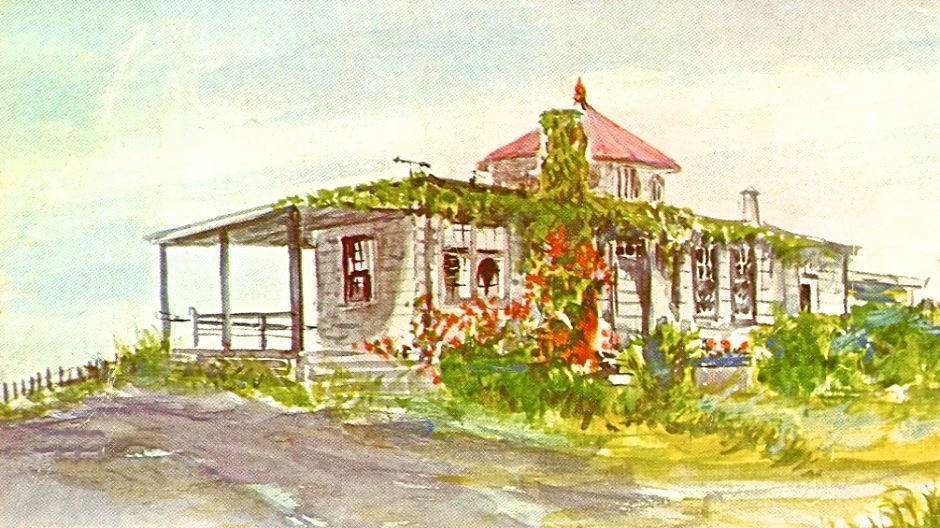
Shinnecock Hills Railroad Station, 1887. Archival postcard courtesy of the Southampton Historical Museum.
Developer Austin Corbin built this turreted structure in 1887 as a station and a real estate sales office. He and a group of New York investors had formed the Long Island Improvement Company and purchased the hills (3,200 acres in Shinnecock Hills) in the 1880s. The station, which commanded a sweeping view of the then-barren hills, served as a train stop until the late 1930s. Corbin’s company went bankrupt in 1893 and he died in 1896, but the mail was still picked up by train and the building continued to function as a post office even when trains no longer stopped there. By 1973, the station was boarded up and abandoned but it has since been salvaged as a private home. —– Mary Cummings: Southampton, Images of America Series / Arcadia Publishing.
Southampton Town Landmark
AAQ / Resource / Education, Books — Click Here.
______________________________________________
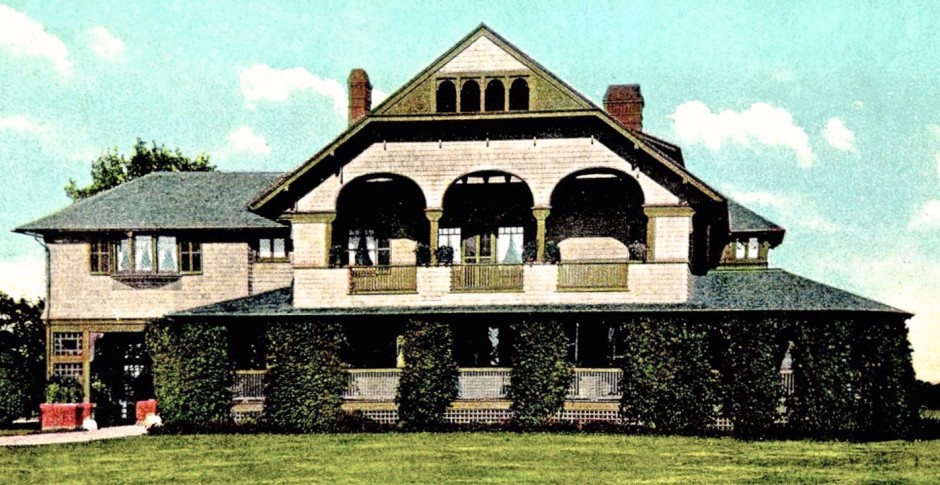
“Wyndecote” (Robert H. Robertson House), 1887-88, Southampton. Robert H. Robertson, architect.
Architect Robert H. Robertson (1849-1919), who designed a summer cottage named “Sunnymeade” in 1886-87 next door for Dr. Francis Markoe, created his own residence in 1887-88. The picturesque main front, with its two-tiered open porch and arched second story, is oddly suggestive of a Swiss chalet. Robertson’s other contributions to Southampton Village were the original Rogers Memorial Library and Hall located at the corner of Main Street and Jobs Lane (1895) and, with his architect son T. Markoe Robertson, the Southampton Hospital (1911-13). — Historic Division, Southampton Town Clerk.
Historic Division, Southampton Town Clerk
Archival postcard courtesy of Eric Woodward.
______________________________________________
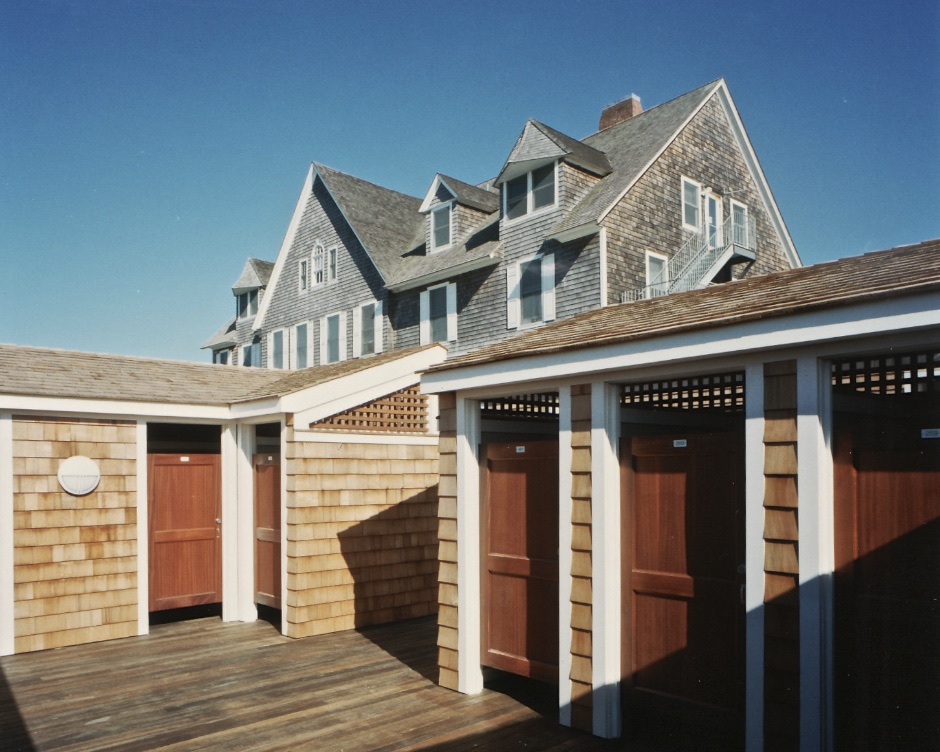
Over Dune, 1888, Southampton, became the Southampton Bath & Tennis Club in the 1950s. Cabanas were rebuilt in 2004 (Pospisll & Brown Architects).
In December, 1887, Mrs. William P. Douglas bought an ocean-side parcel for herself and her husband containing about five and a half acres for $ 12, 650. Construction on their summer cottage began the following year, and it today functions as a private beach club.
William Proctor Douglas was a successful capitalist, stockholder and investor in a number of banks, insurance companies and other enterprises, as well as an avid and accomplished polo player and yachtsman, winning America’s Cup in 1871. In addition to his own success, he also inherited great wealth from his father, George Douglas of Scotland, including a large Greek-Revival style manor on three hundred acres in what is now known as Douglaston….
In the early 1950s, Over Dune became the Southampton Bath & Tennis Club, whose membership is remembered as originally consisting of mostly local residents…It remains a club today, nestled among its members’ properties, which now include more socially elite individuals mixed in with descendants of the founding members. — Sally Spanburgh: The Southampton Cottages of Gin Lane / The History Press.
AAQ / Resource / Education, Book — Click Here.
______________________________________________
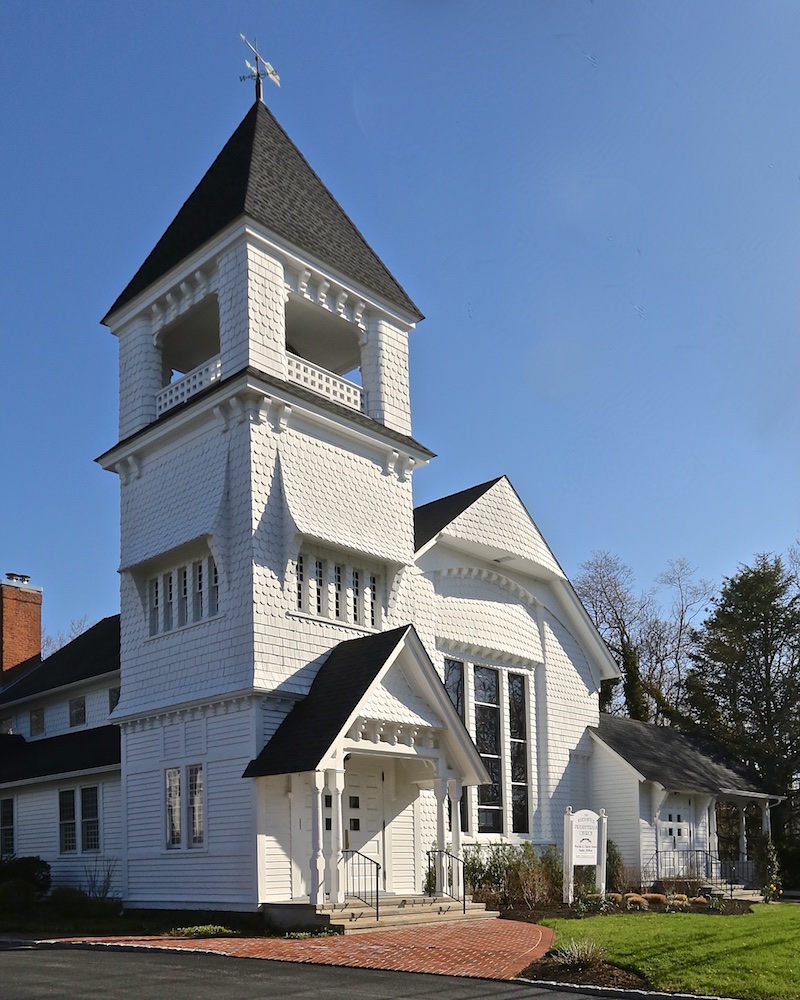
Westhampton Presbyterian Church, 1888. George Skidmore, architect.
Westhampton Presbyterian Church is constructed in the Shingle style and with straight wooden clapboards, straight and fish scale shingles, this structure has a tower at the front and an exterior chimney at the rear. The roof is covered with dark asphalt shingles and the structure is painted white. The current building was constructed in 1888 and designed by Riverhead architect George Skidmore. — Town of Southampton.
______________________________________________

East Hampton Lumber and Coal Mill, Bridgehampton, 1889 (extant section now Battle Iron and Bronze Shop).
Now the Battle Iron and Bronze Shop, this brick industrial structure was originally part of the East Hampton Lumber and Coal Mill, founded by J.E. Huntting in 1889. The company carried items such as millwork, lumber, brick, cement, and coal. The structure is a portion of what was once a larger complex. — Town of Southampton.
______________________________________________
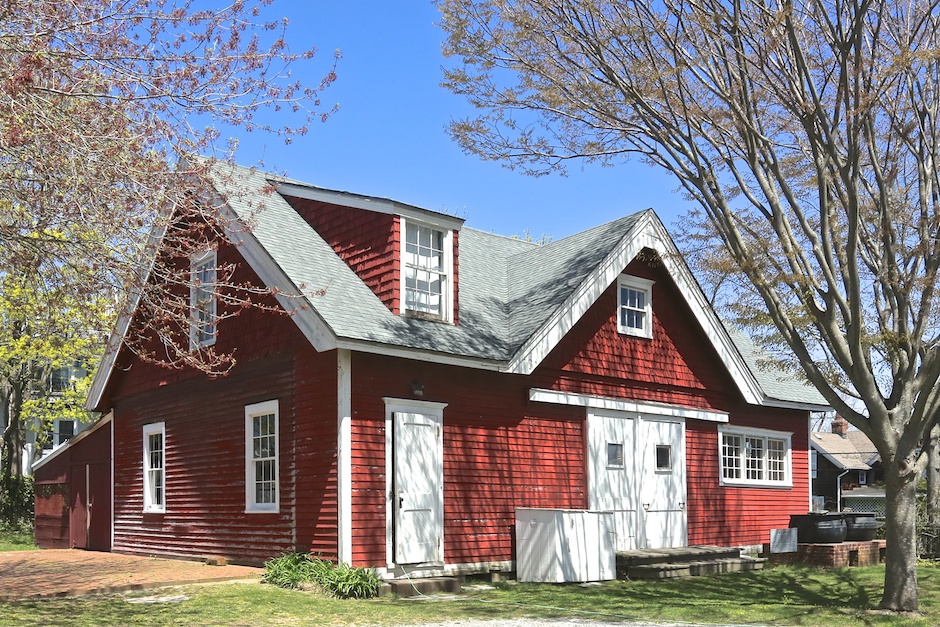
Nugent Carriage House (original site), Southampton Historical Museum, 1890s.
The Nugent Carriage House was built in the 1890s by Dr. John Nugent who owned the Rogers Mansion from 1889 to 1899. The sole “Village Street” structure that was not moved to the site, it originally had a ramp extending from the sliding doors to a drive leading to Meeting House Lane. The first in a line of prominent local physicians, Dr. Nugent was a member of Southampton Hospital’s first medical board. Both of his sons also practiced in the area. The building currently houses the museum’s collection of whaling artifacts. — Southampton Historical Museum.
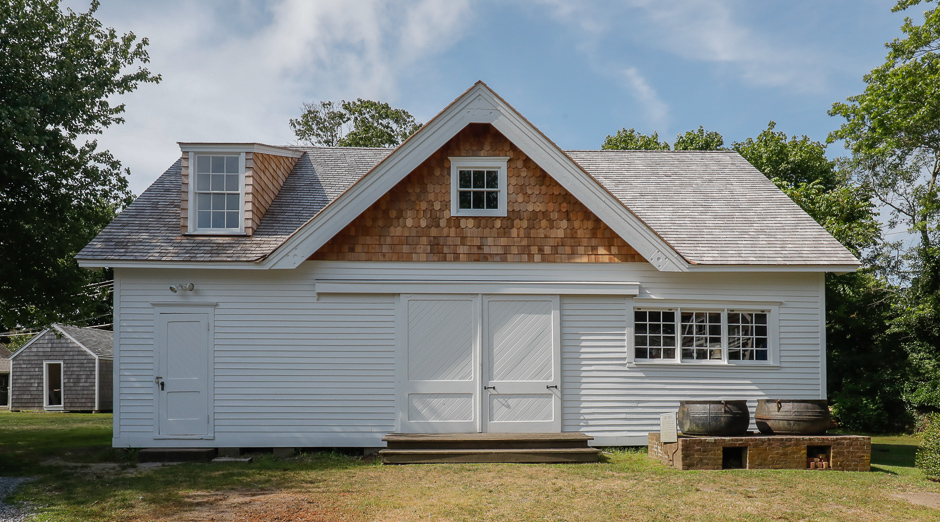 August 1, 2019
August 1, 2019
 Carriage House Thrift Shop
Carriage House Thrift Shop
——————
www.southamptonhistoricalmuseum.org
============================================
Post Crossing, Southampton
Post Crossing preserves a neighborhood of remarkable integrity. Houses ranges in style from Queen Anne to Colonial Revival, and include Four Squares and large-scale Victorians with broad porches and decorative shingles. The street was laid out in the late 19th century and quickly developed, resulting in its homogeneous collection of houses that share common features such as ample size, front yard setbacks, wood shingle siding, and decorative architectural trim. — Historic Division, Southampton Town Clerk.
Historic Division, Southampton Town Clerk
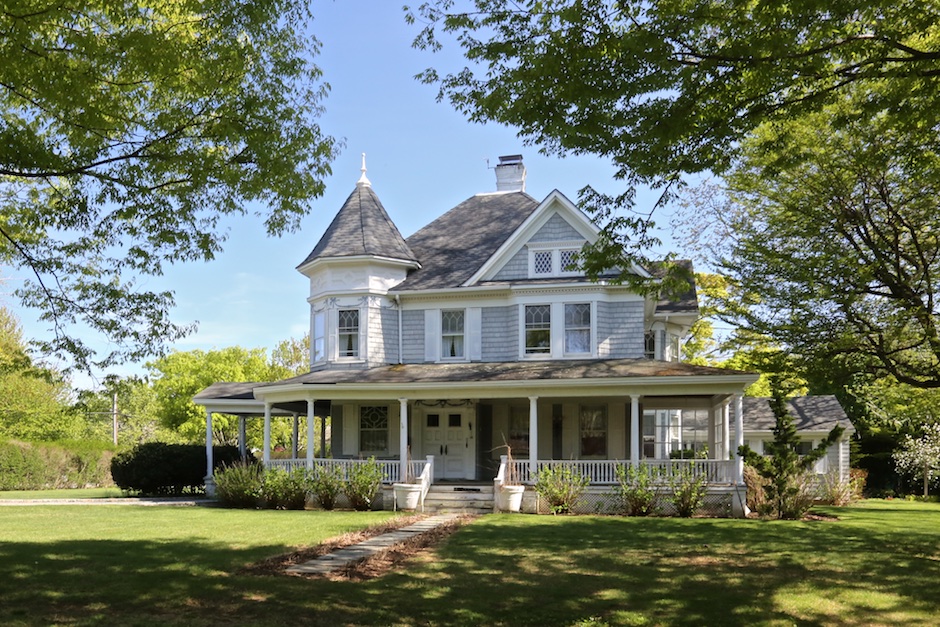

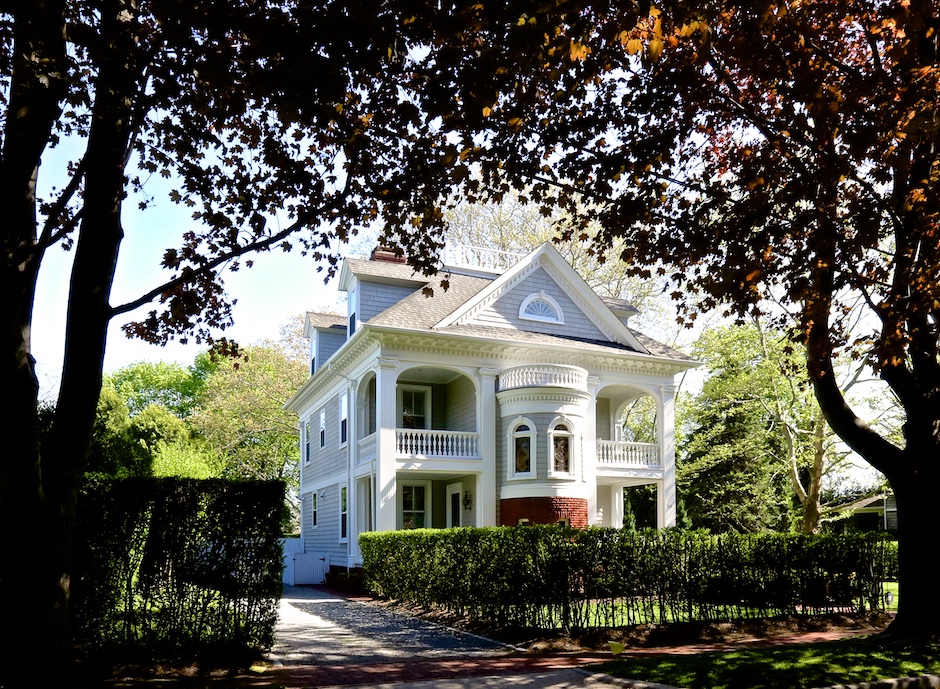
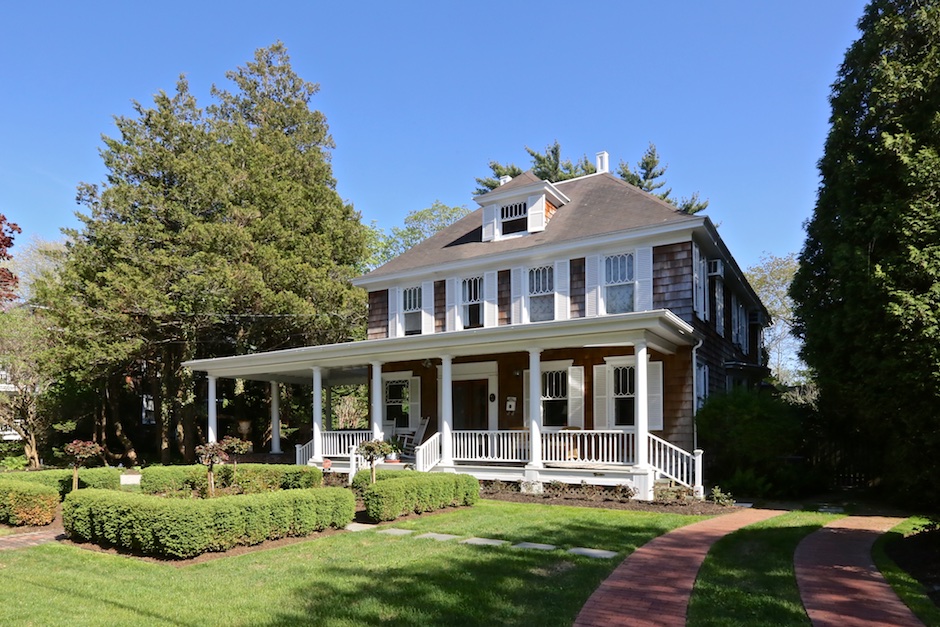
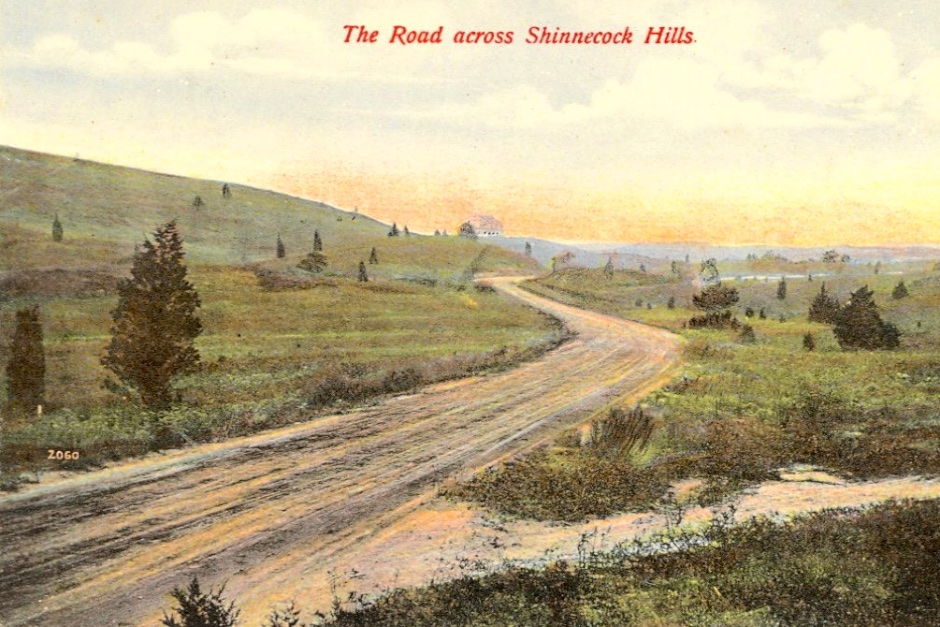
Archival postcard courtesy of Southampton Historical Museum
============================================
Shinnecock Summer School of Art: The Art Village, 1891 to 1902

Illustration courtesy of Mary Cummings, author of Southampton, Images of America / Arcadia Publishing.
In 1891 the Shinnecock Summer School of Art, the first out-of-doors art school in the United States, opened to allow amateur and professional art students from all over the country to study plein air painting under the tutelage of artist William Merritt Chase….
Work from the Shinnecock Summer School of Art was exhibited in Philadelphia, in Pittsburgh, and at the New York Art School. School alumni included artists Joseph Stella, Howard Chandler Christy, Rockwell Kent, Charles W. Hawthorne, Arthur B. Frost, and Marshall Fry, and architects John Russell Pope, Grosvenor Atterbury, and Katharine Budd….
The Shinnecock Summer School of Art closed its doors when Chase resigned as headmaster after the 1902 season. Despite its brief history, the school gave expression to a distinctly new form of American landscape painting. Other plein air schools, based on the Shinnecock model, opened around the United States in places such as Cape Cod, Massachusetts; Mendota, Minnesota; and, in 1914, Carmel, California, where the Carmel School of Art again had Chase as head teacher. — Anne Surchin, Houses of the Hamptons / Acanthus Press, co-authored with Gary Lawrance.
AAQ / Resource / Education, Books — Click Here.
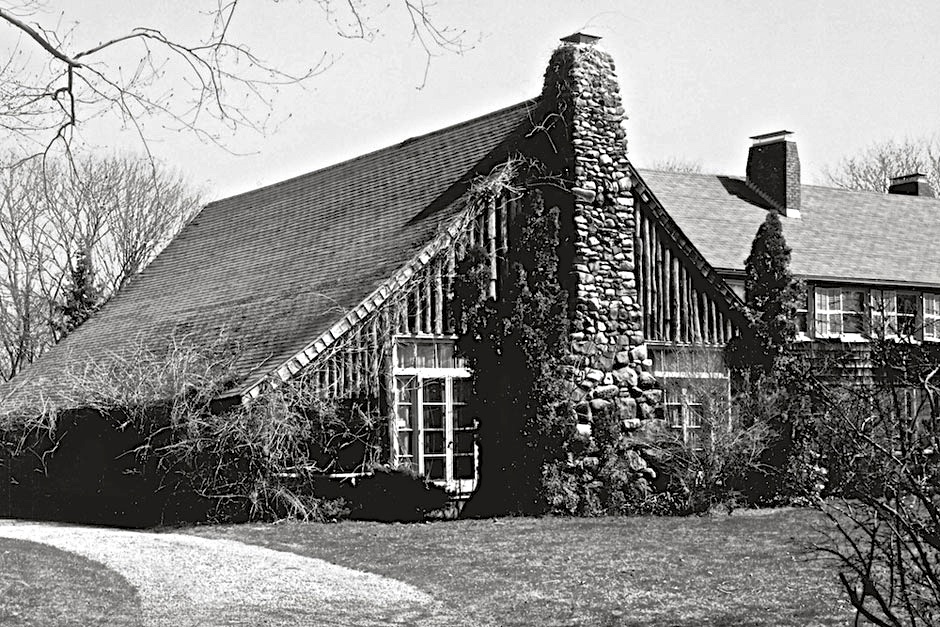
William Merritt Chase’s Art Studio, Art Village, Shinnecock Hills
This structure was the Art Studio, the classroom used by the students and their instructor, William Merritt Chase. Also designed by Janet and her husband William Hoyt, the structure has a sweeping Dutch kick roof, a massive exterior stone chimney of local stone, and an unpainted shingle exterior.— Town of Southampton.
AAQ / Content / Retrospective: Shinnecock Summer School of Art — The Art Village by Anne Surchin
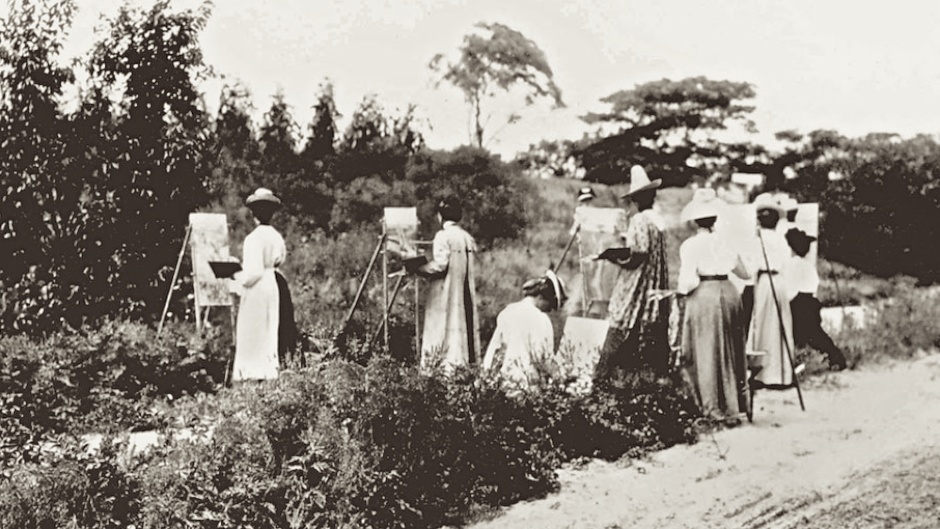
Art Village, Southampton, 1892. Archival photograph courtesy of the Southampton Historical Museum.
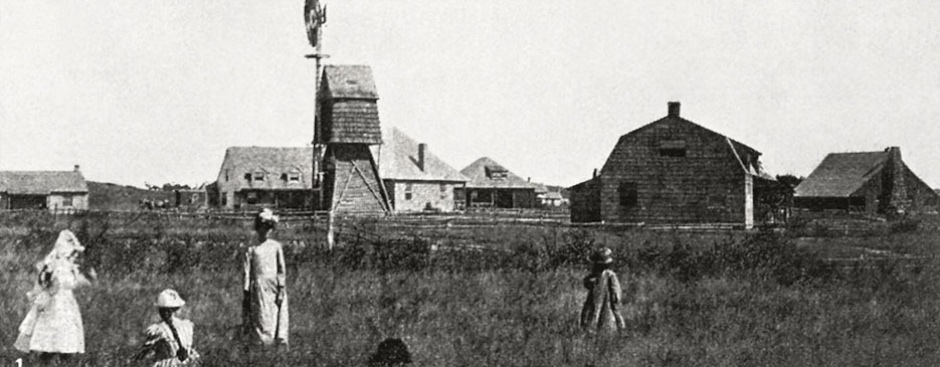
Art Village, Southampton, 1892. Archival photograph courtesy of the Southampton Historical Museum.
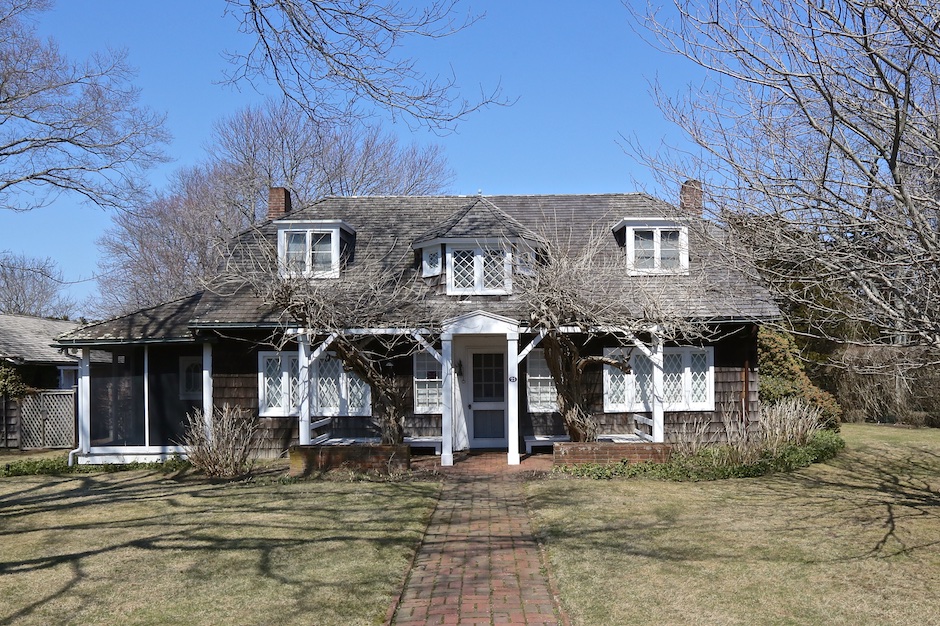
Art Village Cottage, ca. 1892, Shinnecock Hills.
One of the original ca. 1892 Art Village cottages. This single-story side-gable house is sided in wood shingles and retains a wood shingle-clad jerkinhead roof. The symmetrical façade includes a central doorway flanked by ribbon windows with original diamond-pane wood sash. The house has a central hip-roofed dormer flanked by two smaller shed-roofed dormer. Brick chimneys rise from either end of the roof. — Town of Southampton.
______________________________________________
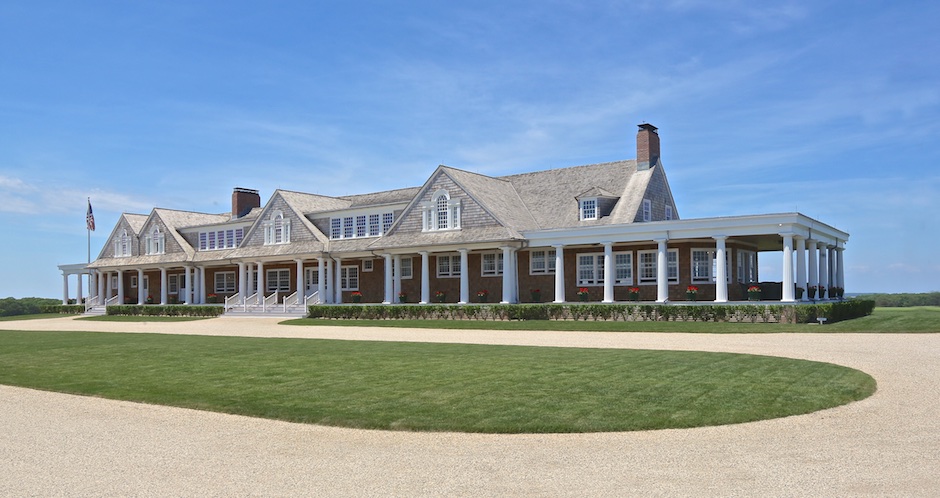
Shinnecock Hills Golf Club, 1892, Tuckahoe. Stanford White, architect.
Shinnecock Hills Golf Club is listed on the State and National Registers of Historic Places. It purports to be the oldest formally organized golf club in the United States (1891) with the oldest clubhouse (1892). It was also the first golf club to admit women. William K. Vanderbilt, Duncan Cryder, and Edward Meade scouted the location and financed the golf course’s construction. The course itself was designed by Willie Davis of the Royal Montreal Golf Club. Stanford White designed the clubhouse. In 1894, Willie Dunn from Scotland added six additional holes. Subsequent alterations to the golf course design were contributed by noted golf course designers Charles B. MacDonald, Seth Raynor, and William Flynn in the early 20th century.
New York State and National Registers of Historic Places
______________________________________________
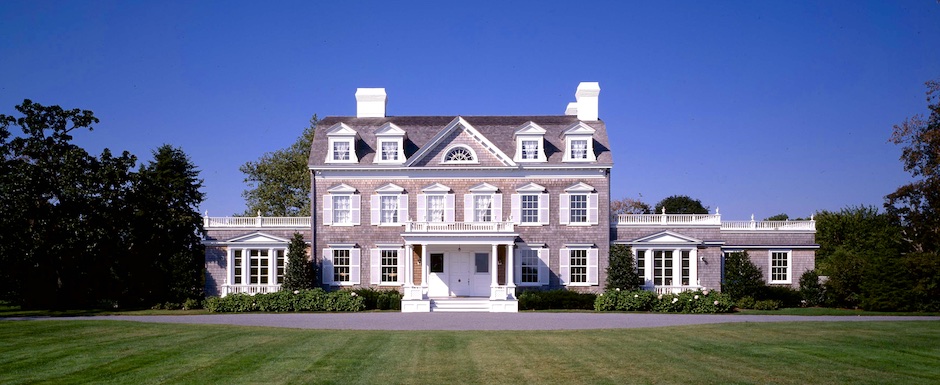
“Keewaydin” (formerly “Claverack”), 1892, Southampton. Robert Henderson Robertson, architect.
Built for Thomas H. Barber c. 1892, “Claverack” is a stately shingle-clad high-style Georgian
Revival house that boasts a gambrel roof with over scaled chimneys, symmetrical fenestration with pedimented dormers, and a covered entryway supported on paired columns and surmounted by a decorative wood railing. The side wings of one story are original. Landscape architects were Olmstead Brothers of Boston. A later owner, Henry Mortimer, renamed the estate “Keewaydin.” — Historic Division, Southampton Town Clerk.
Historic Division, Southampton Town Clerk
———————-
Claverack (clover field in Dutch) was one of the first large-scale cottages built in the estate section of Southampton. Designed in 1892 by notable architect Robert Henderson Robertson, a fellow summer colonist, Claverack epitomized formal living conducted with casual simplicity….
A Dutch door centered under a generously scaled front entry porch, supported by double Doric columns, leads into the main entrance hall. The hall, which has carved moldings and door surrounds topped by pediments, bisects the center of the house in an east-west direction and leads to the rear gardens through an arched opening under the main stairwell. This stairwell, with its lacy carved spindles and half-story landings rises through the full three stories of the structure….
The 20-room structure was once part of a 30-acre estate that consisted of greenhouses, garages, outbuildings and orchards….Originally designed by the firm of Olmsted Brothers, the grounds featured boxwood and perennial gardens known throughout the Hamptons for their splendor. According to Louise Shelton in her 1915 book Beautiful Gardens in America, “Southampton…in proportion to population has probably a greater number of gardens than any town in the state, almost all of them designed and developed by their owners, who have thus delightfully expressed their love of flowers.”…
In 1973, Henry Tilford Mortimer, Claverack’s fourth owner, renamed the estate Keewaydin, after his father’s Tuxedo Park estate, a name derived from Henry Wadsworth Longfellow’s reference in his poem “The Song of Hiawatha” to “the region of the home wind / of the Northwest Wind, Keewaydin.” Appropriately, Longfellow invented Keewaydin to represent the importance of Indian culture to America, and the house that bears the name is in fact situated a mile away from the Shinnecock Nation, the oldest Indian Reservation in America. — Anne Surchin, Houses of the Hamptons / Acanthus Press, co-authored with Gary Lawrance.
AAQ / Resource / Education, Books — Click Here.
______________________________________________
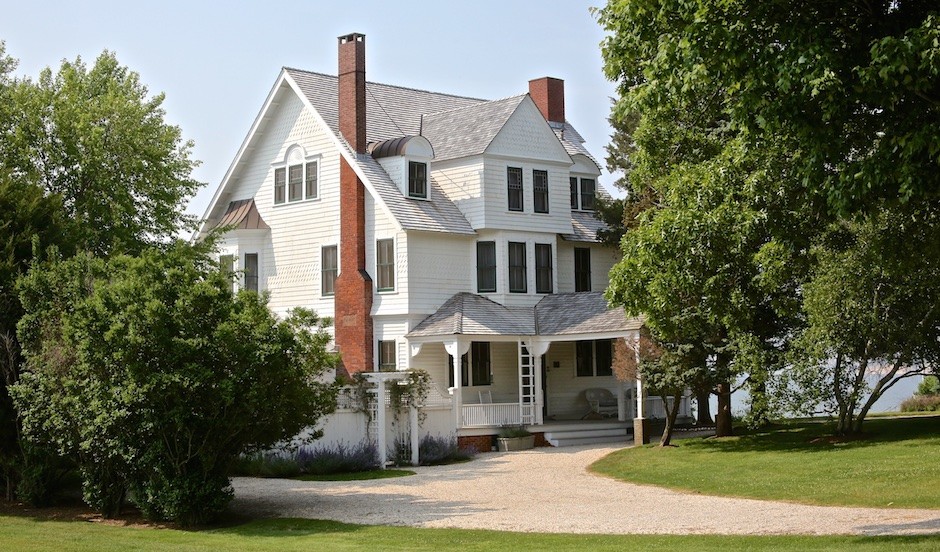
William Caldwell House, 1892, Noyac
William Cauldwell House is a State/National Register-Listed property and a Southampton Town Landmark. The Queen Anne-style house is a three-story three-bay house with dormers, a steeply pitched side-gable roof, and a wrap-around porch. It is clad in patterned wood shingles. The house was built in 1892 for William Cauldwell, the publisher of the New York Sunday Mercury. Cauldwell has been called the father of Sunday Journalism. He also served in the New York State Senate. — Town of Southampton.
Southampton Town Landmark
New York State & National Registers of Historic Places
______________________________________________
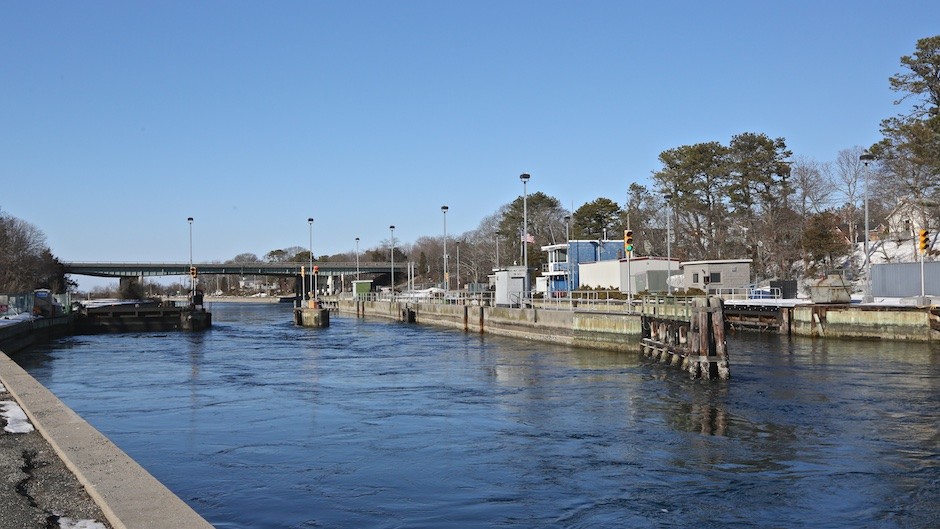
Shinnecock Canal, 1884 / 1892, Hampton Bays.
The Shinnecock Canal connects Great Peconic Bay with Shinnecock Bay and the Atlantic Ocean. A canal may have been in this location as early as the 17th century, constructed by the Shinnecock and Montaukett tribes; however, little evidence for this has reportedly been found other than the local place name Canoe Place. The modern canal was created circa 1892. A canal lock system was constructed in 1919 to address the difference in the water levels between the Peconic and Shinnecock Bays. The lock is now the only operating lock on Long Island. Due south of the canal, the Shinnecock Inlet was formed by the Hurricane of 1938; this feature together with the Canal creates a direct route to the Atlantic Ocean used heavily by marine traffic. — Town of Southampton.
______________________________________________
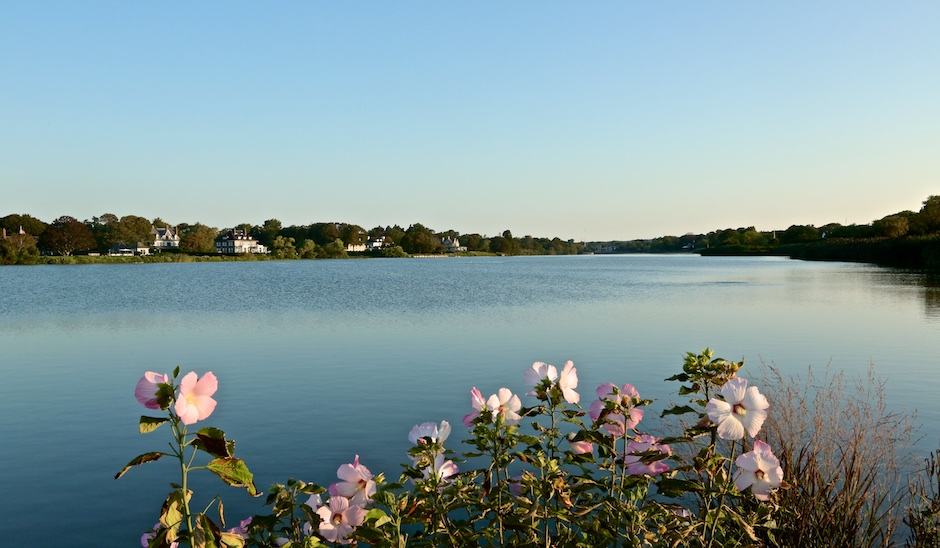
Town Pond renamed Lake Agawam, 1880s / 1894
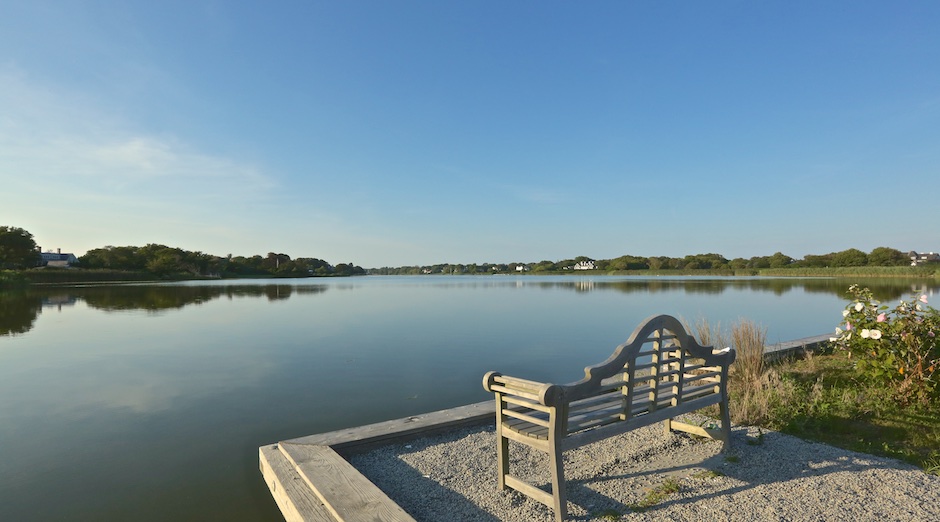
______________________________________________
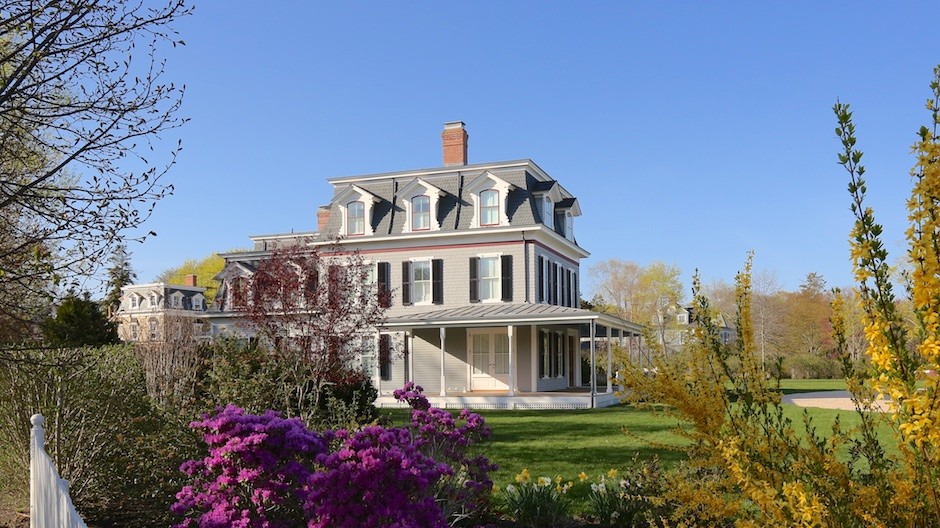
“The Zephyros” (John G. Wendel Residence), Quogue, 1894. George H. Skidmore, Architect.
The house was built in the Second Empire style c. 1894 by Henry W. Hallock and designed by architect George H. Skidmore. Later acquired by John G. Wendel, who converted the nearby Cooper House into a hotel in the 1890s, also ran “Zephyros” as a boardinghouse. It is similar in its Second Empire style to the “Shinnecock Arms” on Jessup Avenue and “Quantuck Manor” on Quantuck Lane. The house behind it on Old Depot Road was originally the laundry and servants’ quarters for this house. — Historic Division, Southampton Town Clerk
Historic Division, Southampton Town Clerk
______________________________________________
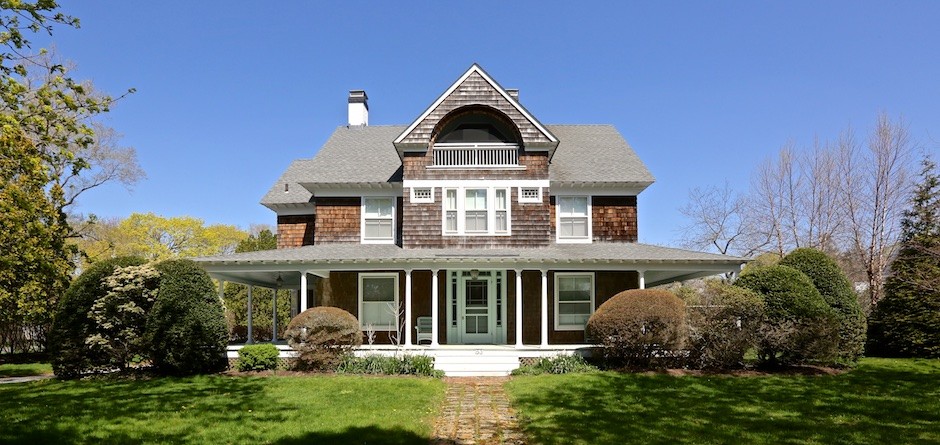
“Slumberside,” Admiral Alfred T. Mahan Residence, 1894, Quogue
This two-story, three-bay gable roofed house with wraparound porch and prominent
façade gable incorporates an unusual sleeping porch on the attic level. This architectural feature may have given inspiration for the name. The house was constructed c. 1894 for Admiral and Mrs. Alfred T. Mahan. Mahan (1840-1914) was a US Navy admiral and historian who has been called “the most important American military strategist of the nineteenth century” in part because of his emphasis on sea power. He is remembered for his influential writings, including The Influence of Sea Power Upon History, 1660-1783 published in 1890. Admiral Mahan is buried at the Quogue Cemetery. — Historic Division, Southampton Town Clerk.
Historic Division, Southampton Town Clerk
______________________________________________
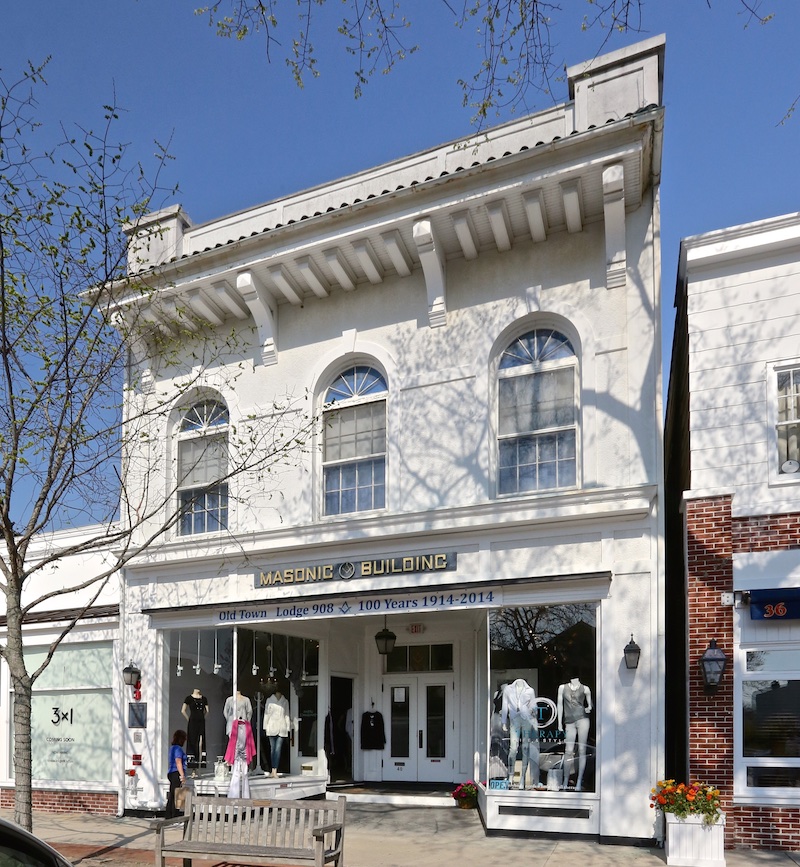
Masonic Building, 1895, Southampton
Unusual with its stucco wall material and second floor pent roof covered with clay pantiles
and supported on large brackets, the Masonic Building was constructed as an Odd Fellows lodge about 1895 and remodeled in the 1920s. True to tradition, the Masons’ large lodge room is located on the second story, away from prying eyes, while the main floor shops generate revenue to help underwrite the costs of running the fraternal organization. The Masonic Old Town Lodge 908 Free & Accepted Masons was established in 1913 as an offshoot of the Sag Harbor lodge, and they acquired the building from the Odd Fellows in 1936. — Southampton Historical Museum.
www.southamptonhistoricalmuseum.org
______________________________________________
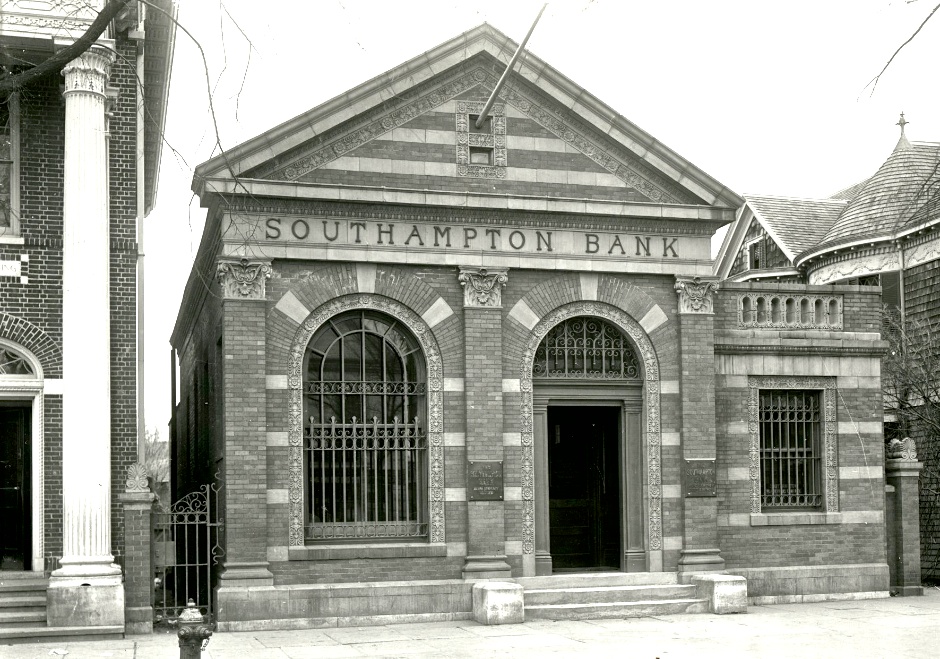
Southampton Bank, 1895, Southampton. Archival photograph courtesy of the Southampton Historical Museum.
The village’s first bank, the Southampton Bank was capitalized at $25,000 when it opened in rented quarters on Jobs Lane in 1888. By 1895 its success merited a move to Main Street and a new building designed by R.H. Robertson, who was also the architect of the original Rogers Memorial Library and of many prestigious buildings in New York City. A bank brochure from 1921 declares the bank building “a model of modest architecture, many features of which have not and could not be improved.” In fact, the building that survives is unrecognizable, having lost its pediment and acquired a dazzling coat of white paint, among other changes. It now houses Waldman, Inc., purveyor of jewelry and antiques. — Southampton Historical Museum.
www.southamptonhistoricalmuseum.org
______________________________________________

Shinnecock Yacht Club, 1895, Penniman Creek, Quogue
The Shinnecock Yacht Club is a one-story, gambrel roofed maritime type structure
that occupies a wharf projecting into Penniman Creek at the easterly end of Niamogue Lane. The building continues to house the Shinnecock Yacht Club, which was organized as the Shinnecock Bay Yacht Club on April 20, 1887 (incorporated 1890; name changed to Shinnecock Yacht Club in 1901). The building was constructed c. 1895 and retains original architectural detailing despite its vulnerable location at the water’s edge. — Historic Division, Southampton Town Clerk.
______________________________________________
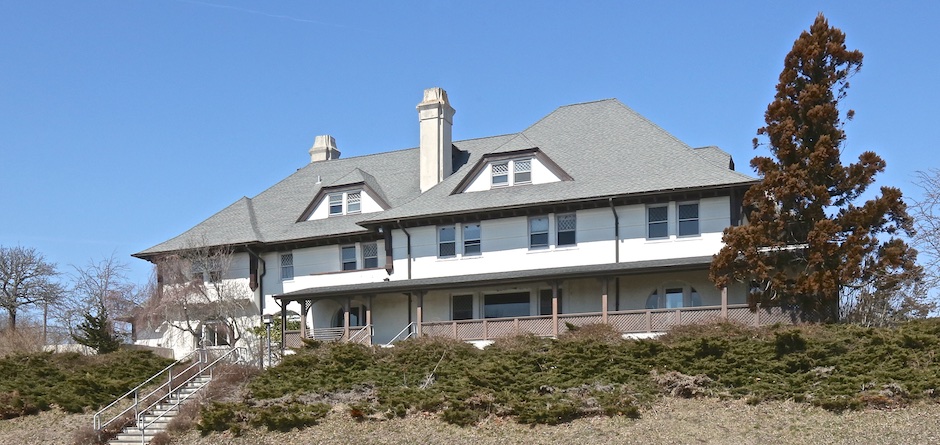
Arthur Clafin Residence, 1896, Shinnecock Hills. Grosvenor Atterbury, architect.
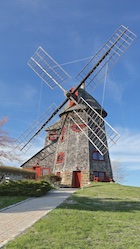
Designed by Grosvenor Atterbury, the main house is a large rambling Art & Crafts-style building with multiple hipped roofs with hip-roofed dormers and exposed rafter ends. Several massive chimneys rise from the roof slopes. A wrap-around porch with decorative latticework survives along the first story. Wood diamond-paned windows occupy the upper sash of the many of the windows on the building. The exterior is parged with stucco and the roof has been reclad in asphalt shingles. The estate, along with the windmill, was sold after World War II and became the Tucker Mill Inn. Playwright Tennessee Williams rented the windmill for the summer in the 1950s. It was purchased by the college in 1963 and restored to its present condition in 1991. The context of the windmill and mansion has been substantially altered since the time of their use as an estate due to the existence of the surrounding college campus buildings and the presence of a large transmission tower, however the buildings retain historic significance as well as their physical relationship to each other. — Town of Southampton.
______________________________________________

Remsenburg Presbyterian Church, 1896 (Now Remsenburg Church)
The Remsenburg Community Church is a restrained yet imposing brick building, exhibiting elements of the Romanesque and Arts & Crafts styles. The massive central tower is battered and surmounted by a hipped roof. A large segmental-arch window occupies the ground-story of the tower. A brownstone plate above it reads “Remsenburg Church.” Two narrow round-arch windows located above it are surmounted by a belfry that is integral to the tower. The tower is flanked by brick porte- cocheres. The side elevations of the church contain regularly spaced segmental-arch windows containing leaded glass. Simple brick buttresses are located between each of these windows. —– Town of Southampton.
______________________________________________
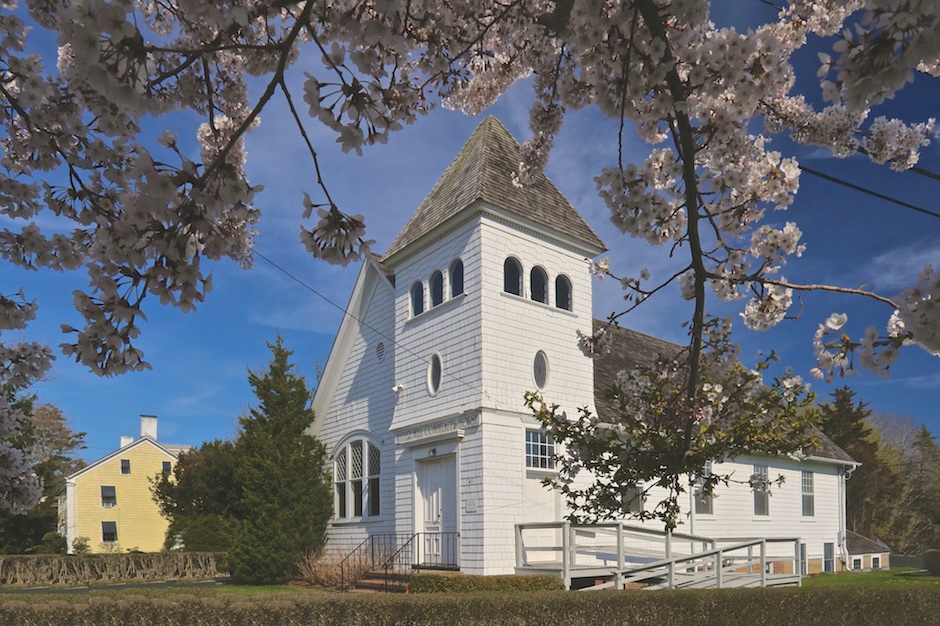
Union Chapel, 1897 (Water Mill Community House since the 1920s). Walter E. Brady, Architect.
The Water Mill Community House was built in 1897 as the Union Chapel. The Shingle-style structure served as a non-denominational church building through the 1920s. The building was funded by donations, and was designed by Southampton architect Walter E. Brady. From the 1920s to the present the structure has been used as a secular meeting hall. — Town of Southampton.
______________________________________________
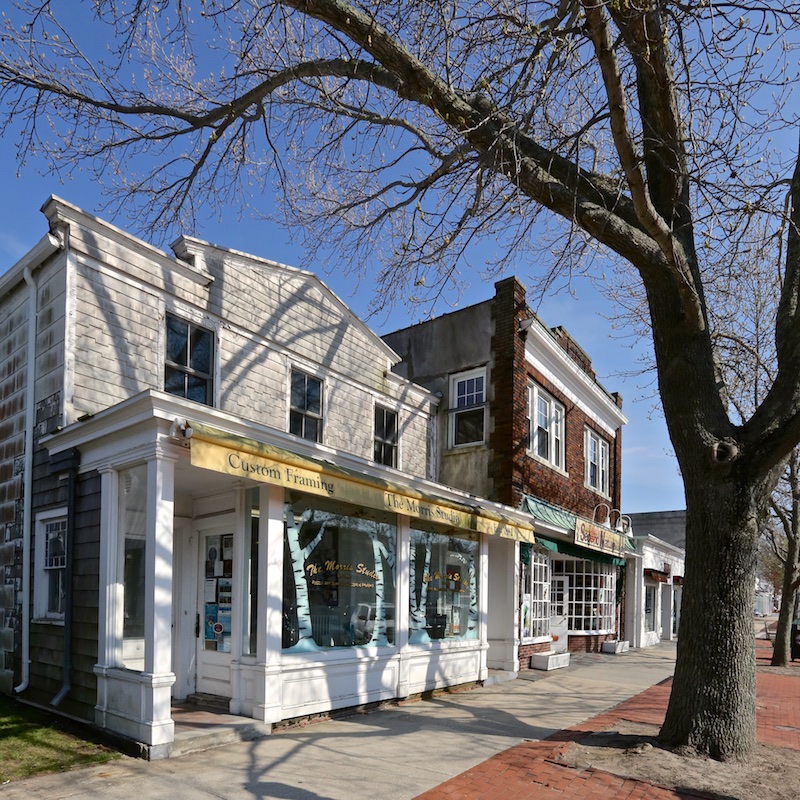
Morris Studio, 1897, Southampton
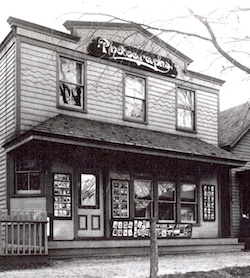 The Morris Studio opened on the east side of Main Street in 1897. George Morris had previously rented a studio on the west side of Main Street after arriving in Southampton in 1892. The new building was constructed according to his wishes. In the late 1920s it was moved a few feet to the north of its original site. The business, still in operation, was in the hands of the Morris family until the late 20th century. —– Southampton Historical Museum.
The Morris Studio opened on the east side of Main Street in 1897. George Morris had previously rented a studio on the west side of Main Street after arriving in Southampton in 1892. The new building was constructed according to his wishes. In the late 1920s it was moved a few feet to the north of its original site. The business, still in operation, was in the hands of the Morris family until the late 20th century. —– Southampton Historical Museum.
Archival photograph courtesy of Southampton Historical Museum.
______________________________________________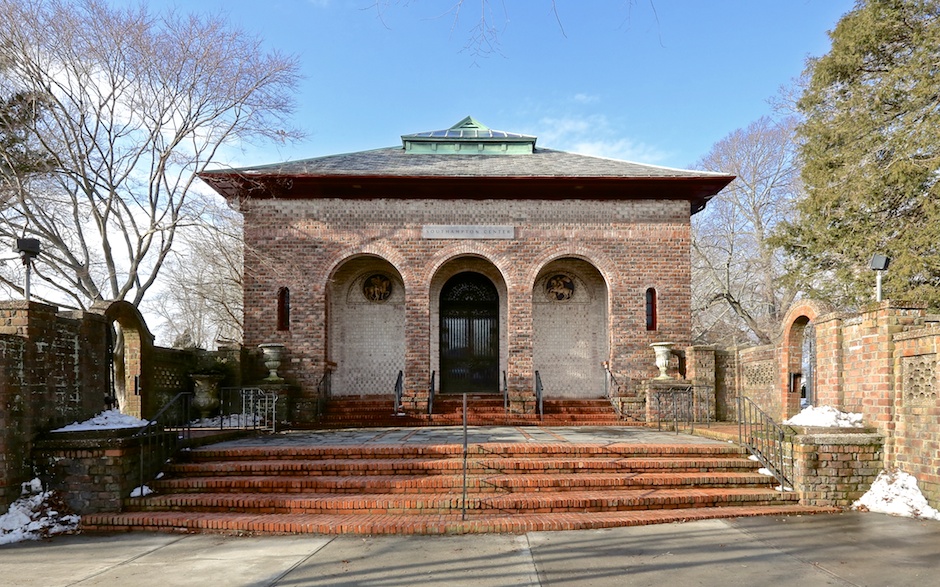
Samuel L. Parrish Art Museum, 1898, Southampton
The original idea for the museum came to Samuel Parrish, who had studied the Italian Renaissance at Harvard College, while he was on a trip through Italy in 1896 gathering pieces and reproductions of Greek and Roman sculpture. Parrish commissioned fellow Southampton summer resident Grosvenor Atterbury to design the museum. — Mary Cummings, Southampton / Images of America / Arcadia Publishing.

Samuel Longstreth Parrish standing inside his art museum. Archival photograph courtesy of the Southampton Historical Museum.

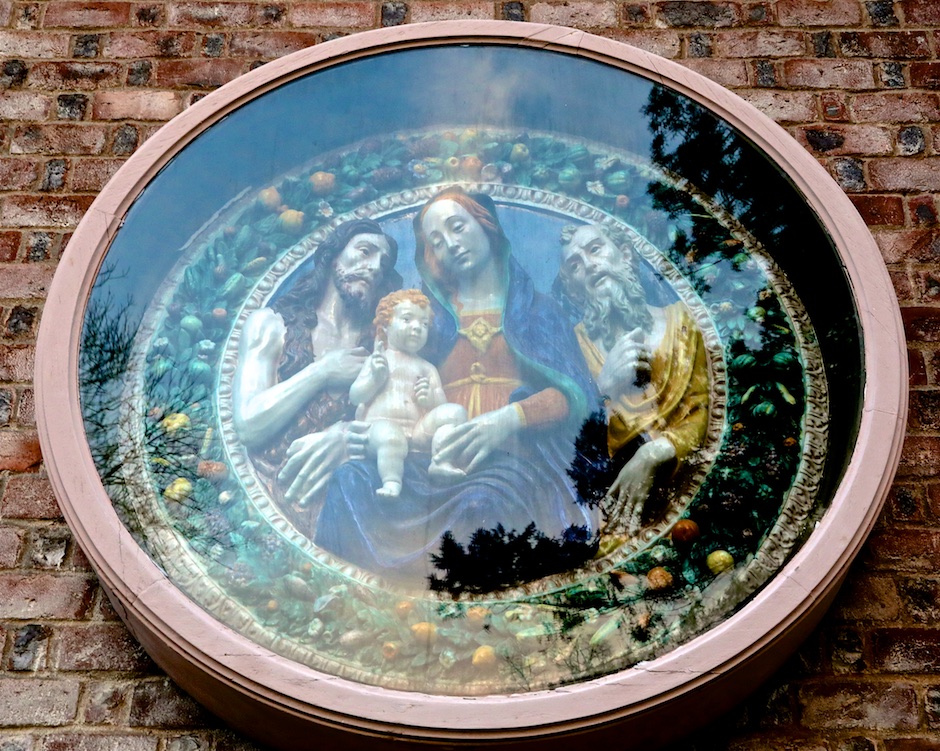


Samuel Longstreth Parrish. Hailed as the “First Citizen of Southampton” in his New York Times obituary in 1932, Samuel Parrish became a prominent landholder and patron of the arts in Southampton after he retired from his New York City law practice. He succeeded Albert J. Post as “president” of Southampton Village, where he founded the Parrish Art Museum and joined forces with his brother James in many other civic-minded projects. An active backer of the Rogers Memorial Library, he was also one of the organizers of the Shinnecock Hills Golf Club. A man in the patrician mold, he lived most of his life as a bachelor, marrying only late in life. He died in 1932 at the age of eighty-three. — Mary Cummings, Southampton, Images of America / Arcadia Publishing.
AAQ / Resource / Education, Books — Click Here.
______________________________________________
“The Orchard”/“Whitefield” (James L. Breese House), Southampton, 1898. McKim, Mead & White architects.
“The Orchard” was constructed c. 1898 for James L. Breese, a New York financier and friend of the architects. The design conjures up the Old South, with its Mount Vernon type portico conveying the message of a genteel and leisure lifestyle. The rear façade, by contract, is more “New England” in its Federal Revival style; in truth, it is said that an authentic 18th century farmhouse lies at the core of this summer house, and its 14” long exterior cypress shingles are a reference to a Long Island Colonial idiom. The estate has been converted to condominiums, with the main house serving in part as communal space. — Historic Division, Southampton Town Clerk.
Historic Division, Southampton Town Clerk
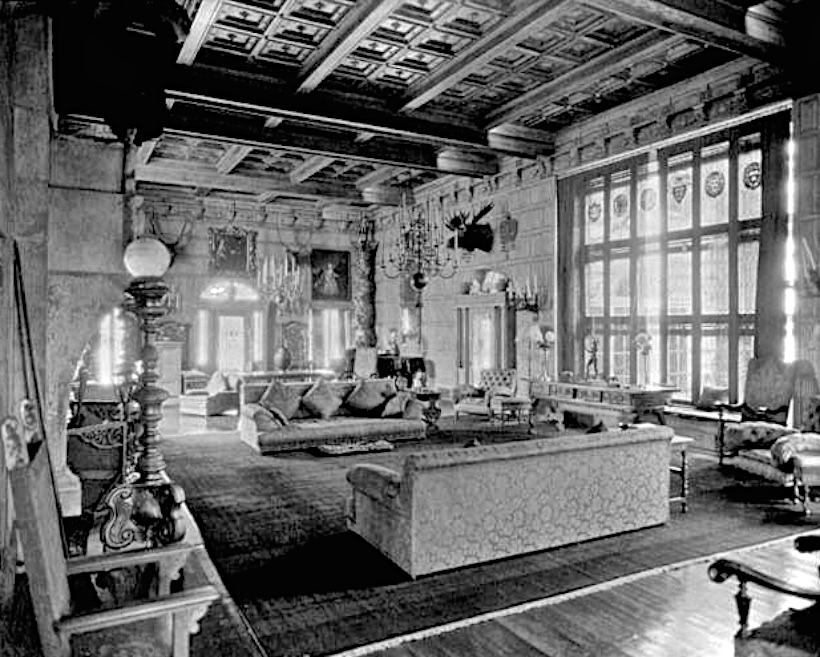
______________________________________________
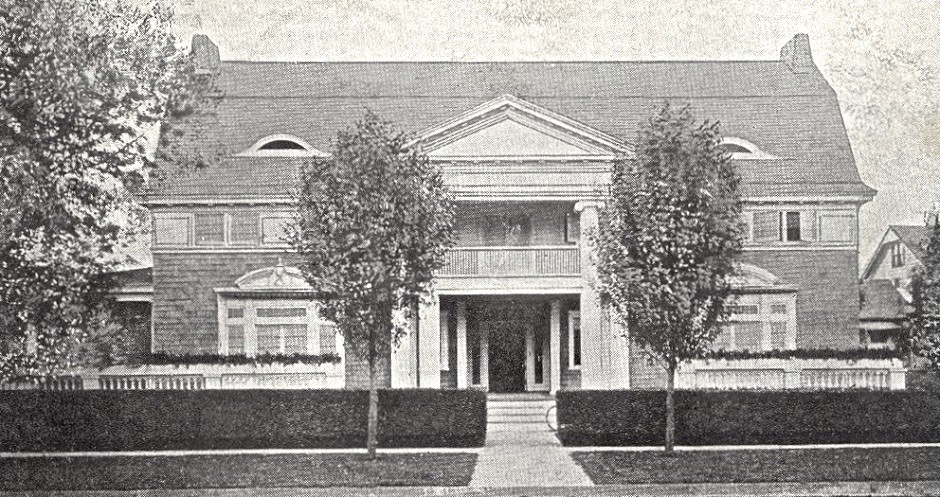
The Southampton Club, 1899. Grosvenor Atterbury, architect. Archival postcard courtesy of the Southampton Historical Museum.
This large, gambrel-roofed structure with its prominent central portico was designed by Grosvenor Atterbury in 1899. Atterbury studied at Yale and Harvard and later worked in the offices of McKim, Mead & White before starting his own practice around 1895. He is probably best known for his model housing community of Forest Hills Garden, which he began in 1909 for the Russell Sage Foundation. His Long Island country house commissions are numerous and his own house, known as “The Lodge,” was built nearby in Shinnecock Hills. — Historic Division, Southampton Town Clerk.
Historic Division, Southampton Town Clerk

______________________________________________

E.O.Wilcox House, 1899, Westhampton,1899
Known as the Hall-Wilcox House or the E.O. Wilcox House, 9 Brushy Neck Road is a large Victorian house with cross gables, a central hipped roof and a three-story tower with pyramidal roof. The house features projecting bays, an entry porch with a parapet, and shed-roofed dormers. The windows throughout the house, which likely originally contained two-over-two-light double-hung sash, currently contain one-over-one-light sash and the roof cladding has been replaced with asphalt shingles; however, the patterned shingle siding remains intact. According to Historical Profiles of Eastport, Remsenburg/Speonk, and Westhampton, this was part of a successful duck farm started by E.O. Wilcox in 1883. Initially called Sea Side Ranch, it later became Ensilage Duck Farms and then Oceanic Duck Farm. Wilcox initially lived in a small farmhouse on this site, which he subsequently moved to 157 Montauk Highway. In its place, he built this larger Victorian house, ca. 1899. — Town of Southampton.
______________________________________________

“Rose Manor,” Dr. Greeff Residence, 1900, Quogue
Known variously as “Rose Manor” and “Belle Meade,” the house was built c. 1900
for a Dr. Greeff, and was marked as the Greeff house on a 1916 map of Quogue. Shinnecock Road was opened in 1881, enabling access to the waterfront parcels that front on Penniman Creek. It was the first of a series of such roadways that exploited the undeveloped land stretching to the south of Quogue Street, which by the turn-of-the-century enabled the redevelopment of the area with large summer homes and easy access to the ocean beach. — Historic Division, Southampton Town Clerk.
Historic Division, Southampton Town Clerk
______________________________________________

Tiedemann House, ca. 1900, Hampton Bays
The Tiedemann House, on the property of the Hand-Aldrich American Legion Hall, is a ca. 1900 structure, two stories in height with a cross-gable roof. It is sided in wood shingles and retains vergeboard ornamentation along the gable eaves. — Town of Southampton.
______________________________________________
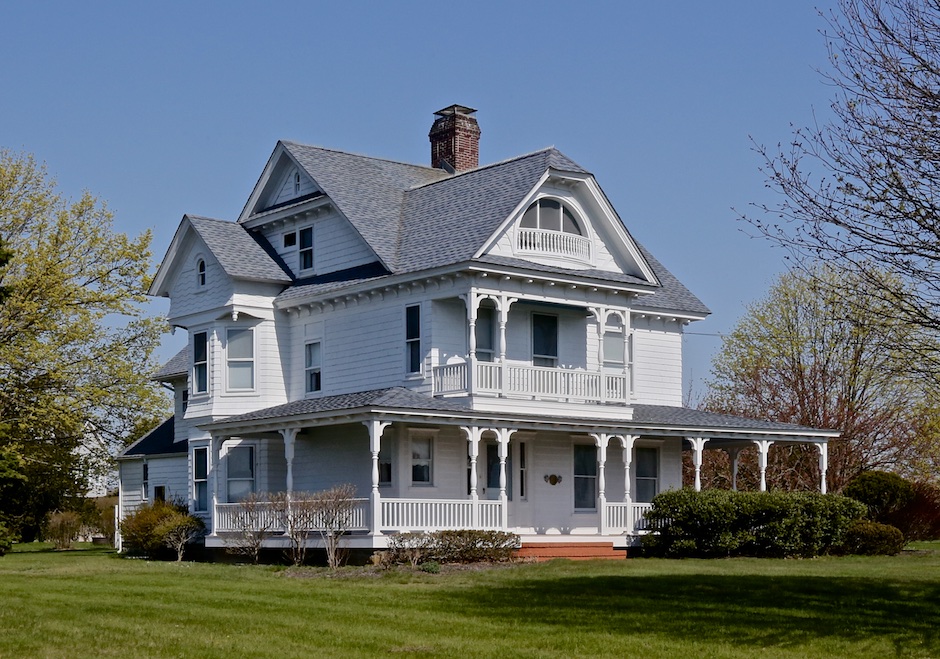
Pye House, ca. 1900, Eastport
An ornate two-and-a-half-story residence overlooking the water set on a large lawn. The wood-shingle clad building features a corbelled brick chimney, a jerkinhead gable, cut-away bays, half-timbering, modillion brackets, projecting bays, and a wrap-around-porch. The high-style house likely dates to ca. 1900. According to Historical Profiles, this is the W.H. Pye House: “This house was originally located on the east shore of the west creek. It was turned 180 degrees and moved closer to the Southampton Town Dock parking lot in the 1930s. At that time, Mr. Pye had the largest duck farm in Eastport.” — Town of Southampton.
______________________________________________
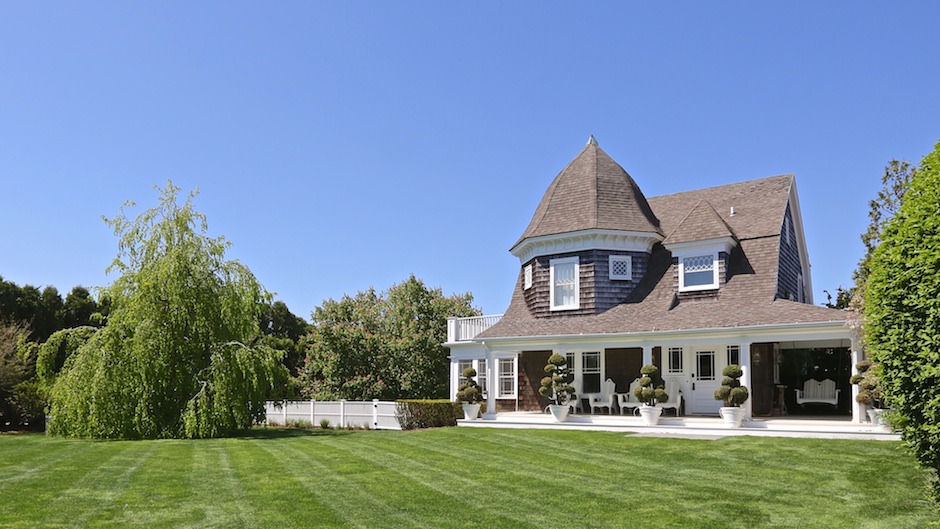
Corwith-Jennings House, ca. 1900, Water Mill. Walter Brady, architect.
The Corwith-Jennings House was designed by local architect Walter Brady. It originally stood in the approximate location of the Market Square businesses in Water Mill. It appears to combine elements of the Craftsman, Queen Anne, and Colonial Revival styles. The shingle-clad structure has a side-gable gambrel roof, that sweeps out on the front elevation to incorporate an integral porch. A bulky octagonal tower rises through the overhanging porch roof. A hip-roofed gable dormer is located beside the tower. Multi-light windows of various designs and eaves brackets evoke the Queen Anne style. — Town of Southampton.
______________________________________________
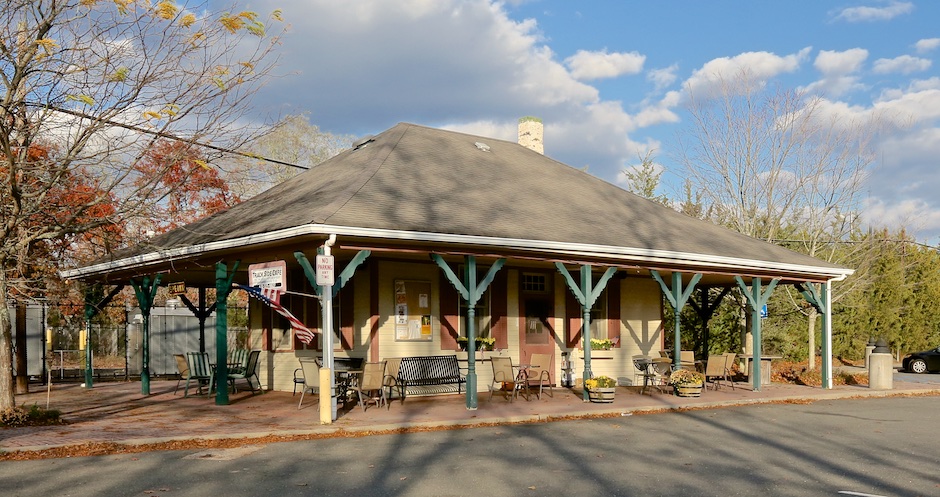
Speonk Railroad Station, 1901
The railroad has been an important part of Remsenburg-Speonk’s culture and economy since the railroad’s establishment in the area. Speonk Station was originally built in 1870 along what was then the Sag Harbor Branch. The station burned down due to a lightning strike in 1901, and a new depot was constructed in the same year. This depot was closed in 1958. — Town of Southampton.
______________________________________________
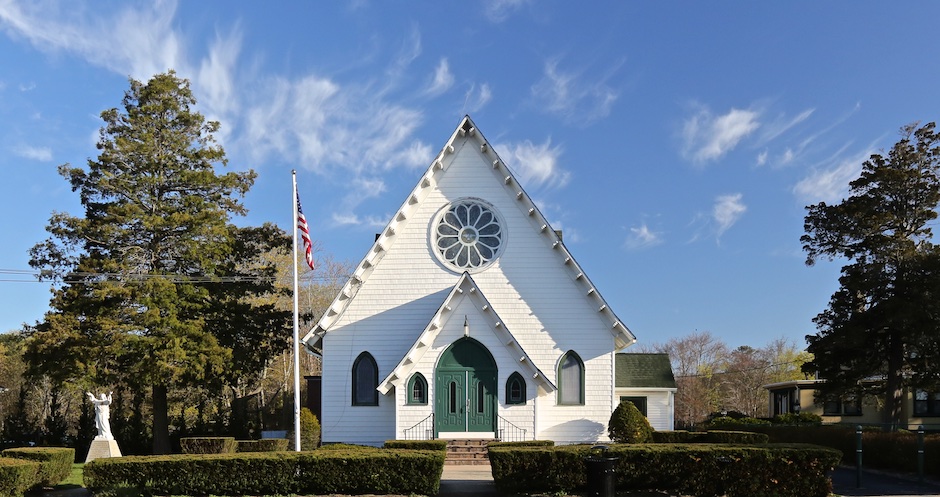
Saint Rosalie’s Church, 1901, Hampton Bays. Fred E. Penny, Builder.
The former church, now occupied by the Knights of Columbus, is a front-gable wood-frame structure with overhanging eaves and exposed rafter ends, a large rose window over an entry porch, and pointed-arch windows and doorways. The building appears to have a brick foundation and is clad in wood clapboards; the roof is clad in asphalt shingles. This building was constructed as Saint Rosalie’s Church in 1901 by Fred E. Penny. It originally had a steeple, which was lost in the Hurricane of 1938 and was never replaced. –— Town of Southampton.
______________________________________________

Corwith’s Pharmacy, c. 1901, Southampton. Archival photograph courtesy of Southampton Historical Museum.
Built circa 1901, the building near the corner of Jobs Lane and Main Street housed Corwith’s Pharmacy for more than a century. The business was launched even earlier in 1844 by Caleb Corwith. The 1901 structure boasted an impressive interior with hand-carved woodwork and elegant fixtures. Later a soda fountain was a popular attraction. — Historic Division, Southampton Town Clerk.
Historic Division, Southampton Town Clerk
______________________________________________
 Marconi Cottage, 1902, Sagaponack
Marconi Cottage, 1902, Sagaponack
Guglielmo Marconi, an Italian inventor who developed radiotelegraphy, set up a system of land stations on the East Coast to facilitate communication with wireless operators aboard ships. The Marconi wireless tower in Sagaponack, Long Island’s first, was erected next to a summer cottage in 1902. The Marconi Cottage, as it was known, was on the east side of Sagg Main Street, down by the ocean. It housed the head telegrapher and his family, and it served as a school for Marconi operators. On April 15, 1912, while the Titanic was sinking, on the shores of Sagaponack, the Marconi wireless telegrapher, William Ward, was perhaps sleeping peacefully, about to be roused by the clacking of the telegraph signaling “CQD,” the precursor to “SOS,” coming from the Carpathian, the first ship on the scene of the disaster. Among the rescued was Harold Bride, the Titanic’s sole surviving wireless operator, who, along with the Carpathian’s operator Harold Cottam, was in constant contact with Sagaponack, sending and receiving ship-to-shore emergency information, as well as a heavy flow of messages from other Titanic survivors, as the ship made its way to New York. The station was used until 1914. — Julie Greene, Bridgehampton’s Summer Colony, Images of America / Arcadia Publishing.
Archival photograph courtesy of the Bridgehampton Museum.
AAQ / Resource / Education, Books — Click Here.
______________________________________________

Long Island Railroad Station, Railroad Plaza, 1902, Southampton
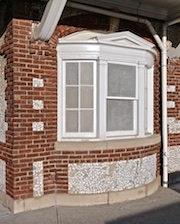 One story high under a hipped roof with long covered platform sheds supported on console brackets stretching from either side, Southampton’s Long Island Railroad Station was built in 1902 on land that was purchased from John Fournier in 1897. The masonry station combines brick corners with stucco walls into which clam shells have been pressed for decorative effect. Three Palladian style window heads and doors with voussoirs remain as built; an original fireplace survives as well, together with early railroad memorabilia on display. — Historic Division, Southampton Town Clerk.
One story high under a hipped roof with long covered platform sheds supported on console brackets stretching from either side, Southampton’s Long Island Railroad Station was built in 1902 on land that was purchased from John Fournier in 1897. The masonry station combines brick corners with stucco walls into which clam shells have been pressed for decorative effect. Three Palladian style window heads and doors with voussoirs remain as built; an original fireplace survives as well, together with early railroad memorabilia on display. — Historic Division, Southampton Town Clerk.
Historic Division, Southampton Town Clerk
______________________________________________
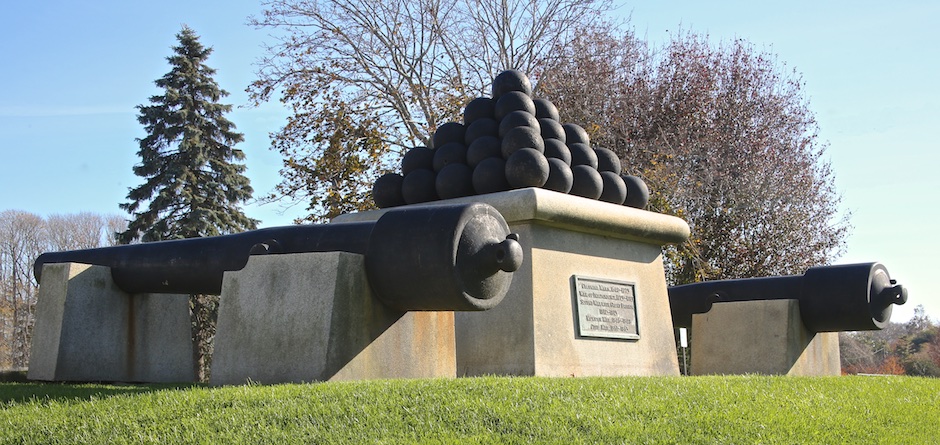
The Soldiers’ and Sailors’ Monument , 1902, Southampton
Begun in 1896, the Soldiers’ and Sailors’ Monument was funded with $ 2,000 contributed by popular subscription and was designed and built under the supervision of Thomas H. Barber. It was dedicated to the village in 1900, but actually completed in 1902. The guns, projectiles, and chains–the latter from an old sloop of war–were donated by the War and Navy Departments. — Mary Cummings, Southampton, Images of America / Arcadia Publishing.
AAQ / Resource / Education, Books — Click Here.
______________________________________________
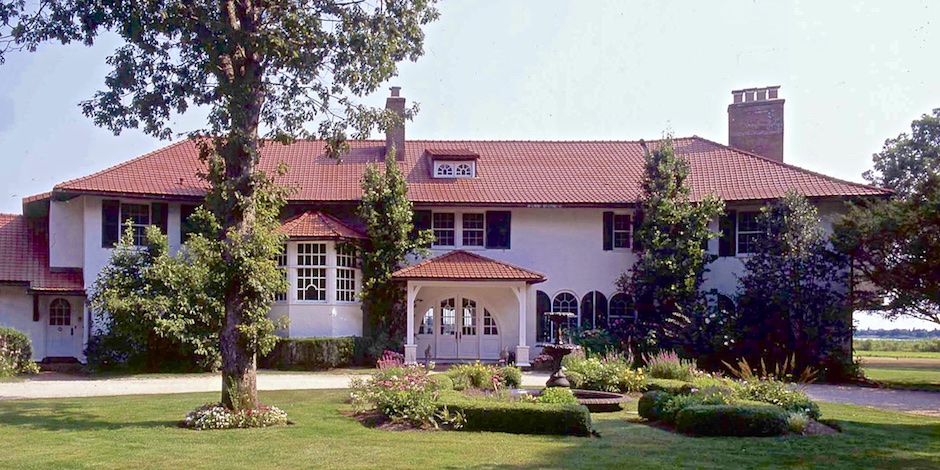
Meadowcroft, 1904, Quiogue. Residence of Theodore Eaton Conklin and Emma Adelaide Brigham Conklin. Wilson Eyre, Architect.
Eyre’s layout for Meadowcroft responded to the kind of practical considerations he applied to each of his designs. Regarding the location of the dining room, for example, he wrote that “the dining room should be located to the east, which places the dining area on the shady side of the house in the late afternoon and avoids sun at dinner hour, when it is hotter and slants into the room and becomes an annoyance.”…In creating its look of uncalculated simplicity, Wilson Eyre endowed Meadowcroft with all of the essential elements that define a true summer cottage in the Hamptons.” — Anne Surchin, Houses of the Hamptons / Acanthus Press, co-authored by Gary Lawrance.
AAQ / Resource / Education / Books — Click Here.
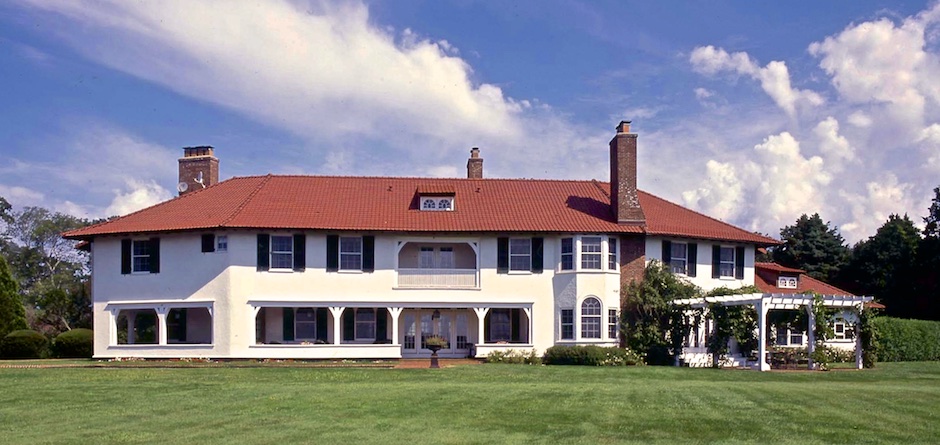
______________________________________________
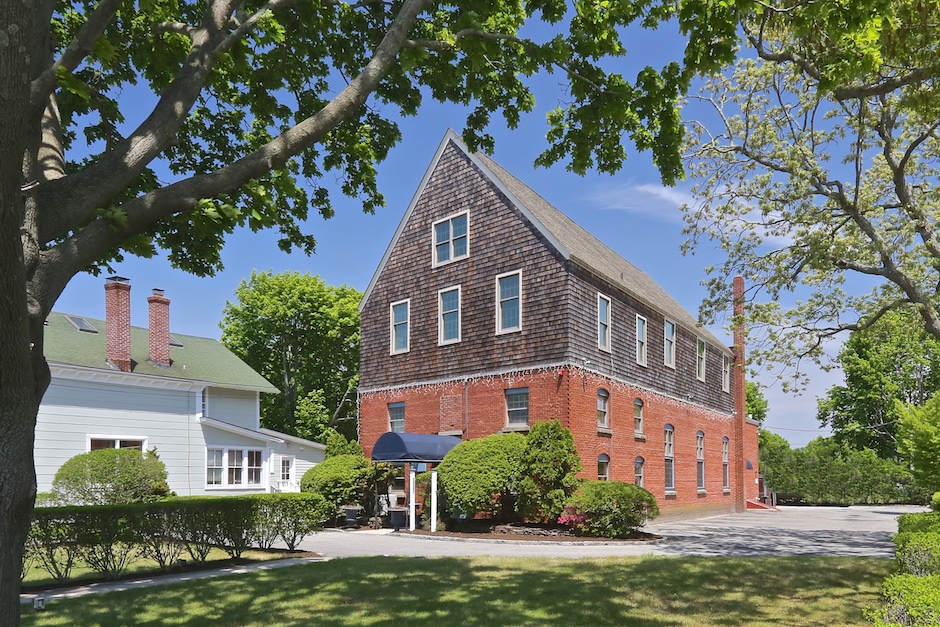
Mechanics Hall, 1906, Westhampton Beach
This building was constructed in 1906 by the Junior Order of American Mechanics for $ 7,000 and was used for many years as an assembly hall, hosting dances, meetings, movies, and theater productions. It was temporarily used as a school following the 1938 Hurricane, and during WWII it was the scene of many a meeting between servicemen and eligible young ladies. In recent years Mechanics Hall has been used as a nightclub and restaurant. — Westhampton Beach Historical Society.
_______________________________________________
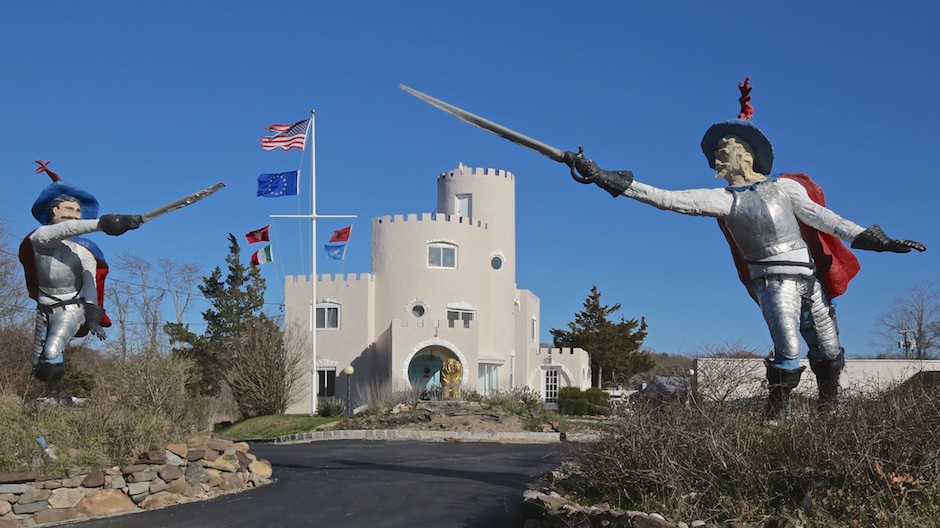
Theophilus Brouwer Castle, 1906, Westhampton
The Theophilus Brouwer Castle, associated now with Caso Basso Restaurant, was built in 1906. It served as the pottery studio for Brouwer who died in 1932, leaving pottery in the Smithsonian Institute in Washington. Concrete sculptures, two swordsmen and several animals, of Brouwers are still located outdoors on site. In the early 20th century, Brouwer was considered a top American potter. The castle, a stucco-parged miniature castle, is composed of a series of round and square crenellated towers, and horseshoe-arch entries. Oculi windows as well as segmental arch and rectangular windows pierce each tower, all containing single-light sash. The concrete sculptures, reportedly created and installed by Brouwer, contribute to the complex. — Town of Southampton.
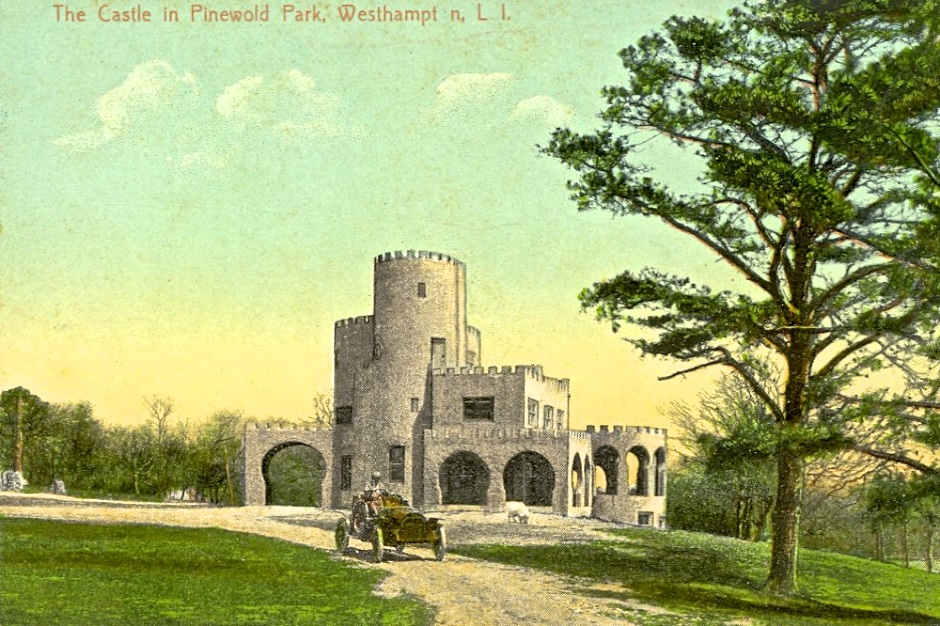
Archival postcard courtesy of the Southampton Historical Museum.
______________________________________________
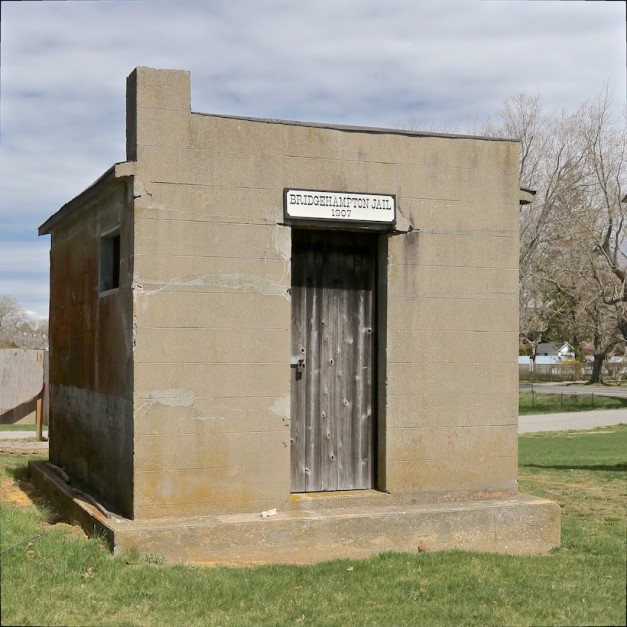
Bridgehampton Jail, 1907, Bridgehampton Museum
______________________________________________

Saint Ann’s Episcopal Church, 1907, Bridgehampton
Saint Ann’s Episcopal Church was constructed in 1907. The stucco-clad structure exhibits elements of the Mission and Spanish Colonial Revival styles. It has a hipped roof, a front-gable entry hyphen with a Moorish pointed arch, and an off-center steeple. — Town of Southampton.
——————–
St. Ann’s Episcopal Church, once the Sagaponack Golf Clubhouse, was moved to Main Street. In 1915, the chapel was redesigned by the architect James Ware of New York City. Ware had earned early praise and recognition for pioneering modern fireproofing, improving city dwellings for the poor, and designing the Mohonk Mountain House in New Paltz, New York. — Julie Greene, Bridgehampton’s Summer Colony, Images of America / Arcadia Publishing.
AAQ / Resource / Education, Book — Click Here.
______________________________________________
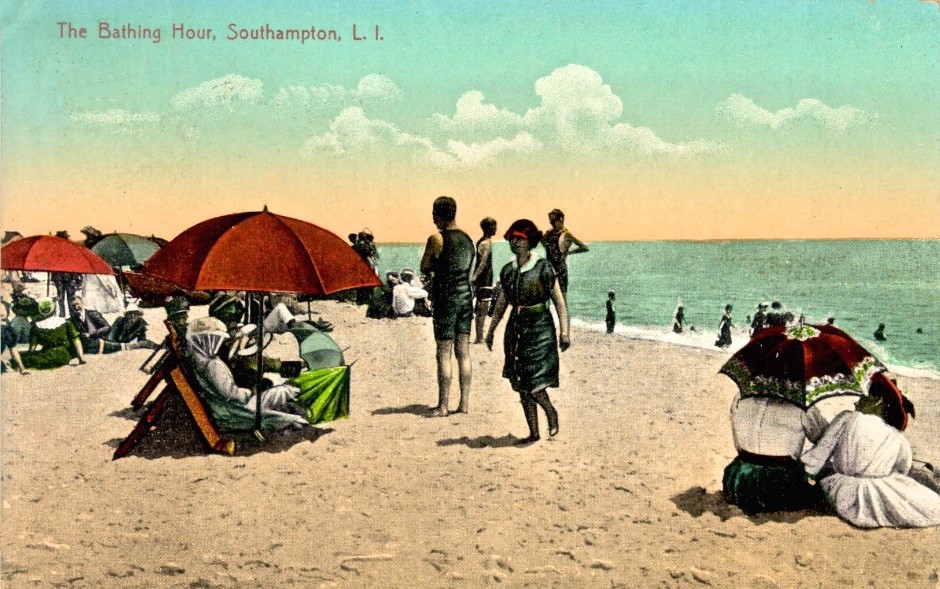
Archival postcard courtesy of the Southampton Historical Museum.
______________________________________________
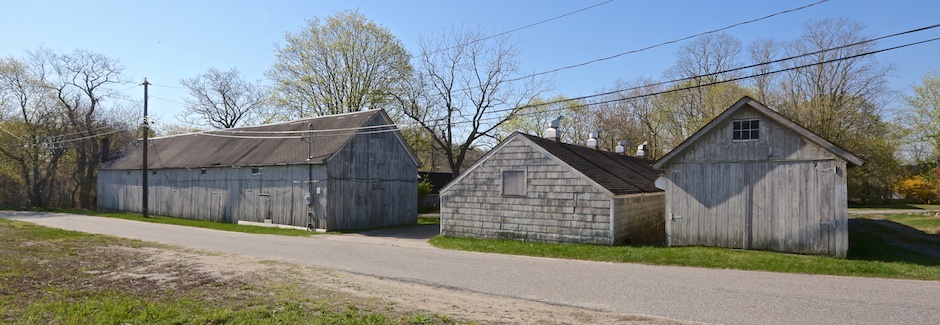
Three Barns, early 20th century, Eastport
At least three barns that appear to date to the early 20th century are located on this property. The barns each have long narrow rectangular plans. They have few windows and are clad in vertical boards. One of the barns has a brick end chimney and a large metal hopper mounted on the exterior. The historic function of these barns is not clear but they appear to have functioned together as a relatively large-scale industrial/agricultural operation. — Town of Southampton.
______________________________________________

4 Pierson Court, early 20th century, Water Mill, with Peconic Land Trust Easement, 2011.
This unusual complex appears to date from the early 20th century and includes a series of barns that were originally associated with the Pierson Dairy Farm and a small frame building that may be a residence. The possible residence is clad in wood shingles and is dominated by a three-story hip-roofed tower. The barns are single-story structures with jerkinhead roofs, with high buttressed concrete foundations and wood-shingle clad frame exteriors. The small residence with a tower (left) is believed to have originally been a water tower. A plaque mounted on a stone on the property reads: “This conservation easement established by Charleton and Nancy Halsey with the Help of the Peconic Land Trust in Memory of William H. Pierson, 2011.” — Town of Southampton.
______________________________________________

Sacred Hearts of Jesus and Mary Roman Catholic Church, 1907, Southampton
Designed in 1907 by T. H. Poole and Co. of New York City, Sacred Hearts is a striking edifice
constructed of white Dorset, Vermont marble. The corner stone was laid on July 29, 1907 and construction was completed by Norcross Brothers Company of New York the following year. The Gothic Revival building features a four-story bell tower and a three-story window that soars high above the front entryway. This was the third Catholic church serving the parish, the first having been built in 1880 and the second in 1892. — Historic Division, Southampton Town Clerk.
Historic Division, Southampton Town Clerk
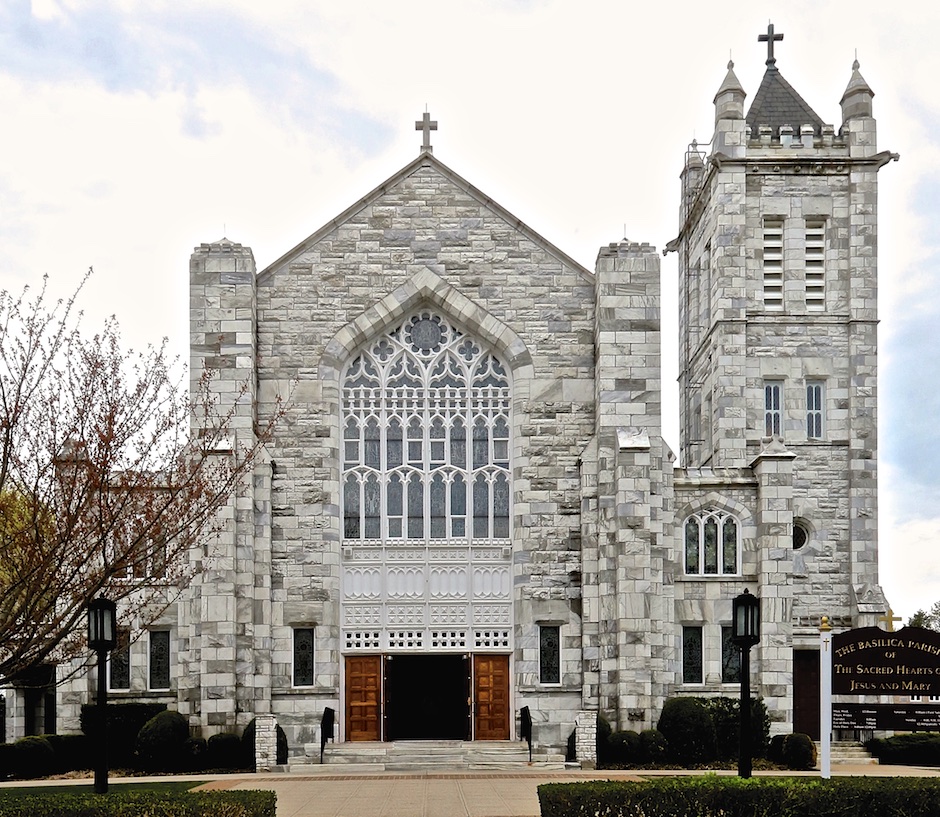
______________________________________________
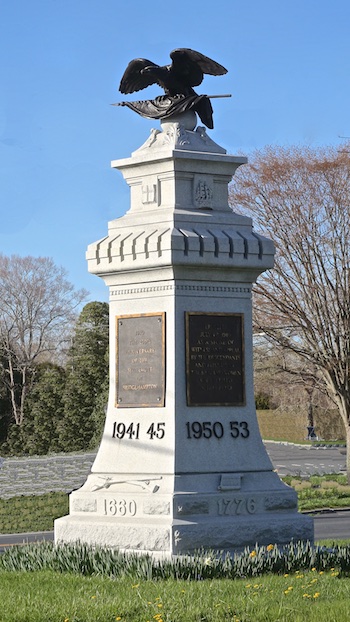
Bridgehampton Monument, 1910
The Bridgehampton Monument, located at the intersection of Montauk Highway and Ocean Road, was erected in 1910 in commemoration of the founding of Bridgehampton, the American Revolution, the War of 1812, and the Civil War. The monument consists of a bronze eagle on a granite base which bears four inscribed bronze plaques. — Historic Division, Southampton Town Clerk.
______________________________________________
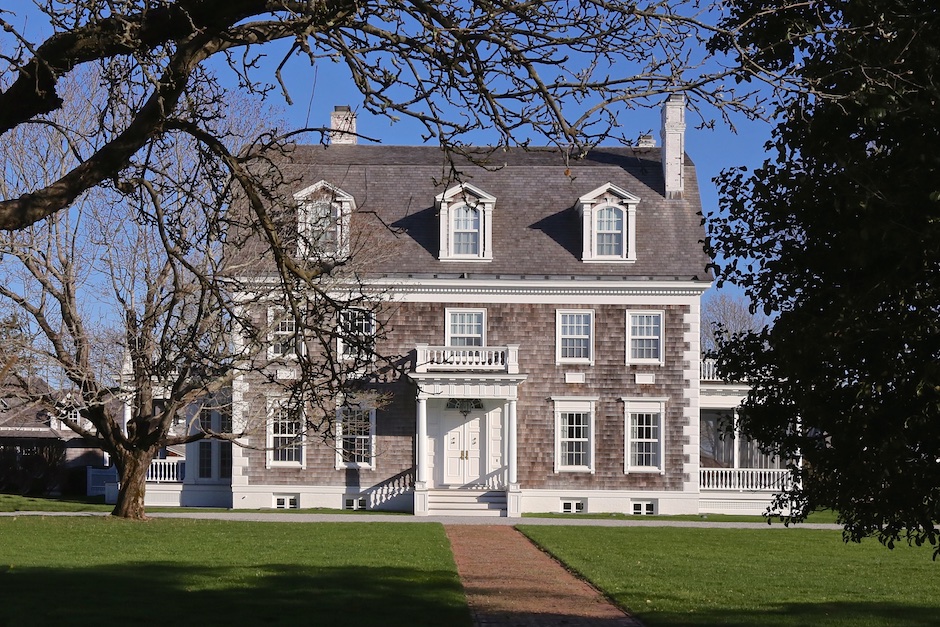
“Fair Acres,” Theodore Wentz Residence, 1910, Quogue
Built for Theodore Wentz, c. 1910, in the Colonial Revival style, it’s thought that the architect of “Fair Acres” was sent to the James River, Virginia area to copy his design from the early houses found there. The house boasts pronounced “quoins” at the corners and other detailing characteristic of the Colonial Revival style. Quaquanantuck Lane was opened for residential development in 1888, along with Ocean Avenue, Post Lane and Niamaug Lane. Within a few short years, summer homes began to populate these new neighborhoods. — Historic Division, Southampton Town Clerk.
Historic Division, Southampton Town Clerk
______________________________________________
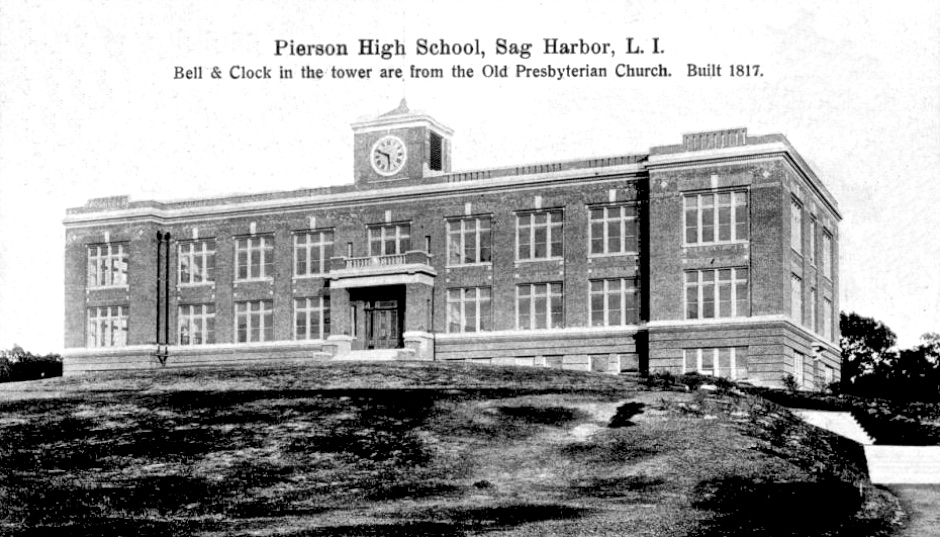
Pierson Middle-High School, 1908. Archival postcard courtesy of the Southold Free Library Whitaker Historical Collection.
One of many philanthropic ventures in Sag Harbor, Person Middle-High School was the gift of Mrs. Russell Sage, completed in 1908 at a cost of $102,000. Formerly, students had attended class in the upper stories of Village Hall on Main Street. The school was named for Mrs. Sage’s ancestor, Abraham Pierson, and reflected her interest in using public schools as a way of improving the recreational life and living conditions among local residents. — Historic Division, Southampton Town Clerk.
Historic Division, Southampton Town Clerk
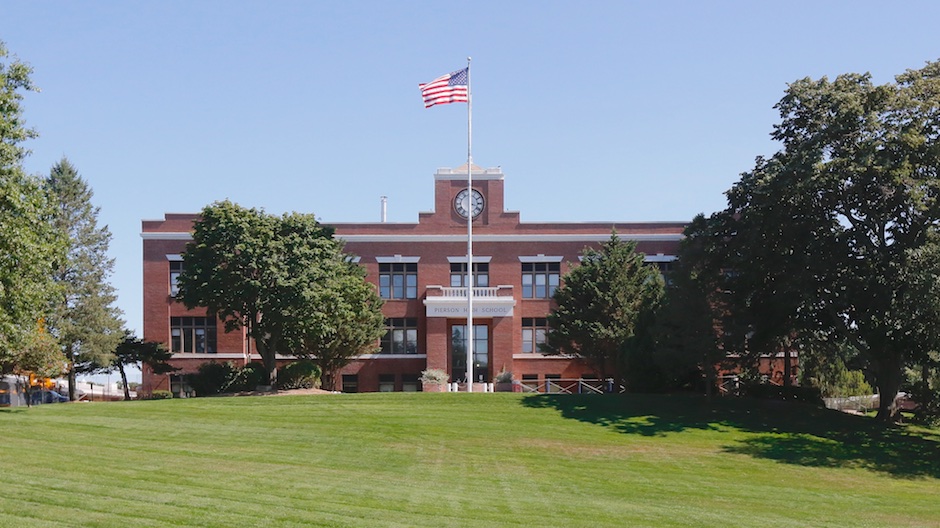
Pierson Middle-High School, August 5, 2016
______________________________________________
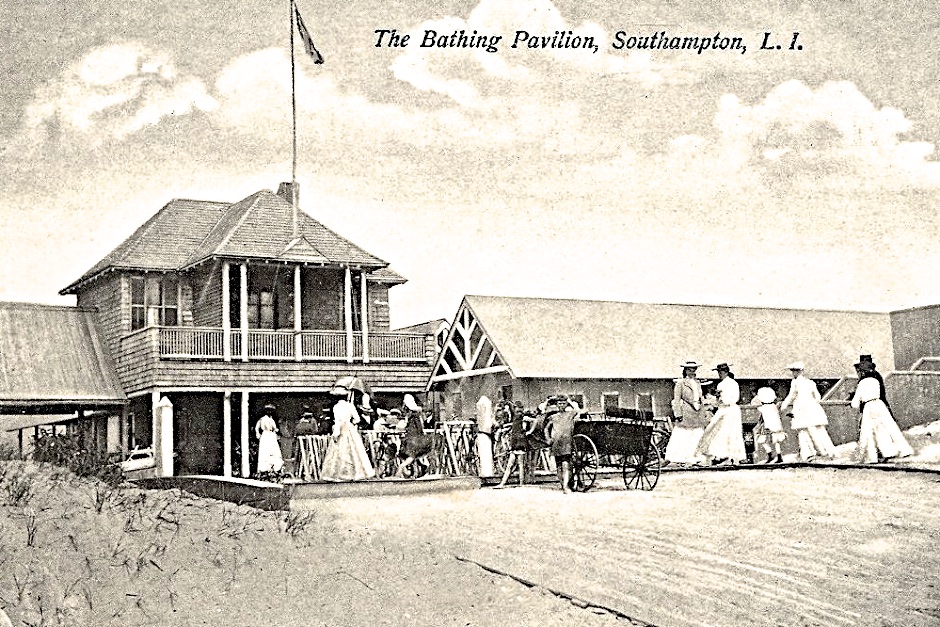
Bathing Pavilion, c. 1908, Southampton Village. Archival postcard courtesy of the Southampton Historical Museum.
In the early days of the resort an organization known as the Southampton Bathing Association operated a bathing pavilion on the ocean beach just south of Lake Agawam. Equally popular with local and summer residents, it offered bathers “two able turfmen” on lifeguard duty and “230 separate bathing houses.” In 1923 the era of democratic bathing ended when the Bathing Corporation of Southampton organized to acquire the property and operations of the association. The Bathing Corporation operated as a private club and public facilities for ocean bathing were eventually provided further west at Cooper’s Beach. — Mary Cummings, Southampton, Images of America / Arcadia Publishing.
AAQ / Resource / Education, Books — Click Here.
______________________________________________
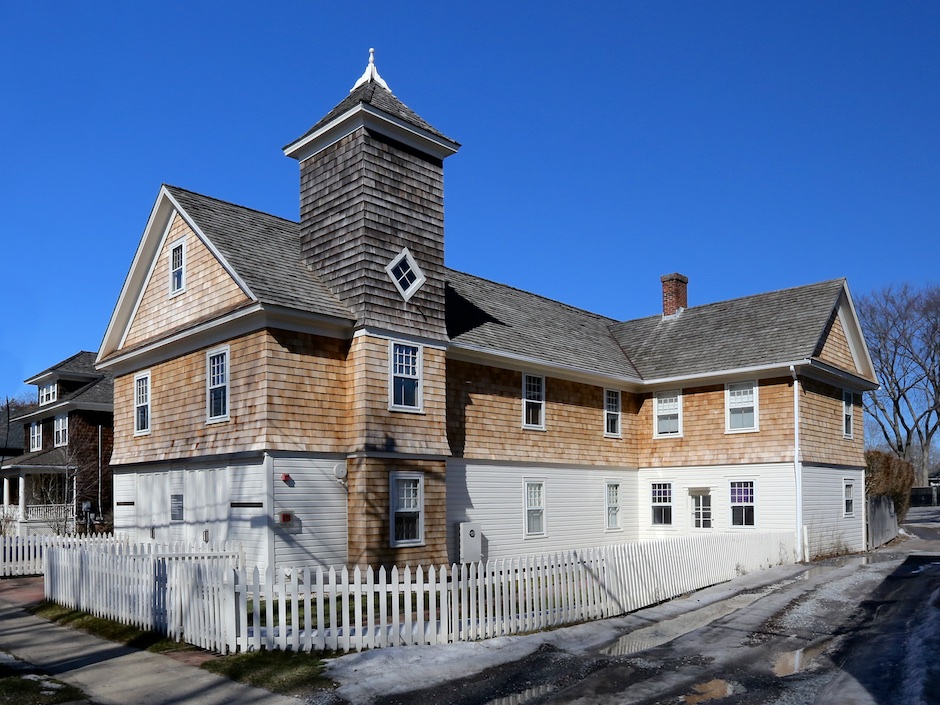
Bridgehampton Hook & Ladder Company, ca. 1908. Currently, Dan Flavin Art Gallery.
This three-story shingle-clad turreted building served as the Bridgehampton Hook & Ladder Co. fire department from 1908-1923. In 1924, under the leadership of H.D. Strotter, it was purchased by the newly organized First Baptist Church of Bridgehampton, and used as a chapel. It is currently occupied by the Dan Flavin Art Gallery. — Town of Southampton.
______________________________________________

Marshmere, 1909, Quantuck Bay, Quogue. Satterlee & Boyd Architects.
The house was constructed for Admiral and Mrs. Alfred T. Mahan. Mahan (1840-1914) was a US Navy admiral and historian who has been called “the most important American military strategist of the nineteenth century” in part because of his emphasis on sea power. He is remembered for his influential writings, including The Influence of Sea Power Upon History, 1660-1783 published in 1890. Admiral Mahan is buried at the Quogue Cemetery. — Historic Division, Southampton Town Clerk.
______________________________________________
+++++++++++++++++++++++++++++++++++
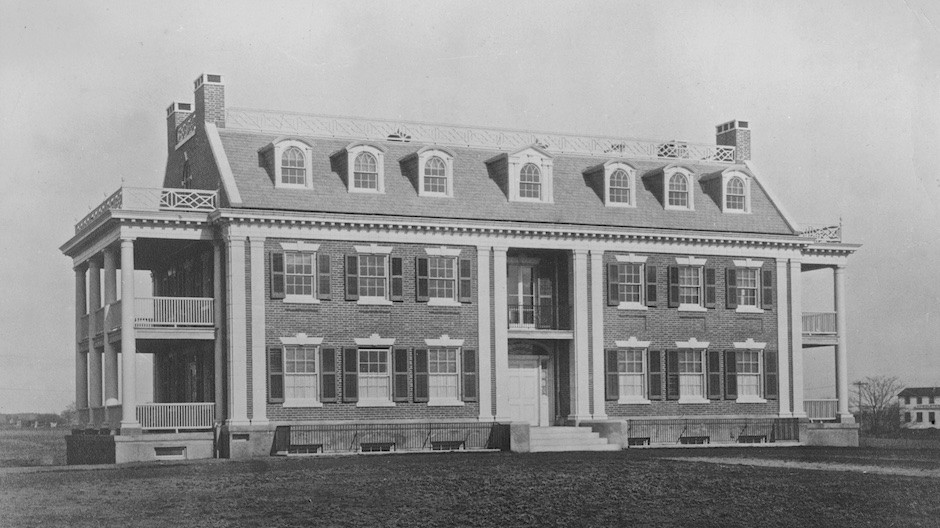
Southampton Hospital, 1909 / 1911. T. Markoe Robertson, architect.
The idea of creating a village hospital actually began in the early 1900s, occupying two rented rooms at the Goodale Boarding House on Hampton Road. After incorporation in 1909, the hospital moved to what survives today as a nearby residence, and in 1911 it moved again into a new hospital designed by T. Markoe Robertson. The large, brick Colonial Revival style structure with open two-story porches at each end was later absorbed into the present structure. Next door is the one-story Parrish Memorial Hall, the gift of Samuel L. Parrish, and built in 1922 in memory of the soldiers and sailors who perished during World War I. In the 1930s it functioned as a summer theatre. — Historic Division, Southampton Town Clerk.
Historic Division, Southampton Town Clerk
______________________________________________
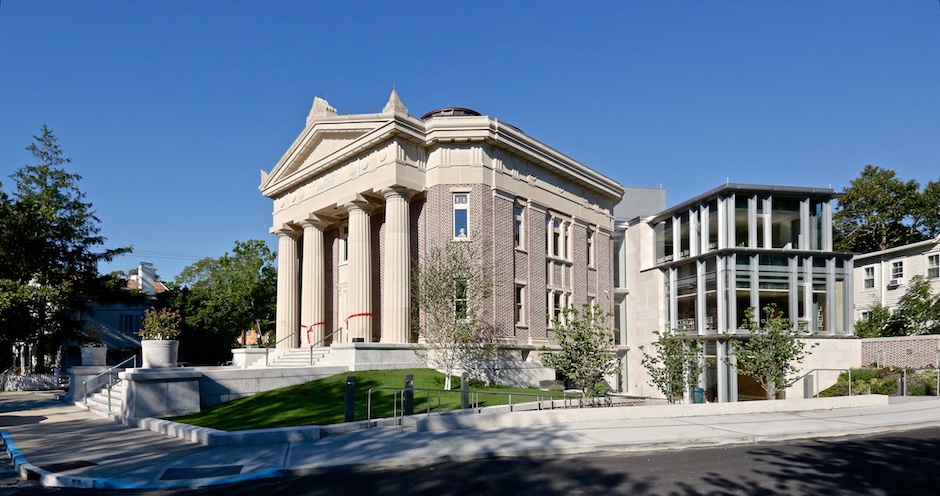
John Jermain Memorial Library, c. 1910, photo taken 2016.
Fashioned in the Beaux Arts Classical Revival style so often chosen for public buildings at the turn of the century, the John Jermain Memorial Library was donated by Mrs. Russell Sage to the Village in honor of her grandfather. With its round granite columns and unique dome, it is an impressive edifice. 100 years later, funds were raised to rehabilitate, enlarge and modernize the building so that John Jermain may continue serving the Village.
————————
Margaret Olivia Slocum Sage
Margaret Olivia Slocum was born in Syracuse, New York, on September 8, 1828, the daughter of Joseph Slocum of Syracuse and Margaret Pierson of Sag Harbor, and the granddaughter of the celebrated Major John Jermain. She became the second wife of industrial tycoon Russell Sage in 1869.
Sag Harbor was Mrs. Sage’s summer home and she dearly loved the village and its people. After her marriage, she purchased and restored the Jermain family home, and later when the elegant Benjamin Huntting estate became available, she acquired it for her permanent Sag Harbor home. It is now the Sag Harbor Whaling and Historical Museum.
She financed the building of Pierson High School, the John Jermain Memorial Library, and Mashashimuet Park.
Mrs. Sage is regarded by many as doing more for the village than any one individual. — John Jermain Library.
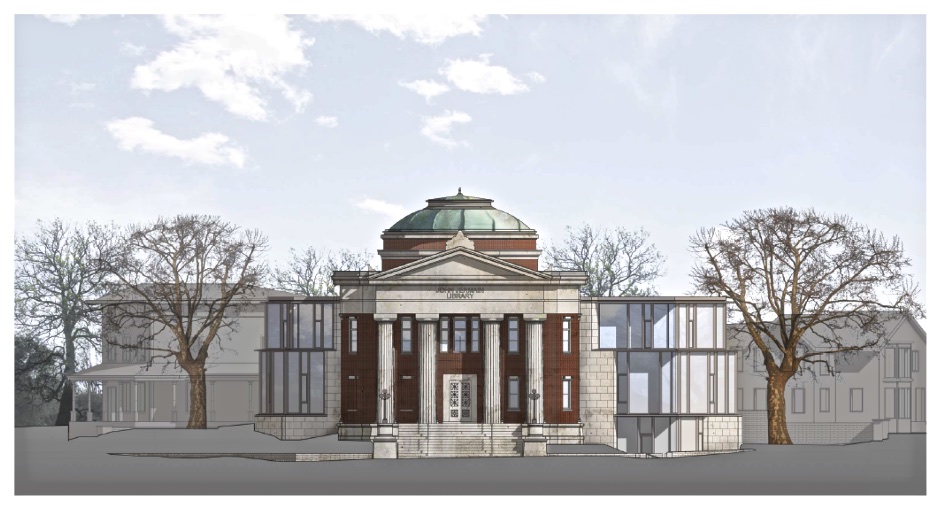
Rendering John Jermain Memorial Library. Newman Architects.
______________________________________________
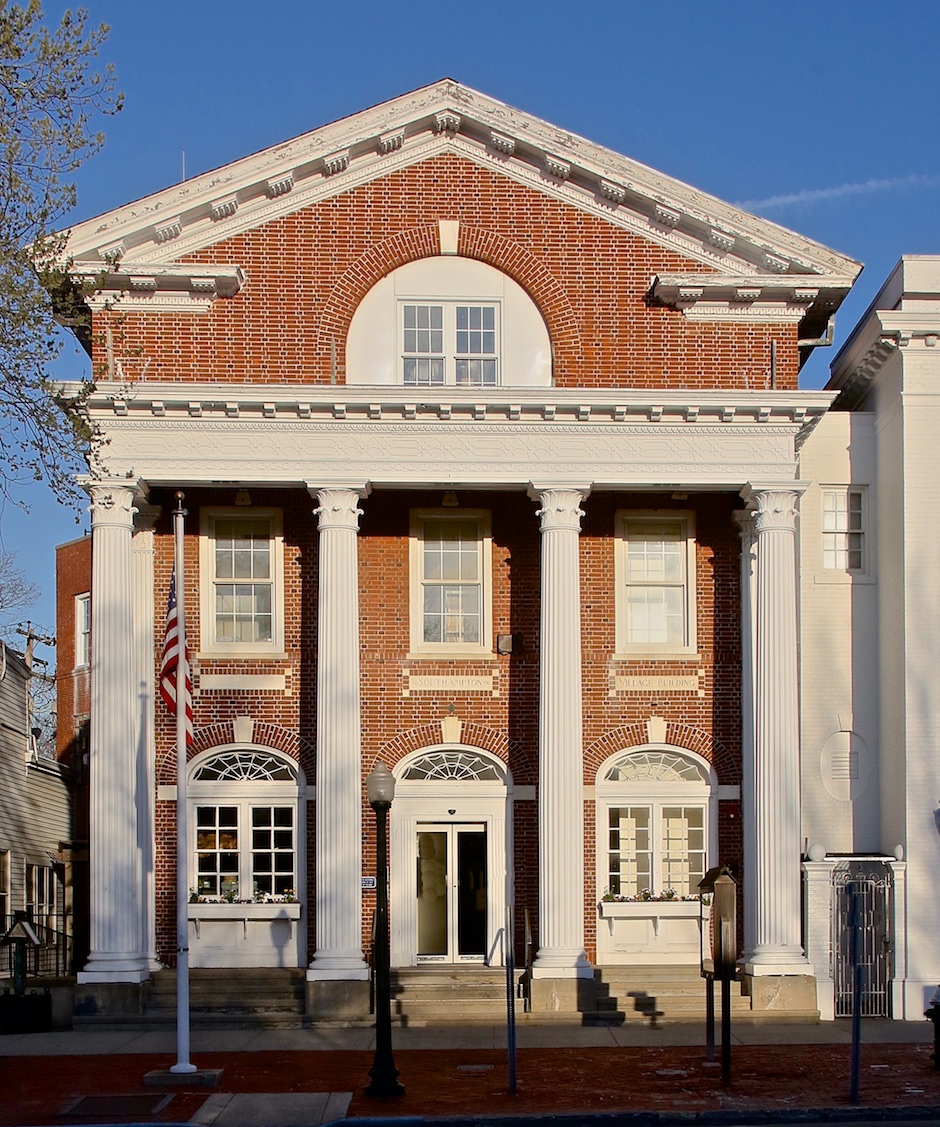
Village Hall / Southampton Post Office, 1910. F. Burrall Hoffman, architect. Donnelly and Corrigan, Builders.
Designed in 1910 by architect F. Burrall Hoffman (1882-1980) and constructed by
contractors Donnelly and Corrigan, Village Hall is a brick, three-story classically inspired municipal building that boasts a two-story portico on the front façade. When first built, Village Hall accommodated the Post Office (first floor) and Telephone Company (basement and third floor) as well as a courtroom, public hall and village offices. Hoffman began his career in the studios of Carrere & Hastings and established his own architectural practice in 1910. His greatest commission is considered Villa Vizcaya, the winter home of industrialist James Deering in Miami, Florida, designed in collaboration with interior designer Paul Chalfin. — Historic Division, Southampton Town Clerk.
Historic Division, Southampton Town Clerk
——————————————-
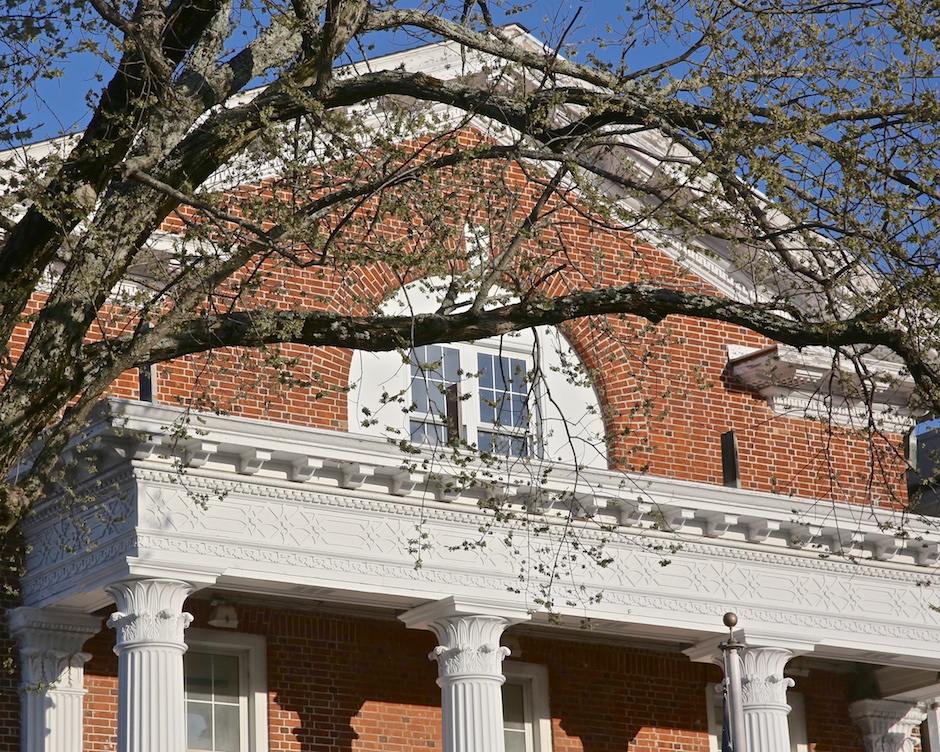
——————————————-
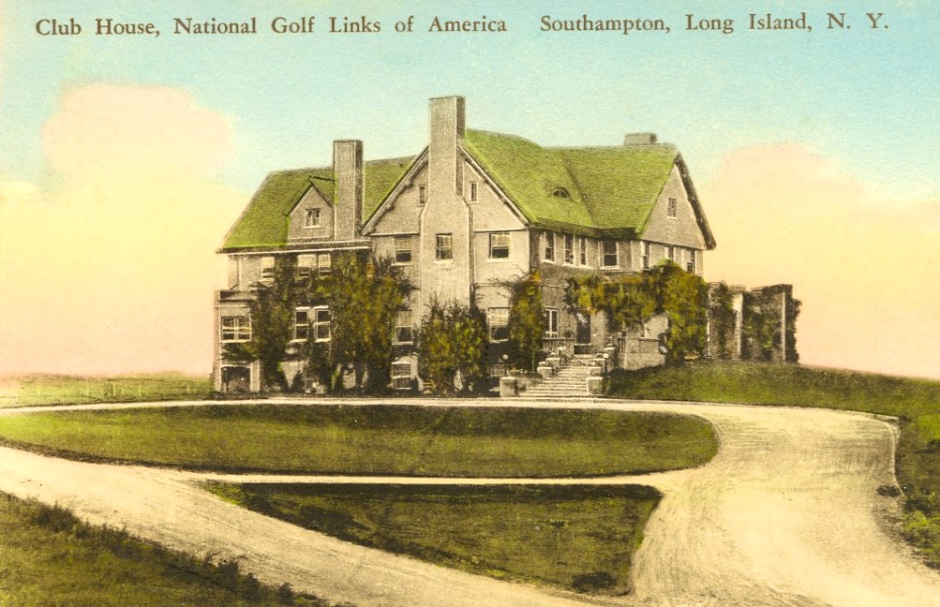
National Golf Links of America, Tuckahoe, 1911, Shinnecock Hills. Jarvis Hunt, Architect. Charles Blair MacDonald, Golf Course Designer.
The National Golf Links of America property contains a clubhouse, entry gates, and golf course. The course was designed by the famous golf course designer, Charles Blair MacDonald, who was schooled at St. Andrews in Scotland. MacDonald began designing this golf course in the late 1890s, and the facility opened in 1911. His intent was to create a course that would rival Shinnecock Hills. The course construction was supervised by local civil engineer Seth Raynor, who went on to design several golf courses independently. Jarvis Hunt designed the large Arts & Crafts-style clubhouse which looks out over Peconic Bay.
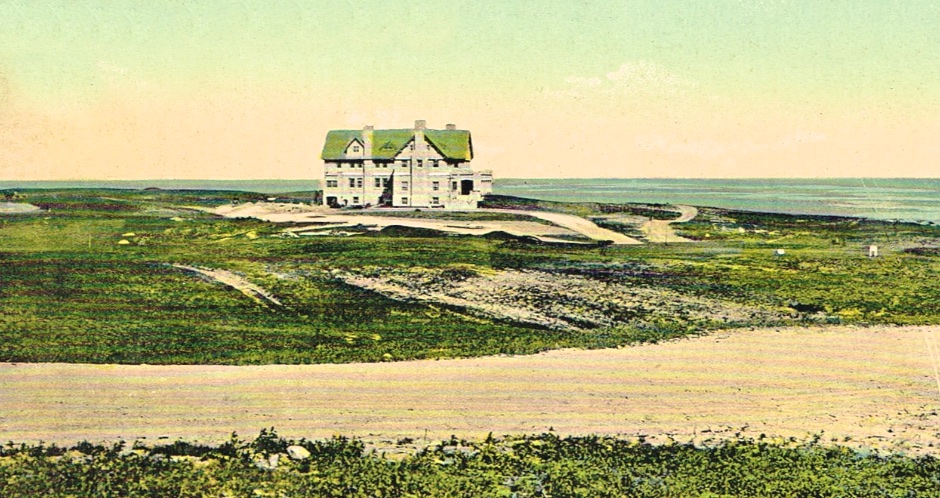
Archival postcards courtesy of the Southampton Historical Museum.
______________________________________________
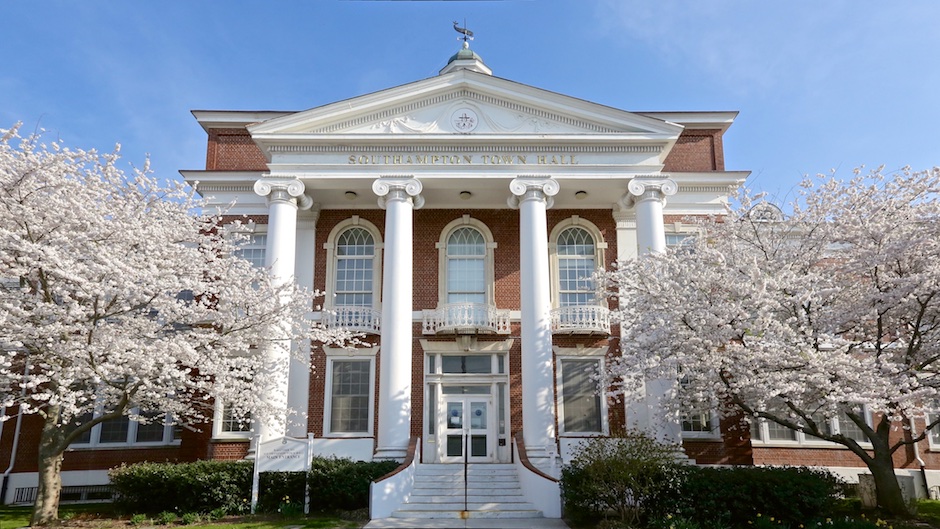
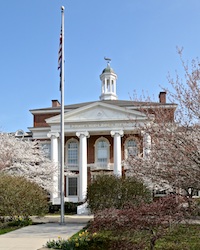
Southampton High School, 1912. Southampton Town Hall today. William Lawrence Bottomley, architect.
Socially prominent architect William Lawrence Bottomley (1883-1951), known for many Long Island estate houses and the second Canoe Place Inn in Hampton Bays, won a national competition to design the Southampton High School in 1912. The school is Georgian Revival in style, combining a three-story pedimented center block beneath a slate-covered hipped roof with side wings of two stories featuring grouped windows and half-circular attic dormers. A tall cupola crowns the central block. The auditorium was added in 1926 (William A. LaFon, Jr., architect). Today, the school serves as Southampton Town Hall. — Historic Division, Southampton Town Clerk.
Historic Division, Southampton Town Clerk
______________________________________________
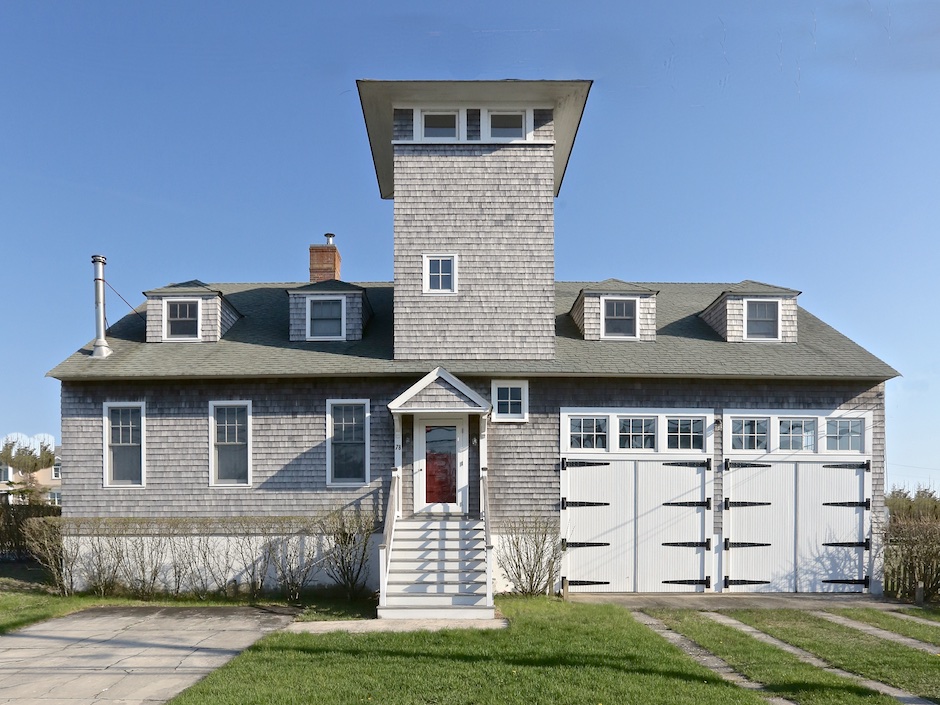
United States Life Saving Station, 1912, Quogue
The former United States Life Saving Station constructed in 1912 has been moved
from the beach and adaptively reused as a residence. The building retains significant original architectural detailing, however, including its look-out tower, attic dormers, and two-door boat shed opening. A “Life Boat House” is identified on historical maps as early as 1873, but the present structure (later moved back from the ocean beach and adapted for use as a residence), was built as part of a program that established life saving stations along the entire coast of Long Island. — Historic Division, Southampton Town Clerk.
Historic Division, Southampton Town Clerk
______________________________________________
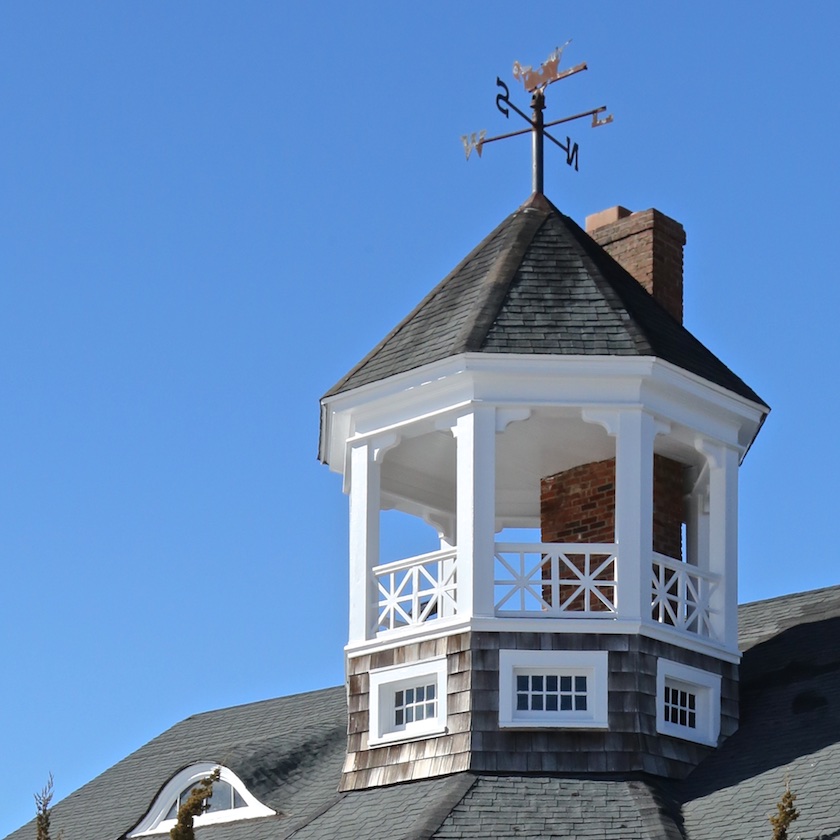
Hayground School, 1912, Bridgehampton.
The Hayground School served the small community of Hayground (most of which is now part of Bridgehampton). The building was used as a school until 1946, then by the Knights of Columbus, and is now an antique shop. The single-story shingle-clad structure with bell tower and elliptical dormers appears much as it did in the early 20th century. — Town of Southampton.
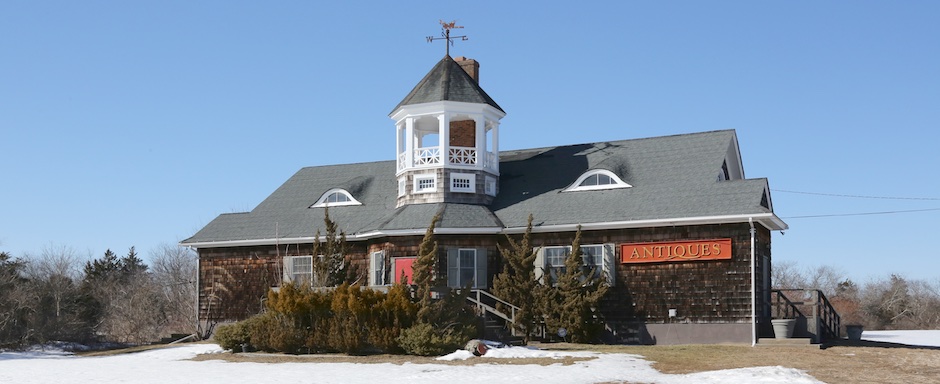
Hayground School, 1912, Bridgehampton
______________________________________________
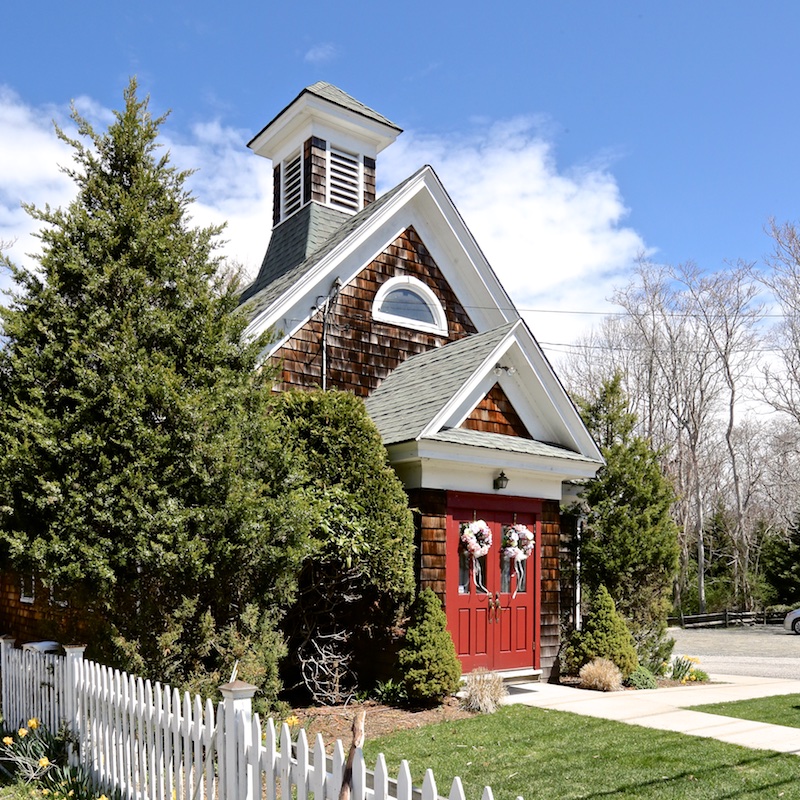
Union Chapel, ca. 1913, Noyac
Union Chapel, ca.1913, is a wood shingle-clad chapel with a pyramidal roofed belfry, a round-arch gable window, and a gable-roofed entry porch. The windows appear to contain six-over-one-light sash. Mrs. Russell Sage financed the construction of this chapel. — Town of Southampton.
______________________________________________

Ballyshear, 1913, Tuckahoe. Residence of Charles Blair Macdonald and Frances Porter Macdonald. F. Burrall Hoffman Jr., Architect. Rose Standish Nichols, garden designer and Annette Hoyt Flanders, landscape architect.
Architect Hoffman‘s design vocabulary of well-proportioned window casings, substantial brickwork, and parapet with balustrades displays discipline and judicious use of detail rare in neo-Georgian houses of the period. Despite its four-story height, the building retains an intimate scale. Its steeply pitched, hipped roof combines the third story and attic space into a single unit almost equal in height to the two stories beneath it. Indiana limestone banding between the first and second floors, a stone cap along the full length of the balustraded terrace…reinforce the compositions horizontal aspect…Hoffman employs quoins articulated in brick to neutralize the vertical elements at the corners. Again, he underplays the verticality of the structure by slightly indenting the flat-roofed end wings of the house. — Anne Surchin, Houses of the Hamptons / Acanthus Press, co-authored with Gary Lawrance.
AAQ / Resource / Education / Books — Click Here.
______________________________________________
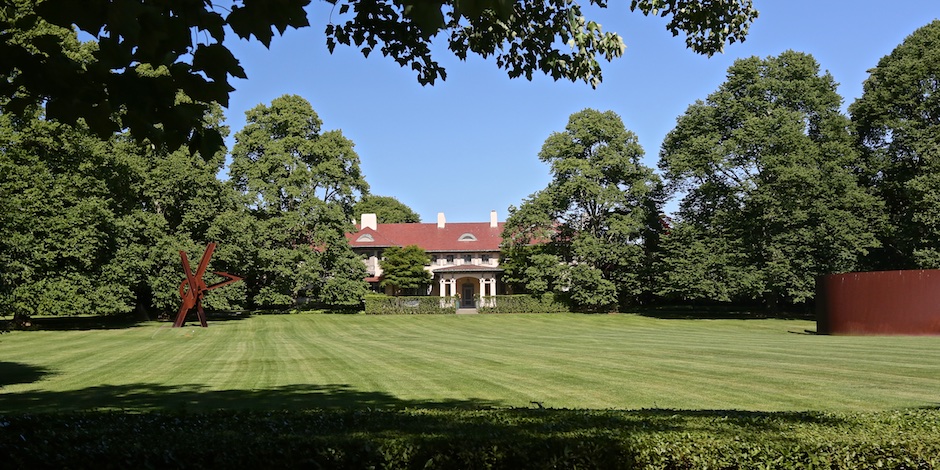
John and Katherine Berwind’s Minden, 1913, Bridgehampton
The Berwind Estate, originally called Minden, is a large Italian villa-style mansion with complex low-pitched hipped roofs with overhanging eaves. The stucco-clad structure has segmental-arch windows and arcaded hip-roofed porches. It is situated on a rise within extensive grounds. The property was developed in 1913 as a summer estate for John and Katherine Berwind. It has since been used as a retreat, a spa, and a private residence. — Town of Southampton.
—————-
John E. Berwind was one of four brothers who established one of the largest bituminous coal companies in the world, Berwind-White Coal Co., supplier to the US Navy and the Cunard Line. Born of Prussian immigrants in Philadelphia, the Berwind brothers had, by the 1880s, amassed a fortune comparable to the Morgans, Vanderbilts, and Astors. — Julie Green: Bridgehampton’s Summer Colony / Images of America Series / Arcadia Publishing.
______________________________________________

Carl Zeh’s Auto & Truck Repair, c. 1915, Water Mill
Carl Zeh’s Auto & Truck Repair was built ca. 1915. It is an early example of an auto repair garage, constructed of concrete with fifteen-light fixed sash windows and a small vented cupola on the top of the roof ridge. An early sign survives, attached to the roof. Two garage doors are modern but probably occupy original garage doorways. — Town of Southampton.
______________________________________________
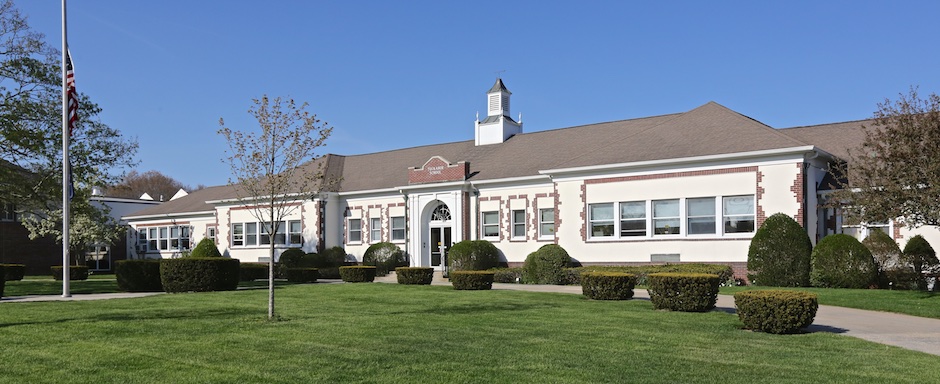
Tuckahoe Common School, early 20th Century
The Tuckahoe Common School is a single story masonry building designed in the Colonial Revival style, and likely dating to the early 20th century. Irregular projecting brickwork surrounds the windows contrasting with the stucco-parged exterior to create a rusticated appearance. The central doorway is surmounted by a round-arch window. A cupola surmounts the building. The appearance of the building has been altered through the replacement of the original windows with smaller retrofits, requiring the additional space to be sealed and filled. — Town of Southampton.
______________________________________________
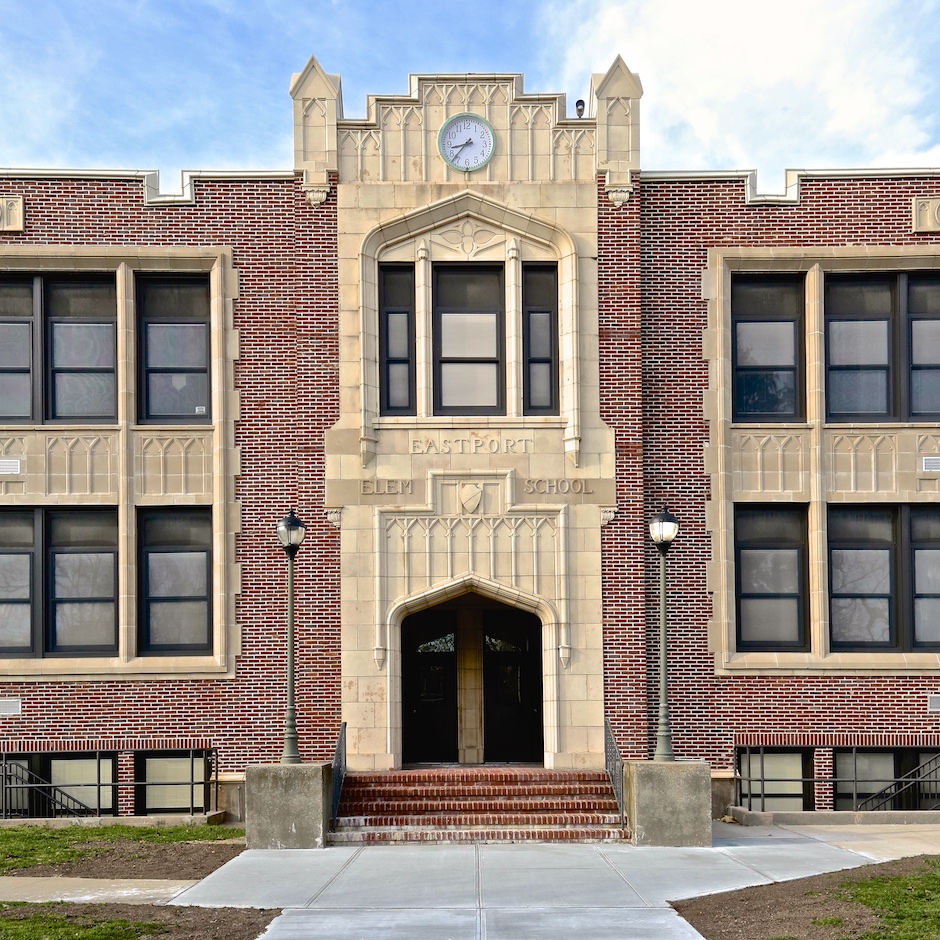
Eastport School, early 20th century.
The Eastport School is a horizontally oriented, two-story brick building designed in a stylized early 20th century manifestation of the Collegiate Gothic style. The symmetrical façade is divided into five sections, the center section distinguished with a cast stone treatment featuring a decorated entryway surmounted by a pointed arch window, and a pair of turrets flanking a clock. The building has a crenellated parapet. — Town of Southampton.
______________________________________________

______________________________________________
Art & Architecture Quarterly / East End thanks the following individuals and organizations that provided images & information in the preparation of these portfolios:
Mary Cummings, Archivist, Southampton Historical Museum for archival photos, postcards & information, and author of Southampton / Images of America Series / Arcadia Publishing.
Zach Studenroth, Town Historian, Historic Division, Southampton Town Clerk for Walking & Driving Tour Guides prepared in celebration of the Town of Southampton’s 375th Anniversary.
Julie Greene, Collections Manager/Curator/Archivist at the Bridghampton Historical Museum, and author of Bridgehampton’s Summer Colony / Images of America Series / Arcadia Publishing.
Sally Spanburgh, Chairperson of the Town of Southampton Landmarks and Historic Districts Board, and author of The Southampton Cottages of Gin Lane / The History Press
Anne Surchin, Houses of the Hamptons / Acanthus Press, co-authored with Gary Lawrance.
The Remsenburg Association, A History of Remsenburg
Town of Southampton / Historic Resources Survey Prepared by AKRF, 2014
As well as, Stephanie Davis, Marsha Kenny, Leigh Phillips and Eric Woodward.
———————–
AAQ / Resource / Education, Books — Click Here.
Historic Division, Southampton Town Clerk
————————————————
Organizations
Bridgehampton Historical Museum
Westhampton Beach Historical Society
As well as, the Town of Southampton and the Historic Division / Southampton Town Clerk.
————————————————-
All photographs, except archival photographs and postcards, copyright Jeff Heatley.
————————————————-
Visit these AAQ Portfolios:
Southampton Town, 1640 / 1776: Settlement & Colonial Periods
Southampton Town, 1777 / 1865: Early Republic & Economic Expansion
Southampton Town, 1916 / 2016: Modern Era
______________________________________________
